Early Views of Glendale
| Historical Photos of Early Glendale |
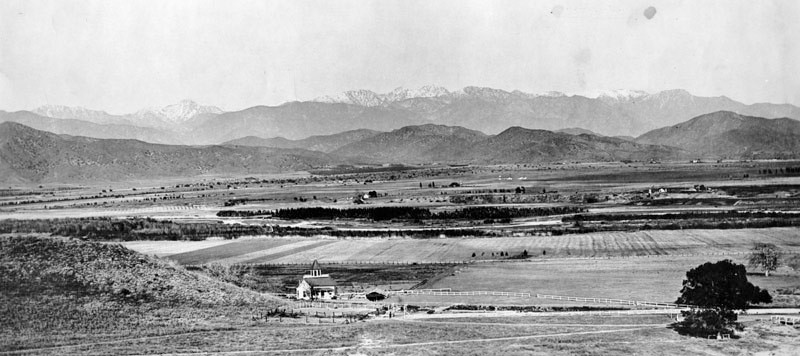 |
|
| (ca. 1880s)^ - Panoramic view from Griffith Park of the site of the later city of Glendale as it appeared sometime between the partition of the great San Rafael Rancho in 1870 and the founding of the town in the middle eighties. The Verdugo Hills and San Gabriel Mountains are seen in background. |
Historical Notes The area was long inhabited by the Tongva people (or "People of the Earth"), who were later renamed the Gabrieleños by the Spanish missionaries, after the nearby Mission San Gabriel Arcángel. In 1798, José María Verdugo, a corporal in the Spanish army from Baja California, received the Rancho San Rafael from Governor Diego de Borica, formalizing his possession and use of land on which he had been grazing livestock and farming since 1784. Rancho San Rafael was a Spanish concession, of which 25 were made in California. Unlike the later Mexican land grants, the concessions were similar to grazing permits, with the title remaining with the Spanish crown. |
 |
|
| (ca. 1900)^ - Panoramic view of Glendale looking northeast toward the Verdugo Hills. Only a few houses are seen. |
Historical Notes In 1860, José María Verdugo's grandson, Teodoro Verdugo, built the Verdugo Adobe, which is the oldest building in Glendale. The property is the location of the Oak of Peace, where early Californio leaders including Pio Pico met in 1847 and decided to surrender to Lieutenant Colonel John C. Frémont. Verdugo's descendants sold the ranch in various parcels, some of which are included in present-day Atwater Village, Eagle Rock, and Highland Park neighborhoods of Los Angeles. |
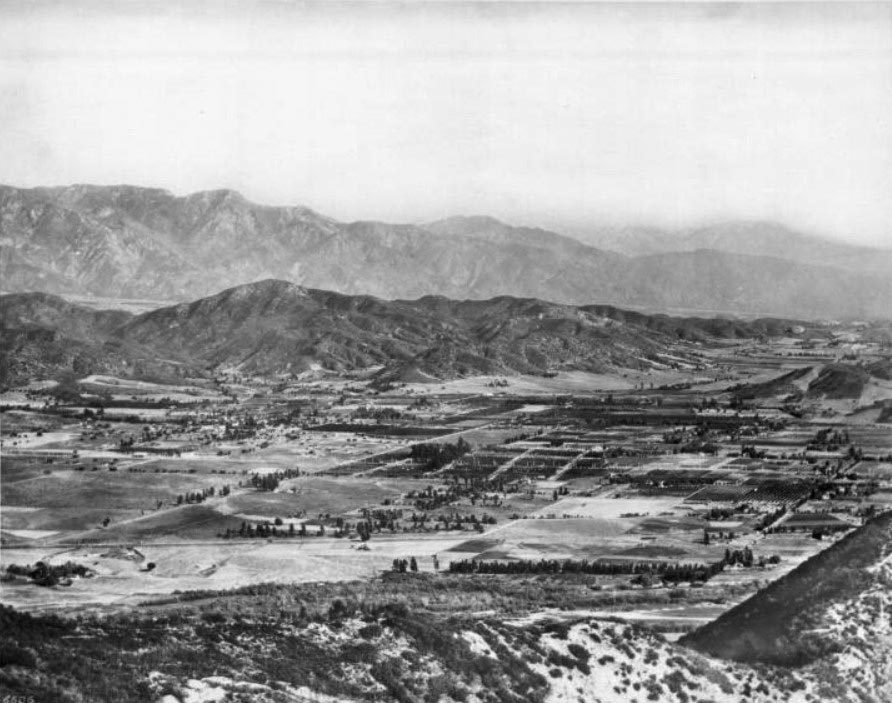 |
|
| (ca. 1904)^ – Panoramic view of Glendale and Eagle Rock from the hills to the west, looking northeast. Two rows of mountains stripe the background (San Gabriel Mtns. and Verdugo Hills), enclosing the town below in a valley between them and the hills. Residences are spaced far apart. |
Historical Notes In 1884, residents gathered to form a townsite and chose the name "Glendale" (it was bounded by First Street (now Lexington Drive) on the north, Fifth Street (now Harvard Street) on the south, Central Avenue on the west, and the Childs Tract on the east). Residents to the southwest formed "Tropico" in 1887. Residence to the north lived in the Casa Verdugo community. Glendale incorporated in 1906 and annexed Tropico 12 years later, in 1918. In March of 1926, a vote for annexation passed and Casa Verdugo also became a part of the city of Glendale. |
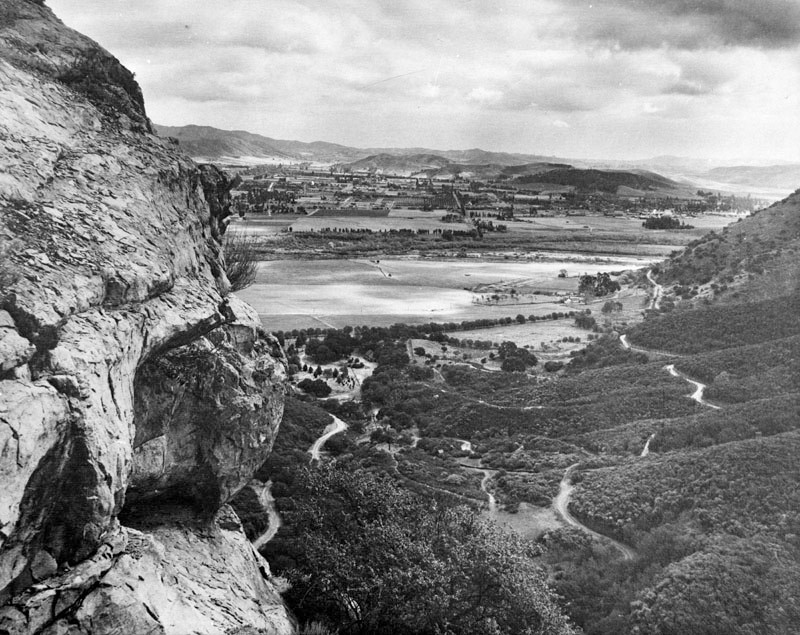 |
|
| (1924)* - Panoramic view of South Glendale as seen from Bee Rock in Griffith Park. |
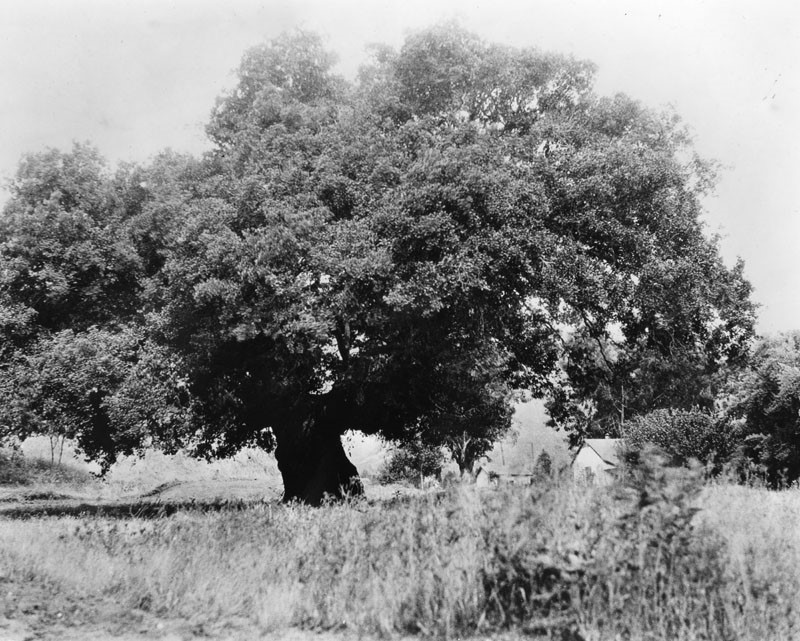 |
|
| (ca. 1900)^ - View showing an oak tree (‘The Oak of Peace’) at the Catalina Verdugo adobe in Glendale which was General Andres Pico's camp site before he surrendered to General John C. Fremont. |
Historical Notes Here was drafted the Treaty of Cahuenga on January 12, 1847, signed the following day in Cahuenga Pass. When the home was owned by Dr. and Mrs. Ernest G. Bashor, they named it "El Roble de la Paz" ('The Oak of Peace'). Although the tree died from natural causes in 1987, remnants can still be seen at its original site. |
Casa Verdugo Restaurant
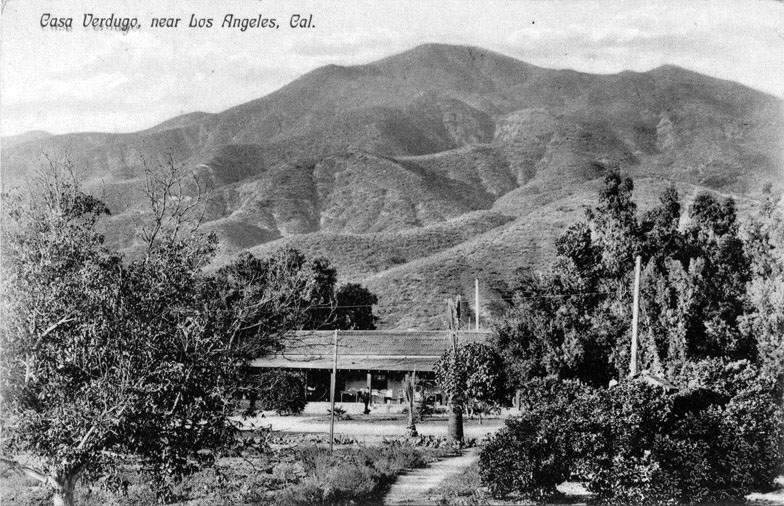 |
|
| (ca. 1905)* – Postcard view showing the Casa Verdugo (orignally Sepulveda adobe) shortly after it was converted into a restaurant. The Verdugo Mountain are seen in the background. |
Historical Notes The adobe had previously been the home of Fernando Sepulveda and his wife, Rafaela Verdugo de Sepulveda, whose father had owned the vast Rancho San Rafael. The restaurant was originally to have been called La Ramada (“The Arbor") but soon became known as Casa Verdugo after a Los Angeles reporter incorrectly identified the Adobe as the home of Teodoro Verdugo, Rafaela's nephew. The name stuck, Casa Verdugo opened on January 21, 1905, and the restaurant was an immediate success.^ |
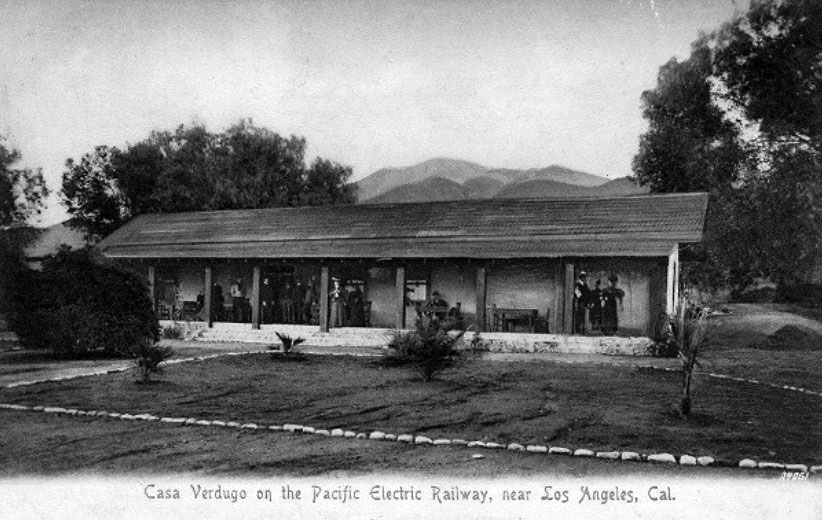 |
|
| (1905)^ – Postcard view showing the original Casa Verdugo Restaurant the year it opened. |
Historical Notes Leslie C. Brand and Henry E. Huntington purchased hundreds of acres of what had been the famous and vast Rancho San Rafael which included the Casa Verdugo adobe. They decided to remake the old house into a tourist destination in the form of a restaurant specializing in Spanish dishes intended to delight the tourists and give them a real “taste” of old California in the most literal sense of the word.^ |
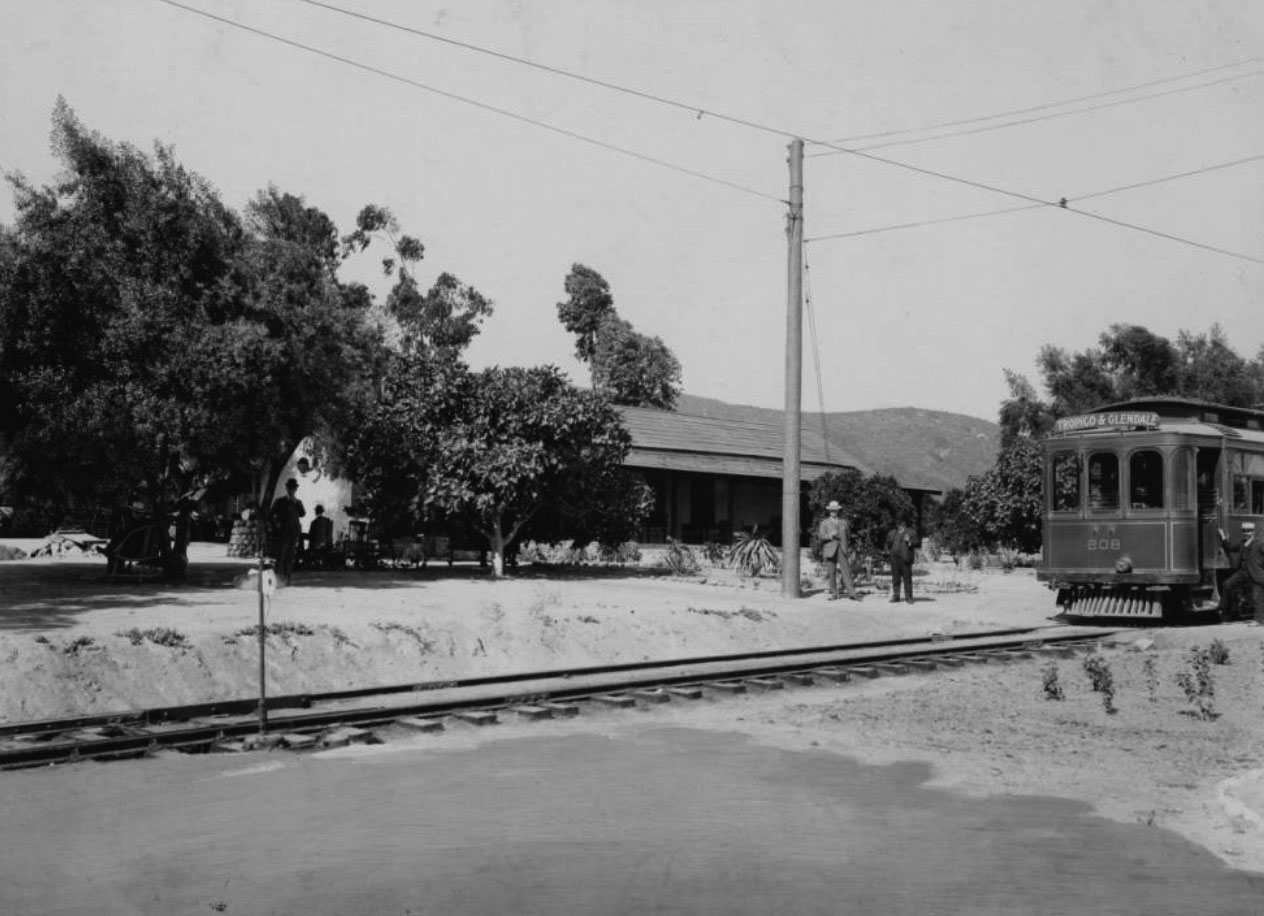 |
|
| (ca. 1905)^ – View showing a "Tropico & Glendale" electric streetcar outside Casa Verdugo adobe in Glendale. The conductor stands outside of his electric car on the right with the tracks in front of him leading to the left foreground. Two more men stand next to an electrical pole at center while others sit under the shade of trees at left. The adobe can be seen through the trees. |
Historical Notes In 1905, the Casa Verdugo restaurant opened in the Sepulveda Adobe, operated by Piedad Yorba Sowl. Brand and Huntington recruited Mrs. Sowl due to her experience in the restaurant industry. Her first restaurant, El Famoso, also served authentic dishes of Mexican origin. The restaurant capitalized on the romanticized image of Old California that became widely popular during the late 19th century. Casa Verdugo quickly became an early tourist attraction in Glendale as evidenced by local ads and postcards of the restaurant. The area around it became a popular destination as evidenced by the growth of the population of Casa Verdugo area in 1910 from 1,200 to 1,500 persons.* To make the old adobe accessible to the tourists, Huntington arranged for his Pacific Electric Railway to extend up Brand Boulevard, adding a terminus station at the entrance to the restaurant and its surrounding park, which was named “Casa Verdugo” in honor of Maria Sepulveda’s great-grandfather, Jose Maria Verdugo, the original “Don” of Rancho San Rafael. |
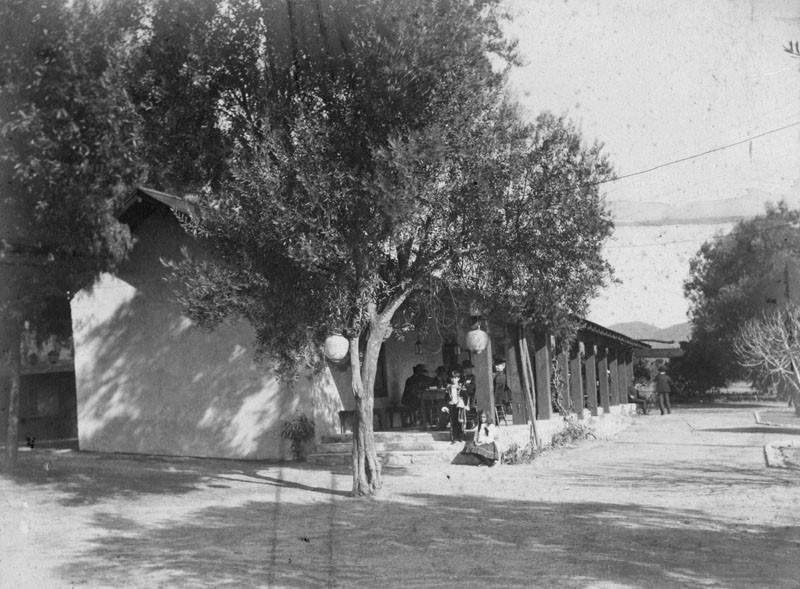 |
|
| (ca. 1905)^ – View showing the Casa Verdugo Restaurant behind a couple of pepper trees. Several people can be seen sitting at a table. |
Historical Notes Surrounded by pepper trees and other mature vegetation, the picturesque old adobe had a commanding vista towards downtown Los Angeles from its wide sheltering corridor that ran the entire length of the long narrow facade. |
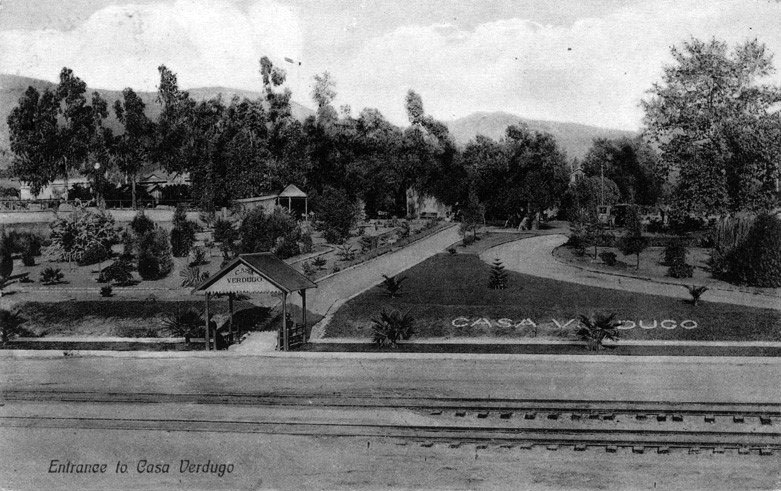 |
|
| (ca. 1905)* - Postcard view of entrance to the Casa Verdugo restaurant in Glendale. Olive trees are seen in background. Railroad tracks are seen in foreground. |
Historical Notes Huntington and his development syndicate expended thousands not only on the adobe itself, but in transforming the surrounding acres into a lush park with meandering pathways winding their way around exotic plantings including varieties of cacti and a fragrant grove of oranges that was intended to represent the type of gardens found in the old California days.^ |
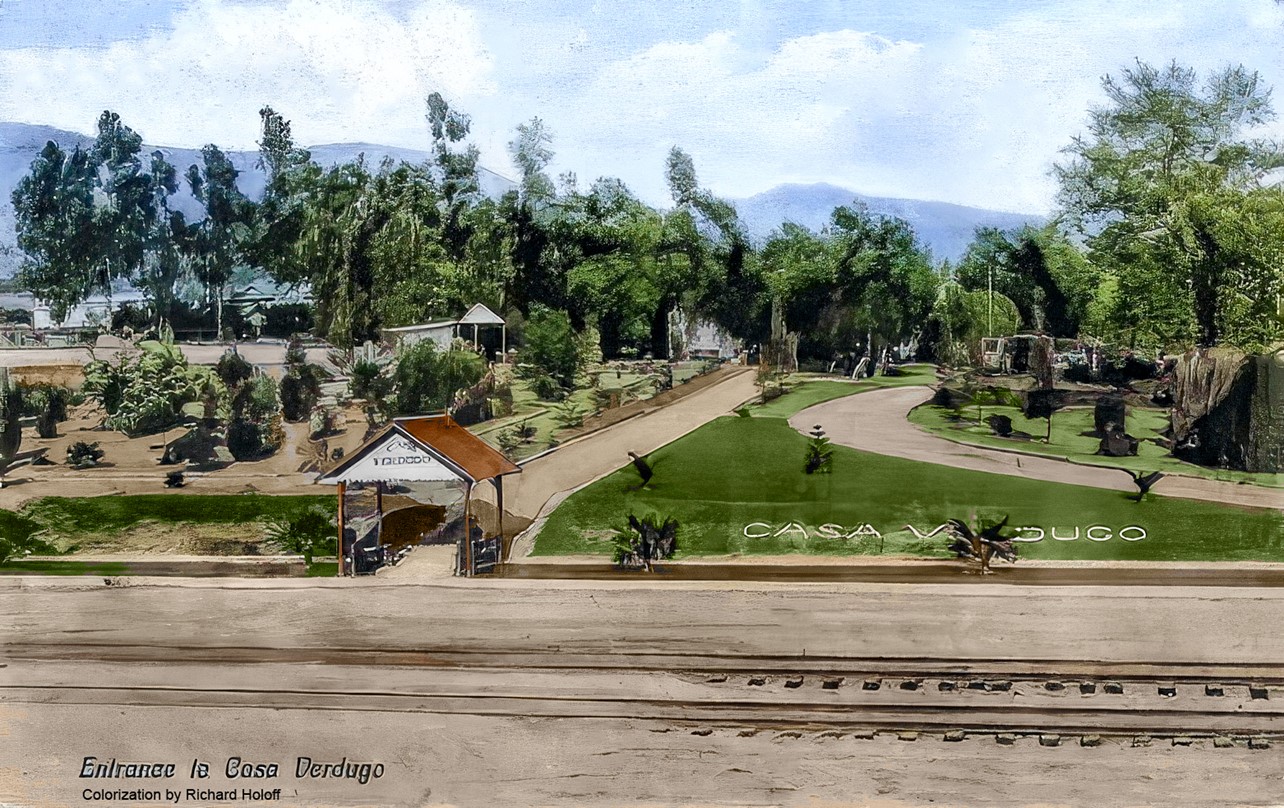 |
|
| (ca. 1905)* - Postcard view of entrance to the Casa Verdugo restaurant in Glendale. Olive trees are seen in background. Railroad tracks are seen in foreground. Image enhanced and colorized by Richard Holoff |
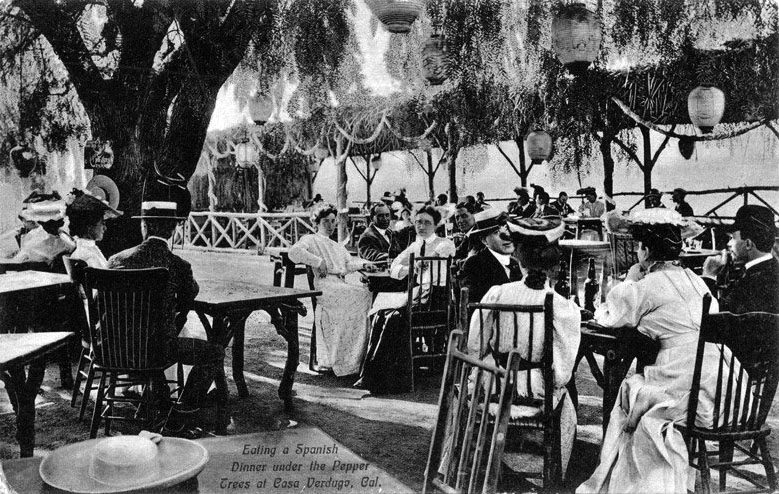 |
|
| (ca. 1905)* - Eating a Spanish dinner under the pepper trees at Casa Verdugo. View of men and women dining outside at the Casa Verdugo restaurant in Glendale. Lanterns are seen hanging above diners. |
Historical Notes From the time of its opening in early 1905, the Casa Verdugo was a big hit. Heavily advertised by the Pacific Electric, the Casa Verdugo rode the crest of the wave of public fascination with the romantic days of California’s Spanish and Mexican past and visitors made their way in droves “Out Glendale way” to partake in a Spanish dinner and stroll about the lush grounds. During its heyday, Casa Verdugo regularly entertained hundreds and sometimes even thousands of visitors at a time including a memorable 1907 Shriners outing that brought 5,000 visiting potentates to the old adobe.^ Within a few years of the restaurant opening a small community had developed and called itself Casa Verdugo after the restaurant. A commercial district grew along Brand Boulevard and Central Avenue, including a department store, groceries, a meat market, hardware store, drug store, the Mission Theatre and a post office where tourists could have their picture postcards of the restaurant postmarked “Casa Verdugo, California.” The droves of tourists, and the postcards they mailed home, helped make Casa Verdugo a well-known destination throughout the country; visitors had to see the missions, the Mt. Lowe Railway, Santa Catalina Island and the famous Casa Verdugo. |
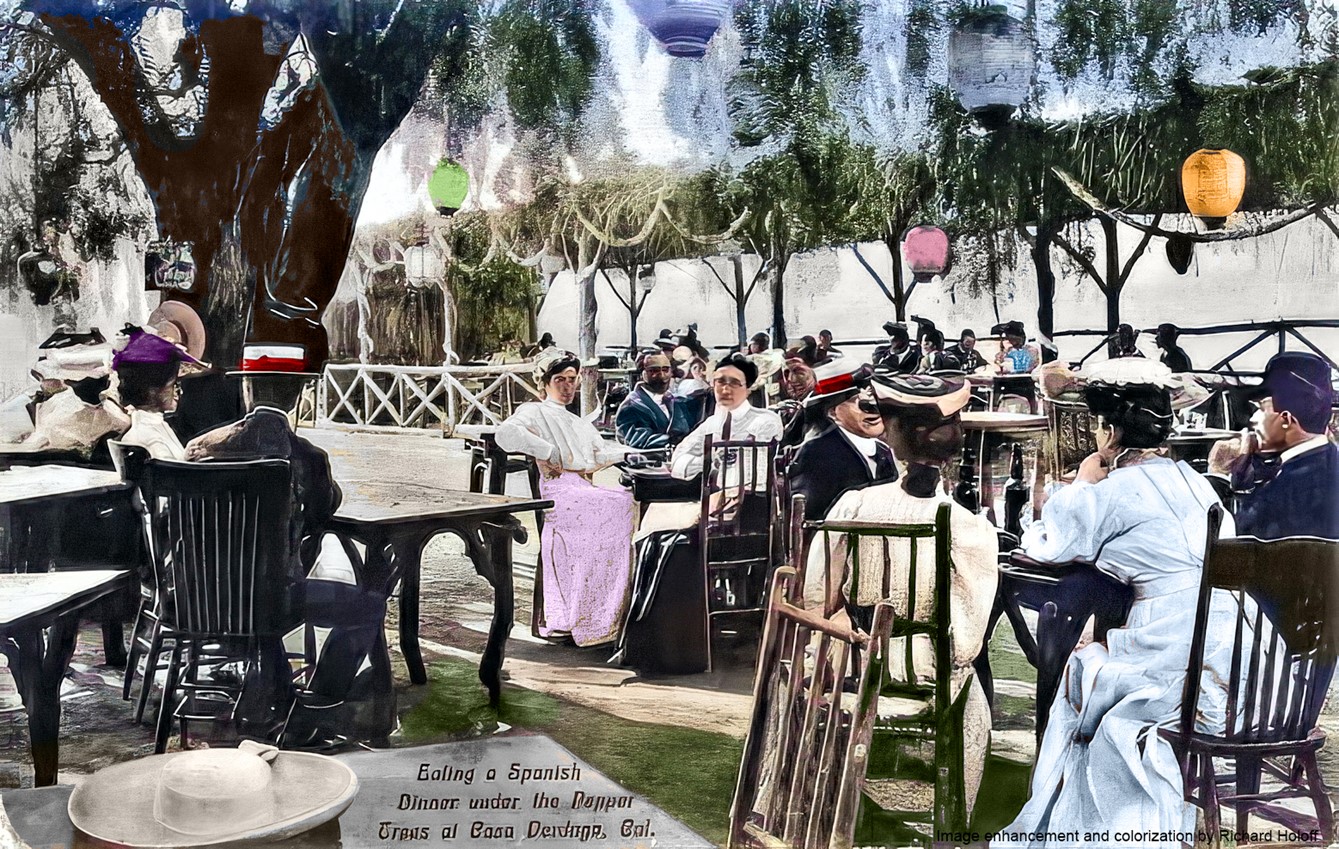 |
|
| (ca. 1905)* - Eating a Spanish dinner under the pepper trees at Casa Verdugo. View of men and women dining outside at the Casa Verdugo restaurant in Glendale. Lanterns are seen hanging above diners. Image enhancement and colorization by Richard Holoff |
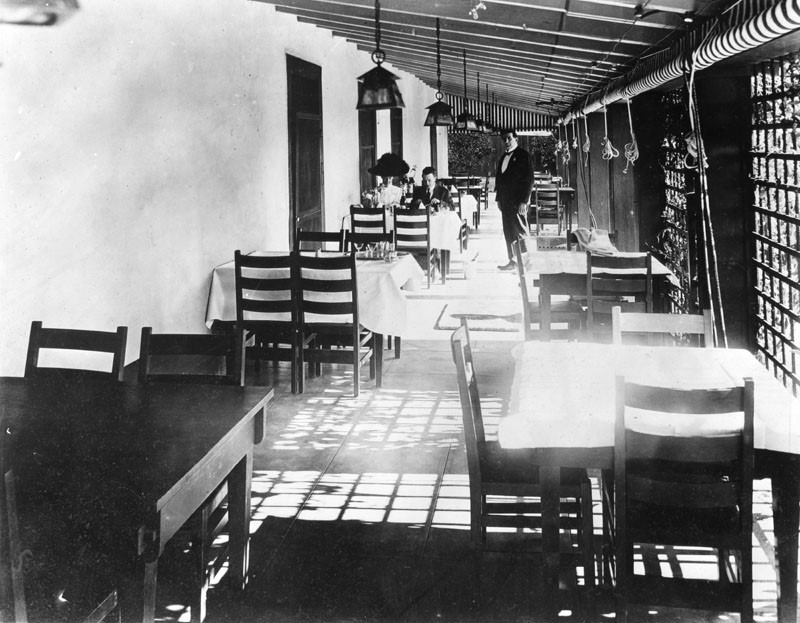 |
|
| (n.d.)* - Diners at the Casa Verdugo Restaurant with a waiter standing nearby. |
Historical Notes Both the food and the setting were real treats. Diners could enjoy their peppery selections in a variety of inviting locations, from the fireplace-warmed main sala with its thick adobe walls and old beamed ceiling festooned with strings of red peppers to al fresco settings under venerable pepper trees or vine-covered bowers. A most popular spot was, no doubt, the wide veranda where the pleasure of a sunset dinner was enhanced by the heady scent of orange blossoms wafting through the dusky air. Although its setting was charming in the extreme, Casa Verdugo’s true success was the result of its exceptional proprietress, Piedad Yorba de Sowl, whom Huntington and Brand had wisely granted a five-year lease to run the property upon its opening in 1905. Under de Sowl, Casa Verdugo rapidly became a “must do” for anyone visiting Southern California. In 1910, because of a disagreement with de Sowl, the Pacific Electric would not renew her lease and hired another proprietor. de Sowl, however, had both trademarked and copyrighted the name “Casa Verdugo” and now claimed infringement. A nasty court battle followed, which de Sowl decisively won in 1911 and the Pacific Electric was forced to suck lemons and come up with a new name. They ultimately settled on “La Ramada”. de Sowl opened a "New" Casa Verdugo Restaurant in her nearby residence and over the next decade the two restaurants operated side by side in an uneasy truce, but one clearly favored by de Sowl. In evicting de Sowl, the Pacific Electric had naively thought people had come to Casa Verdugo to see a building. They hadn’t. They came for an experience, and de Sowl was the one who provided it.^ On May 1, 1923 the original Casa Verdugo Restaurant (formerly the Sepulveda adobe), located in what is now the 1200 block of North Maryland Avenue, was demolished. |
Casa Verdugo Segunda
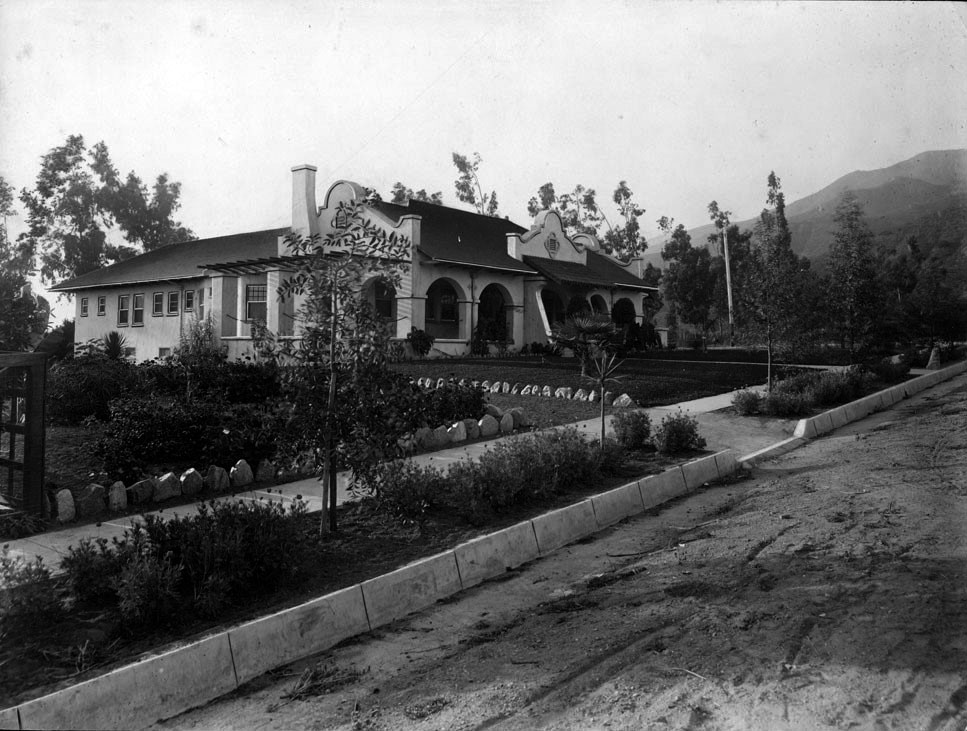 |
|
| (ca. 1907)^^ - View showing the Mission Revival-style home of Piedad Yorba de Sowl before it was transformed into the new Casa Verdugo Restaurant. |
Historical Notes Because of her success at the original Casa Verdugo Restaurant, Senora Piedad Yorba de Sowl and her husband Charles had been granted by a then grateful Pacific Electric the northeast corner of the Casa Verdugo property where, in 1907, they built a beautiful Mission-styled home, which the couple dubbed “Soledad.” In 1910, when de Sowl could not get an extension of her lease at the original Casa Verdugo Restaurant because of a disagreement with Pacific Elelctric, she simply reopened “Casa Verdugo” in her former dwelling, taking the staff and most all of the patrons with her, and which she pointedly advertised as “not the railroad place.” |
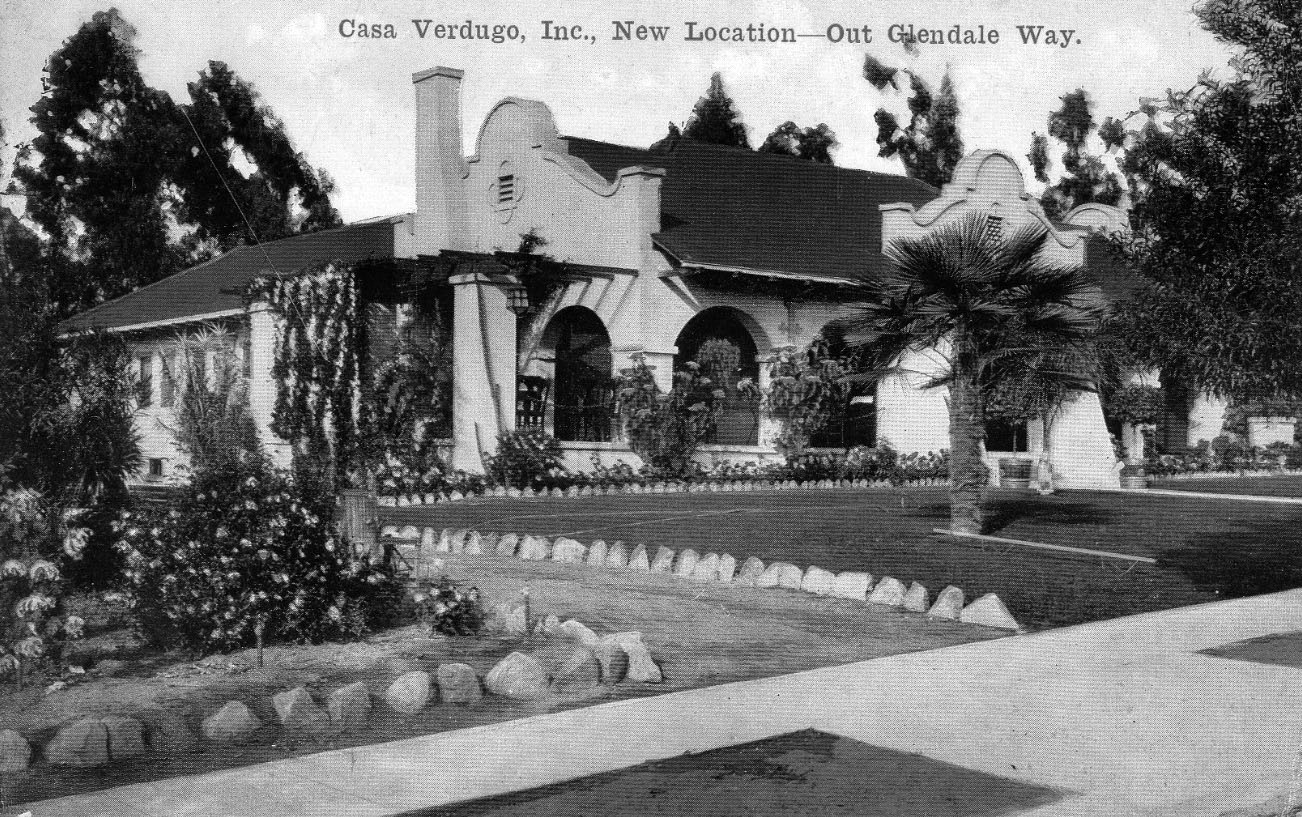 |
|
| (1910)^v^ – "New Location--Out Glendale Way". Postcard view showing the ‘New’ Casa Verdugo Restaurant. |
Historical Notes When Piedad Yorba Sowl moved her restaurant around the corner (literally) after the Pacific Electric Railway declined to renew her lease in 1910, she had a set of postcards printed featuring the new location. This is the first one. |
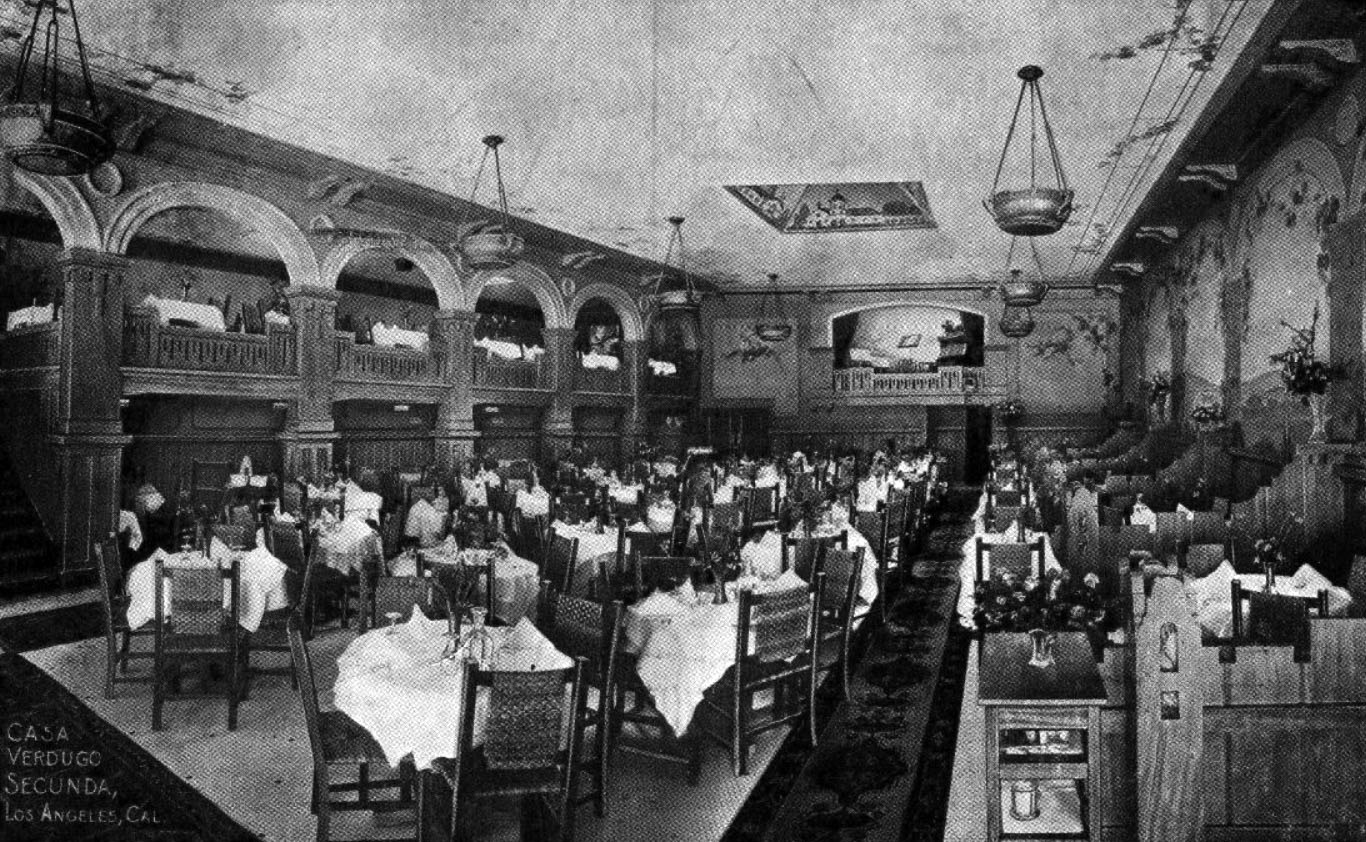 |
|
| (ca. 1914)** – Postcard view showing the interior dining area of the Casa Verdugo Segunda. |
Historical Notes Piedad Yoba de Sowl’s new Casa Verdugo brought the same charms that were so successful to Casa Verdugo vieja. As before, diners could choose indoor or al fresco dining. Those choosing indoor seating had their choice of a series of charming spaces, each with its own unique name and personality such as the Indian, the Red or the Green Room. And to make sure diners didn’t have to rely on the hated Pacific Electric to visit the Casa, de Sowl had a beautiful garage constructed, that housed any number of visiting machines in Mission-styled splendor. Piedad Yoba de Sowl was such a success she opened a “Casa Verdugo Segunda” at 736 South Spring Street in 1913 so diners in downtown Los Angeles could enjoy the same style food and service found “Out Glendale Way.” Operating in this location until April of 1921, de Sowl and the Pacific Electric both sold out to a consortium of three school teacher sisters, Ida , Jeannette and Myrtle Baldwin from Dayton, Ohio. The combined transaction for the two properties being described as the largest real estate deal to date in Glendale area for the considerable sum of $100,000. The Casa Verdugo name remained a potent one in L.A. restaurant up into the 1960’s. By that time, however, Piedad Yorba de Sowl had long passed, dying at the age of 84 in 1948. Her former home and restaurant, however, has survived, an accomplishment as remarkable as the woman herself, and remains today a treasured landmark in northern Glendale (1235 North Louise Street at the corner of Randolph).^* Click HERE for contemporary view. |
Casa Adobe de San Rafael
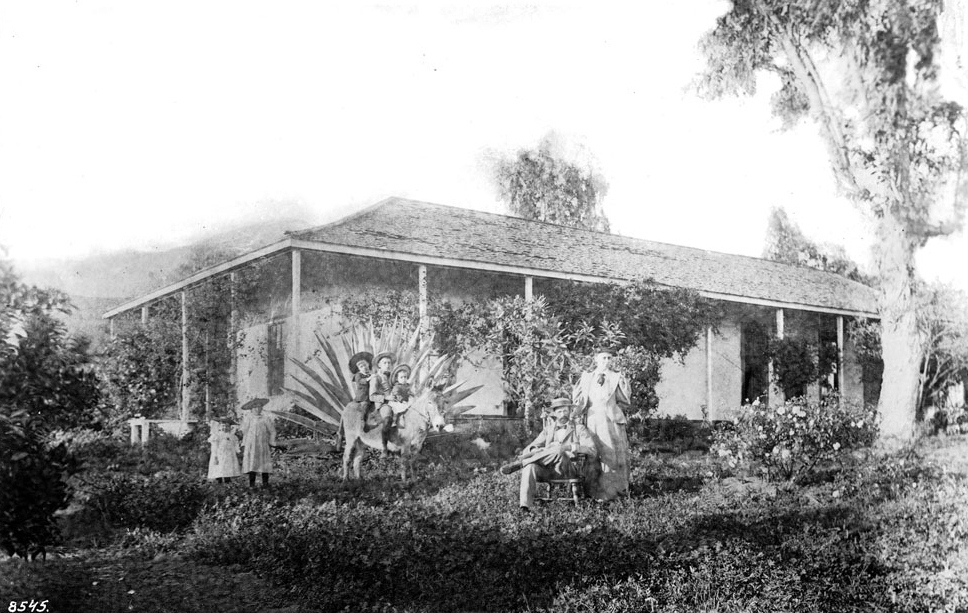 |
|
| (1895)^^ - Photographic portrait of Charels and Nellie Bogue in front of the former home of Tomas Sanchez in Glendale. The one-story adobe, located on the back of the Verdugo Ranch one half-mile west of Brand Boulevard, is shown at center, featuring a wrap-around patio and overhang. In the yard in front, Charles is shown seated to the left with Nellie standing at his side. At center, three boys in bolero dress identified as the children of "Charles and John" sit astride a burro while two girls identified as "Ruth and Helen" are pictured in lightly colored dressed farther left. Sanchez lived at the residence between 1872 and 1875. |
Historical Notes In October 1784, José María Verdugo petitioned Pedro Fages, Governor of Alta California, for a grant of land. This grant was the first and one of the largest made. When parts of Rancho San Rafael were sold, Tomás Sánchez, Sheriff of Los Angeles County, purchased a tract of 100 acres and in 1865 built this artistic adobe of the hacienda type, restored in 1932. |
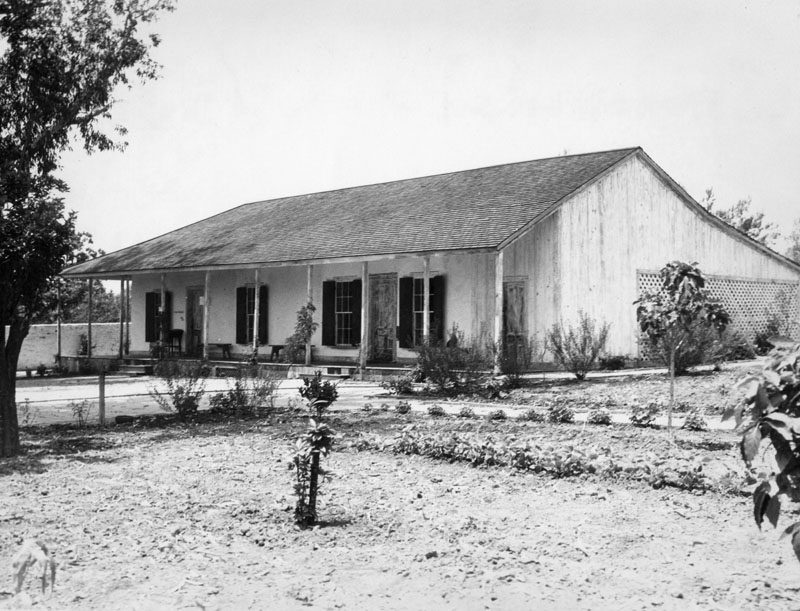 |
|
| (1936)^ - Exterior view of the Tomas Sanchez adobe, La Casa Adobe de San Rafael, Glendale, in June 1936, following restoration in 1932. The photo shows its Monterey-style corridor (covered porch). It was built by Tomas Sanchez, sheriff of L.A. County, in 1849 on Rancho San Rafael land owned by Fernando and Rafaela Verdugo. |
Historical Notes Casa Adobe de San Rafael has been designated a California Historical Monument (No. 235). It is located in a city park and is now furnished with furniture, cooking utensils and other relics of its time. Location:1330 Dorothy Dr, Glendale. |
Glendale Hotel (later Glendale Sanitarium, Glendale Adventist Health Center)
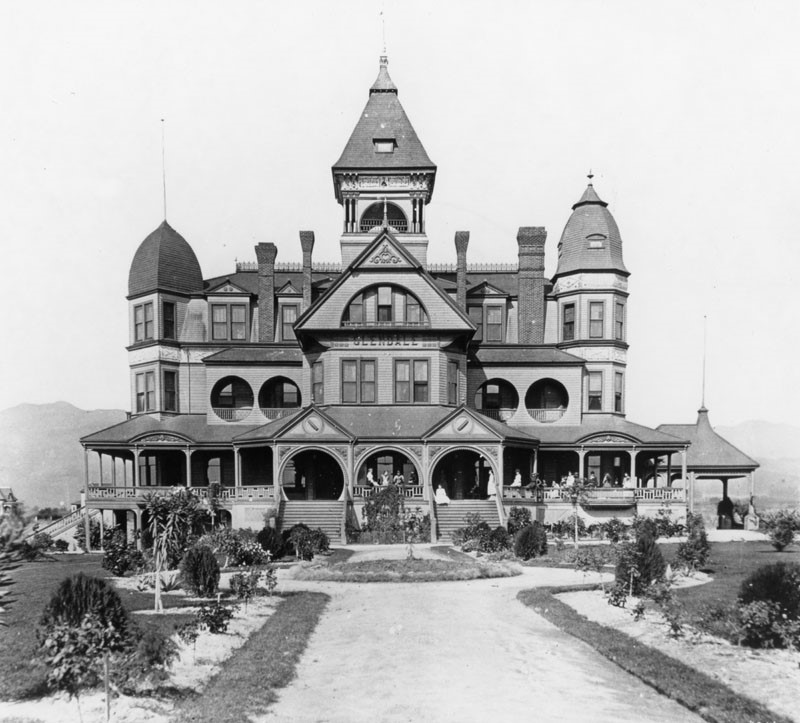 |
|
| (1895)* - View showing the Glendale Hotel, shown here when it was a school for girls. It was located on what is now Broadway Avenue. |
Historical Notes During the area's first little boom, the Hotel Glendale was built at a cost of $60,000 in 1887-1888. It was a grandiose structure, but it didn't even open! The boom busted too fast, and the hotel became a school (St. Hilda's Hall, School for Girls). It later became the Glendale Sanitarium until 1924 when the building was razed.* |
.jpg) |
|
| (1895)* - View showing the Glendale Hotel, shown here when it was a school for girls. It was located on what is now Broadway Avenue. Image enhancement and colorization by Richard Holoff |
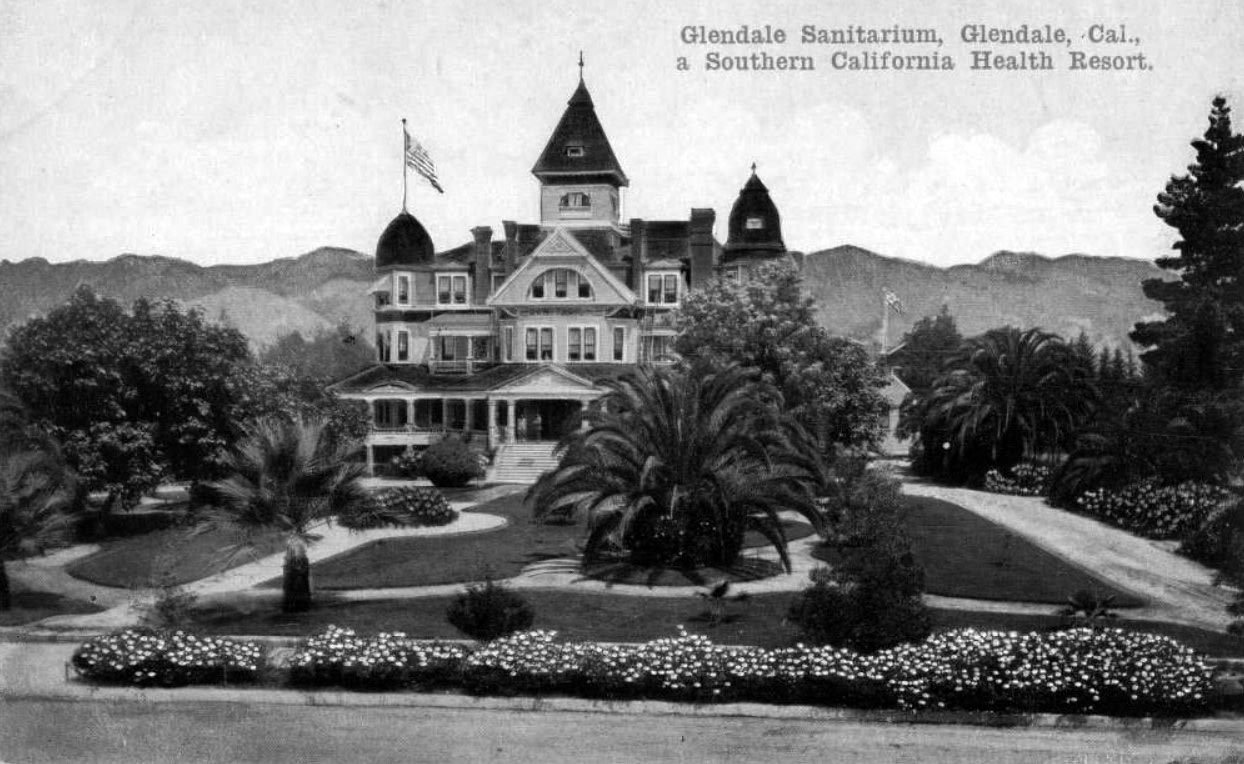 |
|
| (ca. 1910)* – View looking at the Glendale Sanitarium with the Verdugo Mountains in the background. Title reads: “Glendale Sanitarium…a Southern California Health Resort” |
Historical Notes Glendale Sanitarium opened in 1905, a year before Glendale was incorporated as a city. It occupied the beautiful 75-room Victorian structure (Hotel Glendale) and stayed until moving out in 1924 to a new location at 1509 Wilson Terrace. There it evolved into the well-known Glendale Adventist Health Center that exists today. |
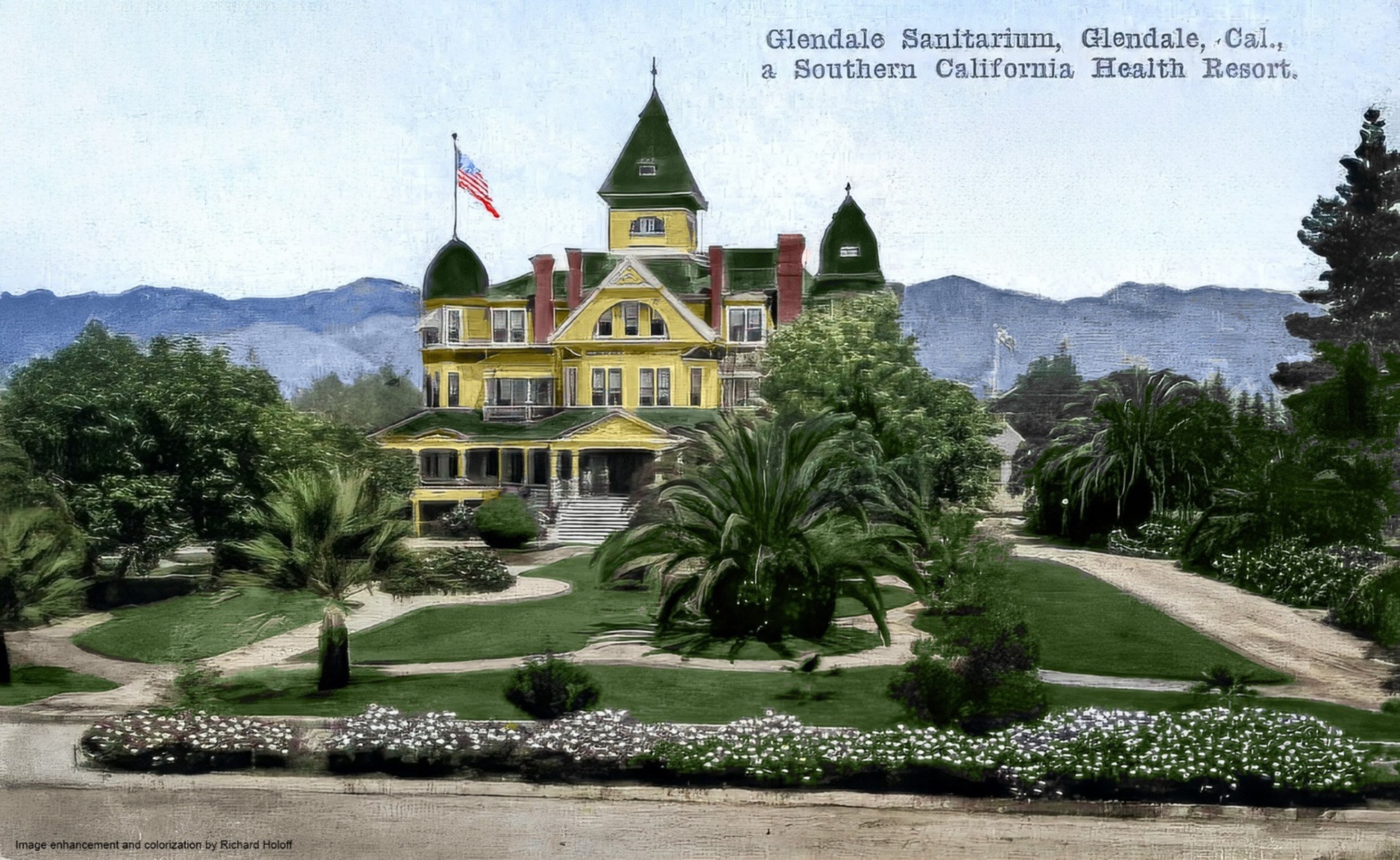 |
|
| (ca. 1910)* – View looking at the Glendale Sanitarium with the Verdugo Mountains in the background. Title reads: “Glendale Sanitarium…a Southern California Health Resort”. Image enhancement and colorization by Richard Holoff |
* * * * * |
Casa Verdugo Community
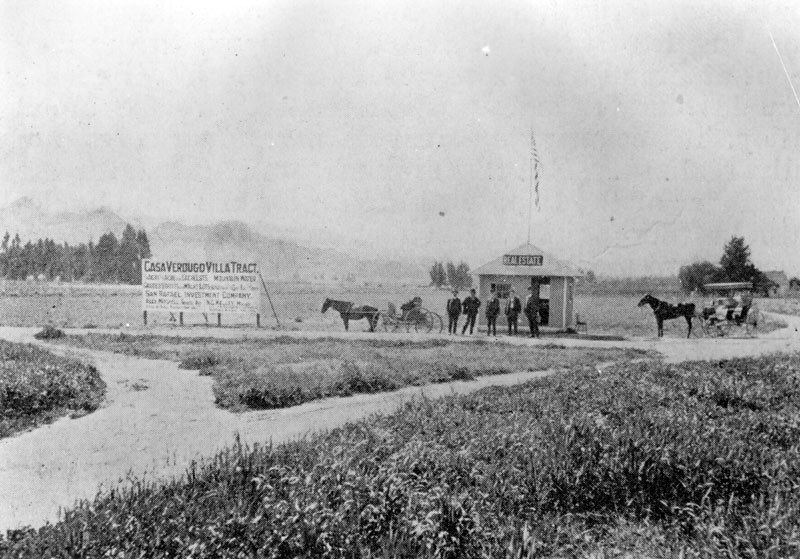 |
|
| (ca. 1900)^ - Panoramic view of a real estate development sign and office, with horses and carriages. The development is called "Casa Verdugo Villa Tract" and is offered by San Rafael Investment Company. |
Historical Notes CCasa Verdugo was originally a part of the Rancho San Rafael land grant that was given to Jose Maria Verdugo in 1784. Verdugo’s granddaughter, Rafaela Verdugo de Sepulveda, subsequently owned the land after the Great Partition in 1871. In 1883 the real estate firm Wicks, Wright, Hodgkins, and Watts purchased 500 acres of land from Valentine Mand, which included the Sepulveda Adobe. A portion of the property was sold to clergyman George Baugh in 1886 who subdivided the tract and lived in the Sepulveda Adobe with his family. In 1900, Baugh sold the property to J.D. Bliss who with the help of his brother operated Bliss Ranch on the property. Finally, in 1903 Leslie Brand, who would become a civic leader in Glendale, purchased Bliss Ranch and 175 acres of surrounding land. In 1904, Brand sold a stake of the tract to Henry Huntington, the owner of the Pacific Electric Railway Company. This resulted in the creation of the Glendale line that ran from downtown Los Angeles to Broadway in Glendale. At the time, the Los Angeles Interurban Railway served as the operator, which was later succeeded by the Pacific Electric Railway. In November 1904, the line was extended a half-mile north along Brand Boulevard to Mountain Street.** |
The 'Red Car' comes to Glendale
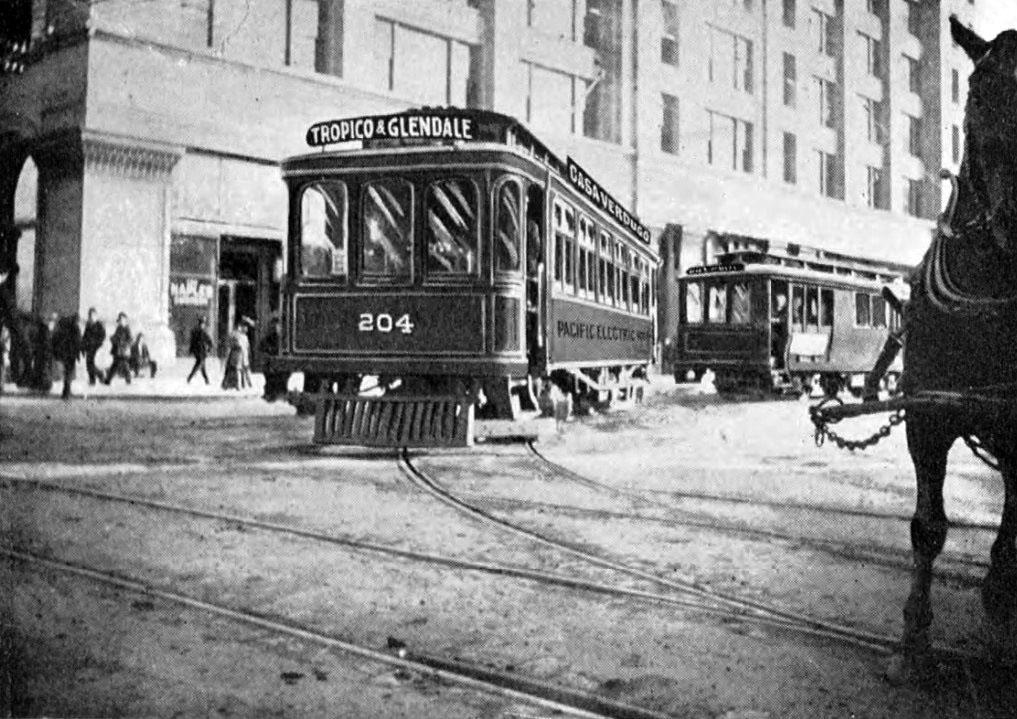 |
|
| (1906)^ - View showing one of the Pullman “Flyers” of the Pacific Electric Railway Co. leaving the grand depot, 6th and Main streets, on one of the regular thirty-three daily trips to Casa Verdugo. Photo was published in a real estate promotional brochure put out by San Rafael Investment Co. |
Historical Notes The Glendale Line was pioneered by L.C. Brand and associates starting in October, 1902, through their corporation, "The Los Angeles & Glendale Electric Railway". On June 29, 1903, Brand received a franchise from the Los Angeles City Council for an electric railway line running from Los Angeles to Glendale. The franchise was soon sold to Henry E. Huntington, owner of Pacific Electric Railway Co., who would bring the "Red Cars" to Glendale by 1904 under the name of Los Angeles Interurban Railway (later changed to Pacific Electric). A 1906 San Rafael Investment Co. and Pacific Electric Railway promotional brochure reads: The fame of this ride, decidedly the most picturesque to any suburb, attracts thousands of tourists, requiring many additional cars on Sundays and holidays, while the hundreds of commuters going daily to and from business and home are rapidly increasing in numbers. The passage through the city, passing Central Park, traversing Figueroa Street, Lake Shore Drive (today, Glendale Blvd.), skirting Echo Park, through Edendale and the Pass between Elysian and Griffith Parks to the point where the most enchanting of all valley panoramas burst upon the view, is accomplished in fifteen minutes. The scene is framed on the north, in ascending order, by the San Rafael hills, Verdugo mountains and the San Gabriel range, showing Mts. Lowe and Wilson in the foreground, while far to the east Mt. Cucamonga’s dome and the other snow-capped peaks of the San Bernardino mountains rising eight thousand and nine thousand feet are discovered. The flight along the borders of Griffith Park, over the trestles spanning Los Angeles River, and through Tropico to the fine depot at Brand Boulevard and Fourth Street (today, Broadway), Glendale occupies but ten minutes. Here, midway the broad valley, its beauties and surpassing advantages are fully realized. But five minutes are required for the remainder of the trip down the center of Brand Boulevard, a thoroughfare 130 feet in width, flanked by seventy-two monoliths, eleven and one-half feet high, capped by electric lights, with the space between the broad cement walks and curbs filled by graceful palms, on to Mountain Avenue. Here at the end of the line is found the choicest residential portion of the valley, at the foothills. This is not a picture of a dissolving view, but one as eternal as the everlasting hills.* |
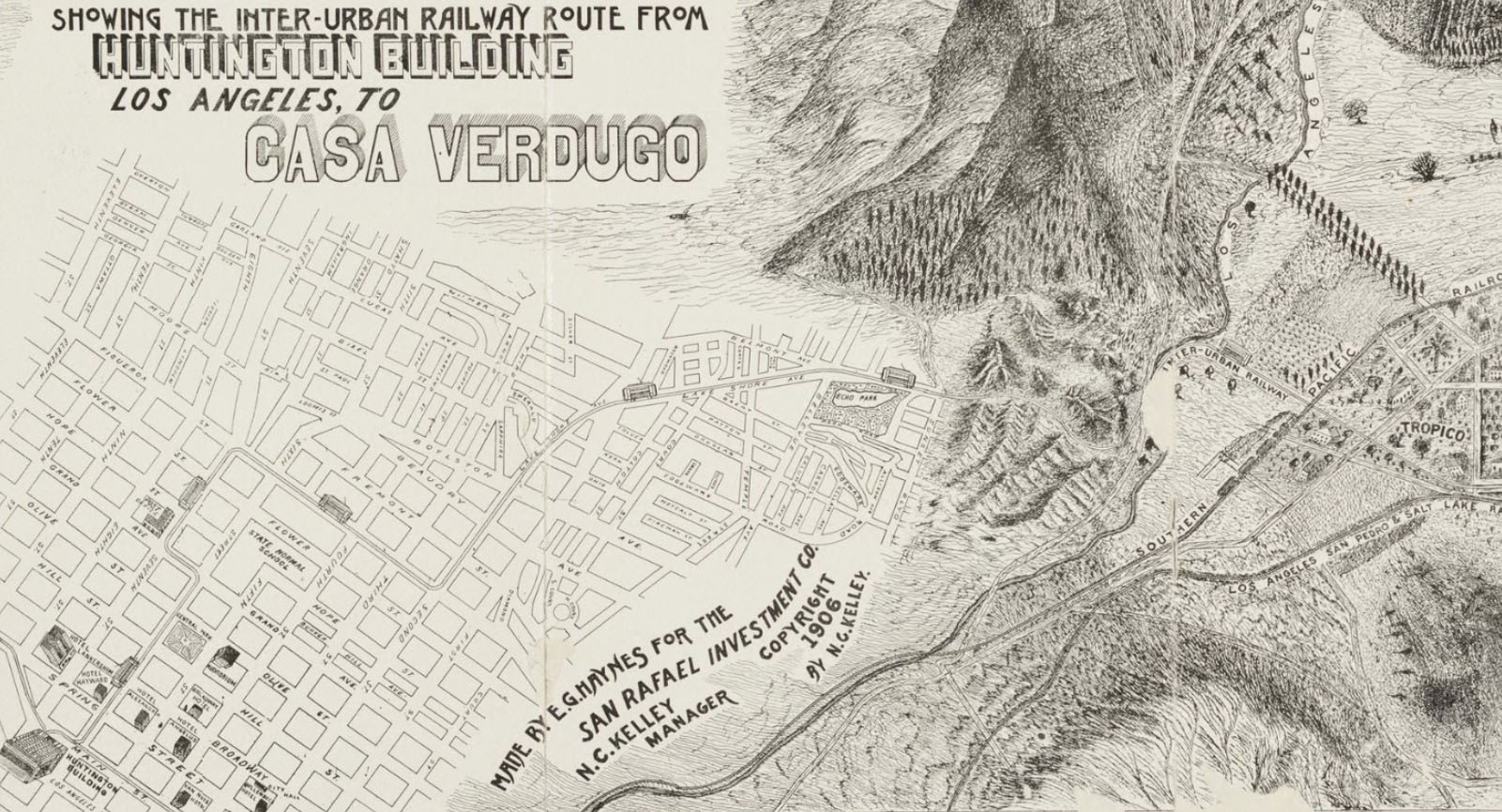 |
|
| (1906)^ – Map showing the Inter-Urban Railway route from the Huntington Building (aka Pacific Electric Building), located at 6th and Main streets, to Casa Verdugo at Brand Blvd and Mountain Ave. |
Historical Notes The Inter-Urban streetcar route began at the Huntington Building (aka Pacific Electric Building) in downtown Los Angeles, passing Central Park, traversing Figueroa Street, Lake Shore Drive (today, Glendale Blvd.), skirting Echo Park, through Edendale and the Pass between Elysian and Griffith Parks, over the trestles spanning Los Angeles River, through Tropico and then down the center of Brand Boulevard to the depot at Brand Boulevard and Fourth Street (today, Broadway), and finally further north on Brand to the end of the line at Mountain Avenue, the location of Casa Verdugo. |
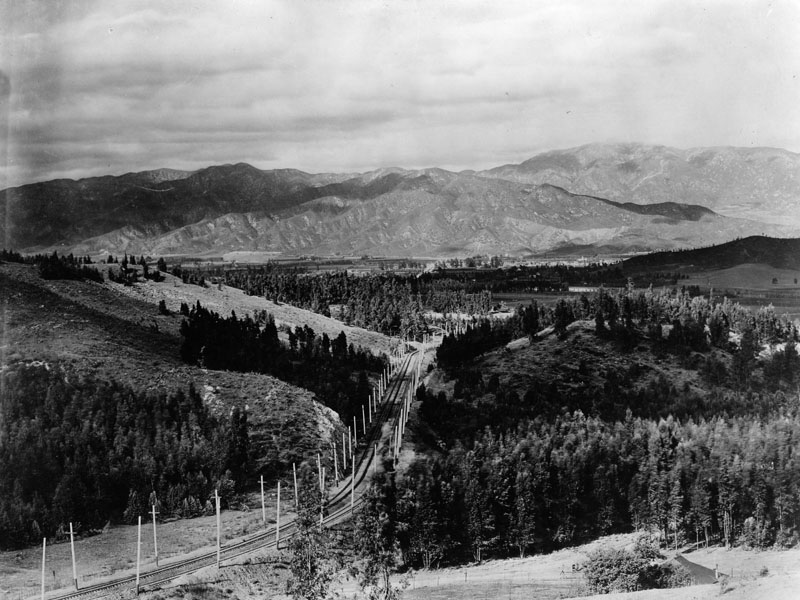 |
|
| (1904)^ - Panoramic view looking north toward Glendale along the Pacific Electric line through the Edendale Cut. |
Historical Notes The Edendale Cut was an unpaved road (some of which is now known as Silver Lake Ct.) and was the former route of the Glendale and Burbank interurban railway lines operated by Pacific Electric. The line crossed Fletcher Drive over a viaduct before continuing along a hillside ledge to the Monte Sano stop at Glendale Blvd. and Riverside Drive. |
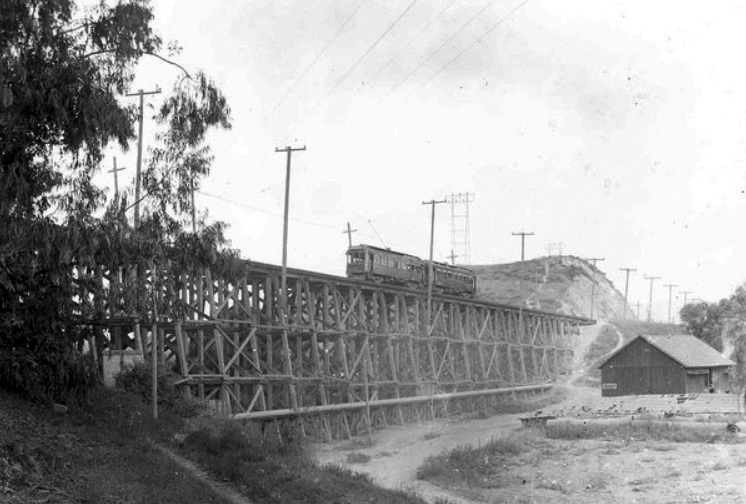 |
|
| (Early 1900s)^ – View showing two PE cars of the LA-Glendale Interurban Railway (owned by Pacific Electric) on top of the Fletcher Drive timber bridge. |
Historical Notes In 1904, a nearly 454 foot long bridge, the Fletcher Viaduct, was built by Pacific Electric over Fletcher Drive, which ran forty feet below. The viaduct stood until 1928 when it was replaced by a steel structure bridge. Click HERE to see more. |
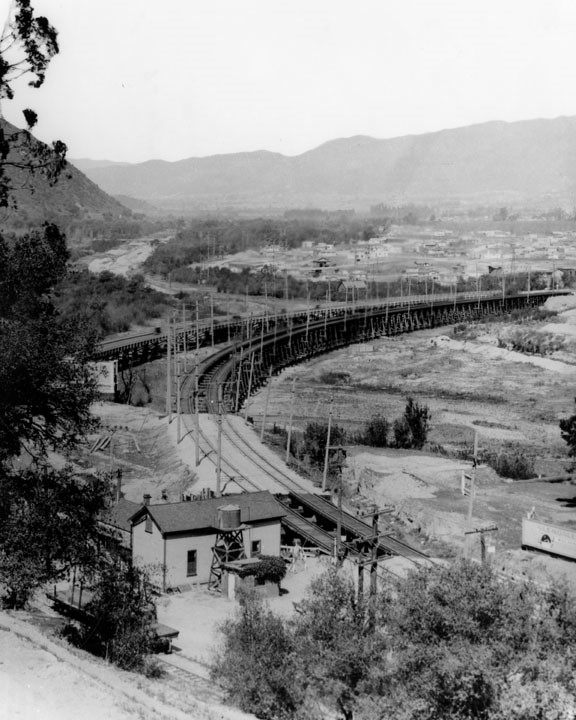 |
|
| (Early 1900s)^ – View looking towards the Pacific Electric LA-Glendale Interurban bridge at Glendale Boulevard running over the Los Angeles River, showing Griffith Park (left), Atwater Village, Tropico and Glendale. |
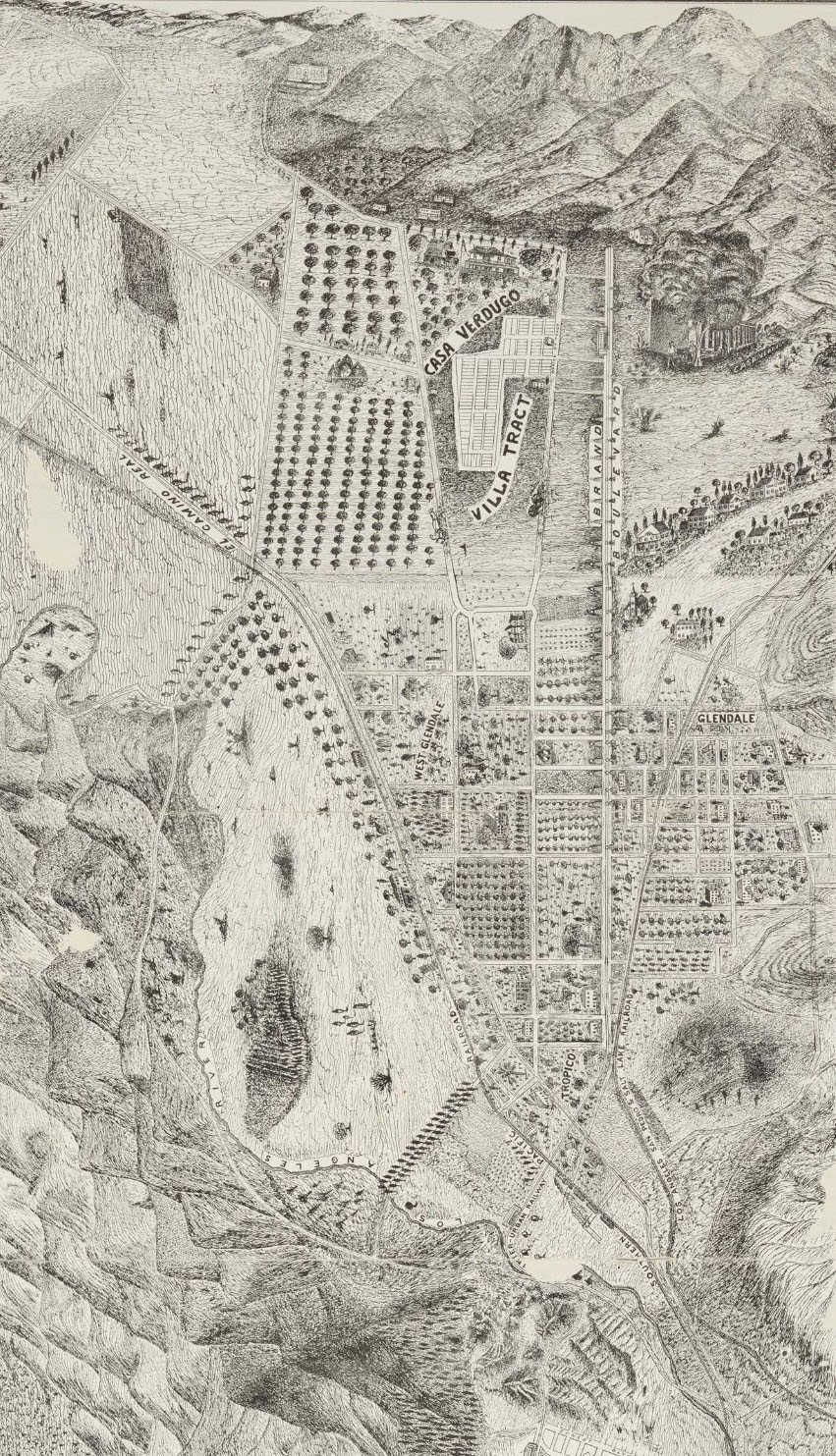 |
|
| (1906)^* – Birdseye view of Casa Verdugo Villa Tract and streetcar route which terminated at Brand Boulevard and Mountain Avenue, in front of the Casa Verdugo Restaurant. |
Historical Notes As a result of transportation innovations and the success of the restaurant, a commercial district was created in the Casa Verdugo neighborhood at the corner of North Central Ave. and West Stocker St. A theatre, various stores, a school, and a post office were established in the area, providing a solid economic foundation and increasing population growth that spurred residential construction. A flurry of developers, companies, and individuals participated in the purchase and subdivision of tracts in Casa Verdugo. The development of Casa Verdugo was not the effort of any single developer or builder, but rather a number of individuals who produced a network of various tracts. Real estate investor James Wyvell played an active role in the subdivision and development of the neighborhood. From 1906 to 1908, Wyvell subdivided and sold a number of tracts both within and surrounding the proposed district. This included land adjacent to the Casa Verdugo restaurant property and lots sold as home sites to individuals. Wyvell’s own Casa Verdugo tract and the Casa Verdugo Villa tract spoke to the growing identity of Casa Verdugo as its own distinct community. ^^ Within a few years of the Casa Verdugo restaurant opening a small community had developed and called itself Casa Verdugo after the restaurant. A commercial district grew along Brand Boulevard and Central Avenue, including a department store, groceries, a meat market, hardware store, drug store, the Mission Theatre and a post office where tourists could have their picture postcards of the restaurant postmarked “Casa Verdugo, California.” The droves of tourists, and the postcards they mailed home, helped make Casa Verdugo a well-known destination throughout the country; visitors had to see the missions, the Mt. Lowe Railway, Santa Catalina Island and the famous Casa Verdugo. ^ |
Bliss
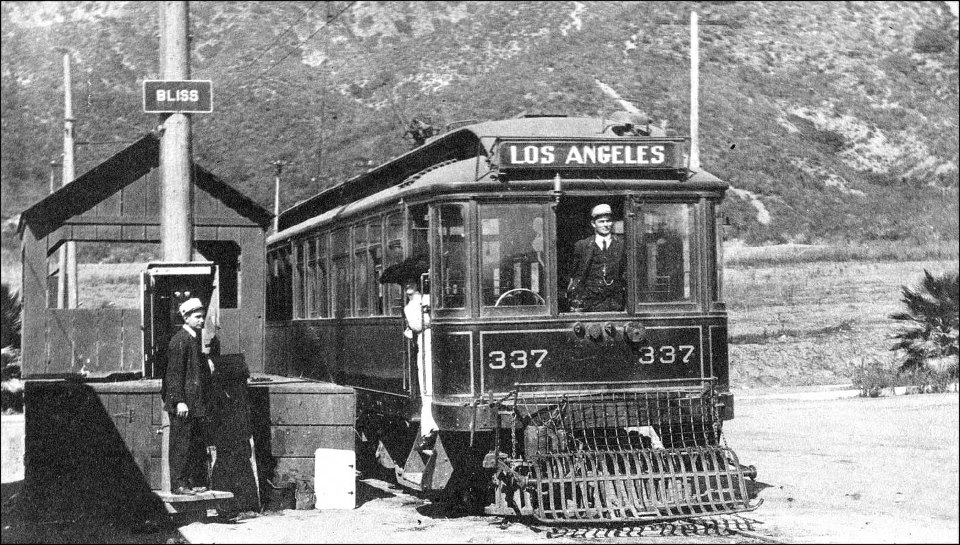 |
|
| (1909)* - All Aboard! Bliss to Los Angeles Line, 1909. Note the woman with the long white dress and huge hat. Also, the grill at the front (aka 'Cow Catcher'—it was a protective measure to prevent anyone (or anything) from falling underneath. |
Historical Notes Bliss was named for Bliss Ranch, owned by brothers John Dallett Bliss and Robert Parker Bliss from about 1894 to 1900, when LB Brand bought the property. He then sold a tract to Huntington for Pacific Electric. The Bliss stop was at the base of the Verdugo mountains, just after the Casa Verdugo stop (corner of Brand Boulevard and Mountain Street). |
 |
|
| (Early 1900s)+^^ - Old rail map showing the Bliss Station located om north Glendale, today's intersection of Brand Boulevard and Mountain Street (concrete base is still there). |
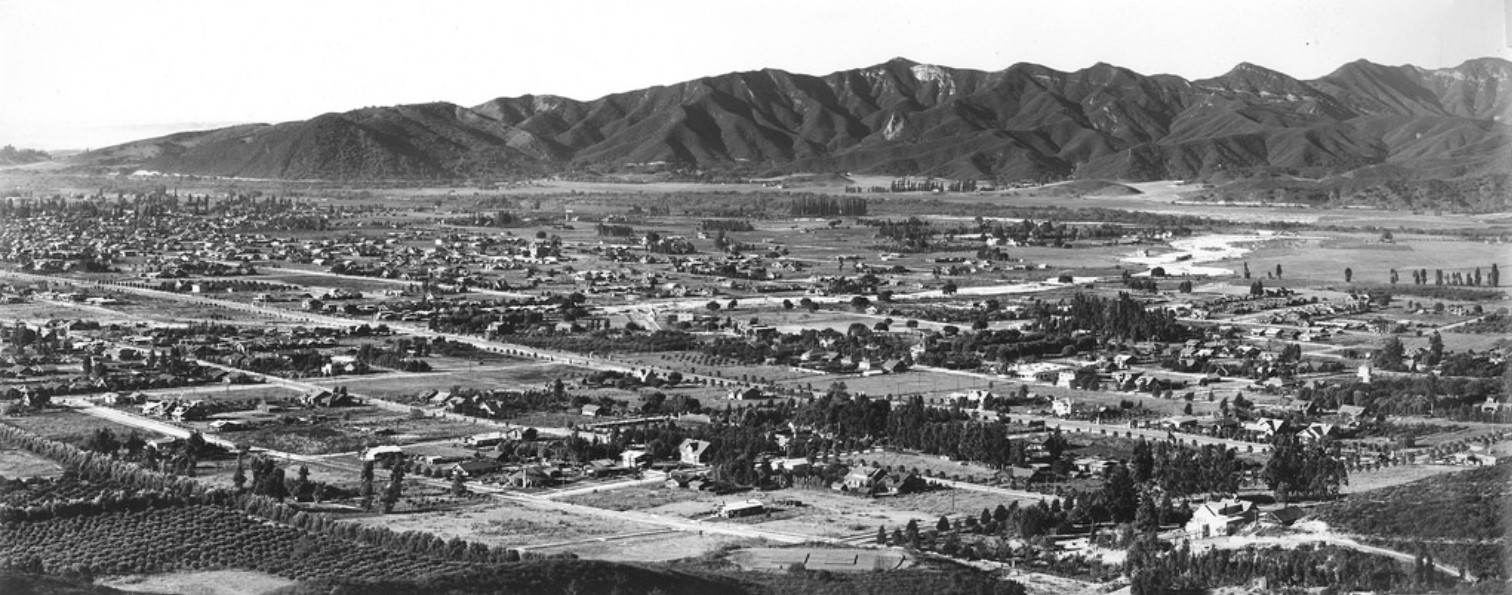 |
|
| (1912)#* – Panoramic view of Glendale, looking west from Jackson Street, showing the extent to which the area had grown. |
Historical Notes Glendale, the Casa Verdugo community, and surrounding area experienced a significant growth spurt beginning around 1904, due in large part to the arrival of the Pacific Electric line. Casa Verdugo held on to the unique identity that emerged during this time and refused to annex to the city of Glendale for sixteen years. Opponents desired an independent city while those in favor wanted the advantages of utilities and services offered by the larger city. In March of 1926, a vote for annexation passed and Casa Verdugo officially became a part of the city of Glendale on April 17, 1926. |
Brand Boulevard
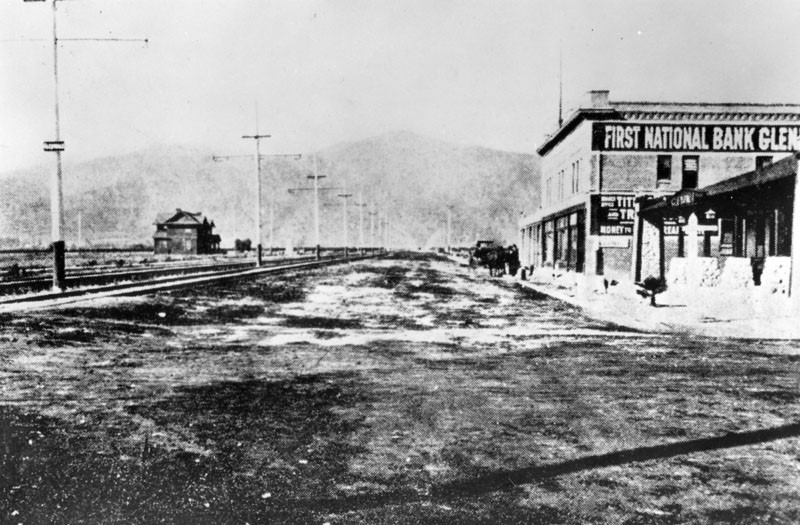 |
|
| (ca. 1905)^ - Early panoramic view looking north on Brand Boulevard at Fourth Street (later Broadway) with the First National Bank of Glendale seen at right. Rail tracks run north and south on Brand with electric power poles in the middle of the street. To the far right (N/E corner) stands the Pacific Eelctric station. |
Historical Notes Brand Boulevard was named after Leslie Coombs Brand, “The Father of Glendale”. Brand was an important civic booster who built an estate in 1904 called El Miradero featuring an eye-catching mansion whose architecture combined characteristics of Spanish, Moorish, and Indian styles (today’s Brand Library and Art Center). His most important contributions to Glendale, though, was when he partnered with Henry E. Huntington to bring the Pacific Electric Railway, or the "Red Cars," to the area also in 1904. The First National Bank of Glendale seen above was the city’s second bank. It was founded by Leslie Brand in 1905. Brand's friend and business partner, Dan Campbell, served as the bank's vice president and manager. |
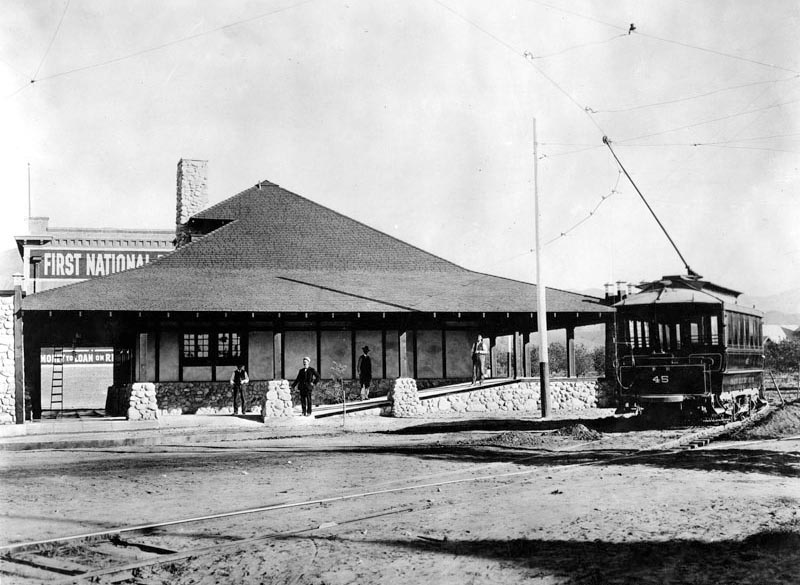 |
|
| (ca. 1906)^ - Early view of the Pacific Electric station in Glendale with car on track. First National Bank of Glendale, the first brick building in town, is seen behind the depot. |
Historical Notes The Glendale Line was pioneered by L.C. Brand and associates starting in October, 1902, through their corporation, "The Los Angeles & Glendale Electric Railway". On June 29, 1903, Brand received a franchise from the Los Angeles City Council for an electric railway line starting at the Southern Pacific's Arcade Station at Fifth, Central & Ceres Street in Los Angeles via Ceres, Sixth, Olive, Seventh, Figueroa, Second, Lake Shore Ave. (Glendale Boulevard) to Sunset Boulevard, and then northerly to the city limits. In Glendale, the line was to enter via a new thoroughfare, Brand Boulevard, thus creating a new business artery to the west of the then central business section on Glendale Ave. where the steam trains of the Los Angeles Terminal Railroad (U.P.) offered the only transportation via rail to the city. Brand's company commenced grading on above route in September, 1903 and continued into the spring of 1904. On March 11, 1904, however, Brand sold out to the Los Angeles Interurban Railway Company (LAIU), a Huntington-PE affiliate. The LAIU pushed the road through to completion and the first electric car entered Glendale on April 6, 1904, but a formal celebration was not held until July 2 when great crowds gathered for a Mexican barbecue. A Station was erected in Glendale on the corner of Brand Boulevard & Broadway (seen above).^ |
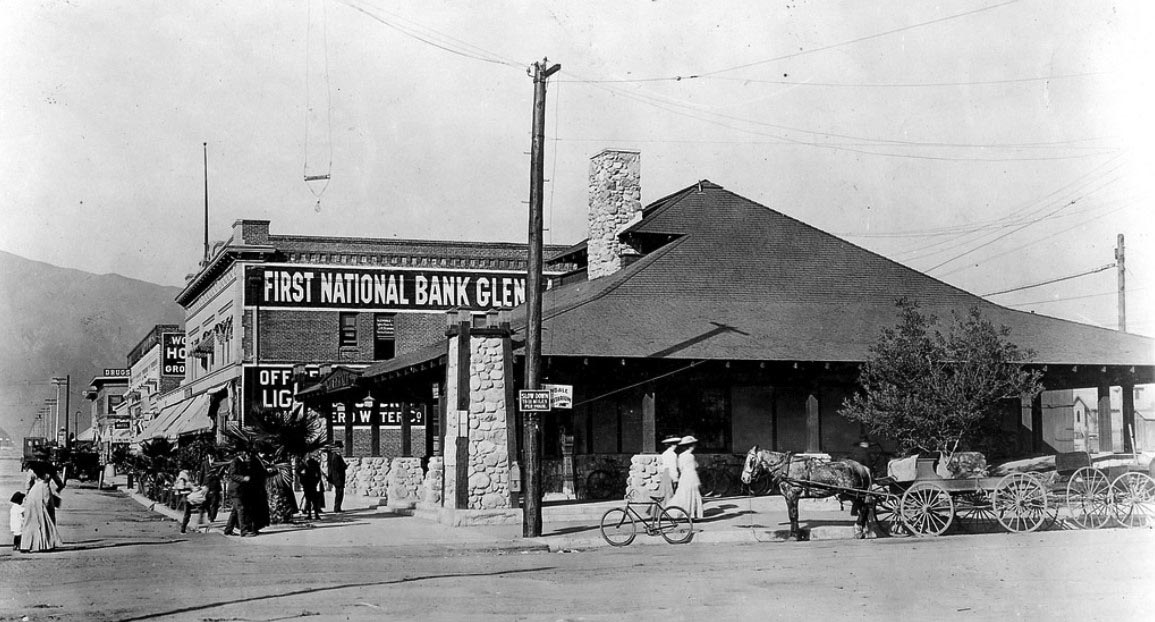 |
|
| (1911)* – Panoramic view showing the corner of Brand Boulevard and Fourth Street (now Broadway) with the Pacific Electric depot in the foreground and the First National Bank of Glendale behind it. Horse-drawn wagons and a bicyle are parked by the curb in front of the depot. |
Historical Notes The Glendale Line was soon extended east on Broadway to Glendale Avenue where all cars terminated for a short time. Los Angeles Interurban Railway Company (LAIU) acquired the historic old Verdugo ranch house, more than a hundred years old, in 1904; this was located in North Glendale at the foot of the mountains and LAIU restored the ruins, making Casa Verdugo into one of Los Angeles' most popular restaurants. To serve this new tourist attraction, the Glendale Line was extended up Brand Boulevard to Mountain Avenue in 1904 with very frequent service offered from Sixth & Main Station, Los Angeles.^ |
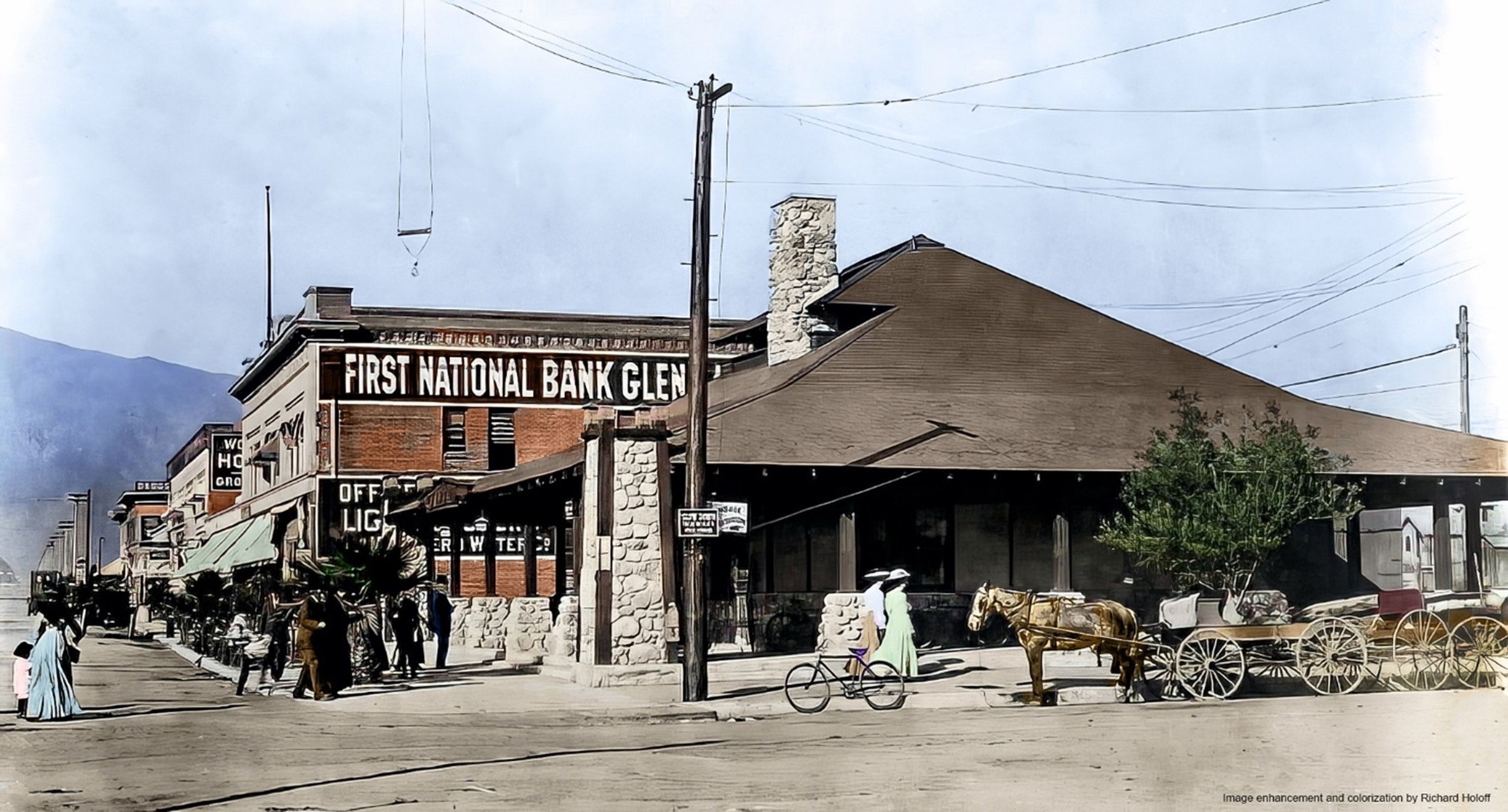 |
|
| (1911)* – Panoramic view showing the corner of Brand Boulevard and Fourth Street (now Broadway) with the Pacific Electric depot in the foreground and the First National Bank of Glendale behind it. Horse-drawn wagons and a bicyle are parked by the curb in front of the depot. Image enhancement and colorization by Richard Holoff |
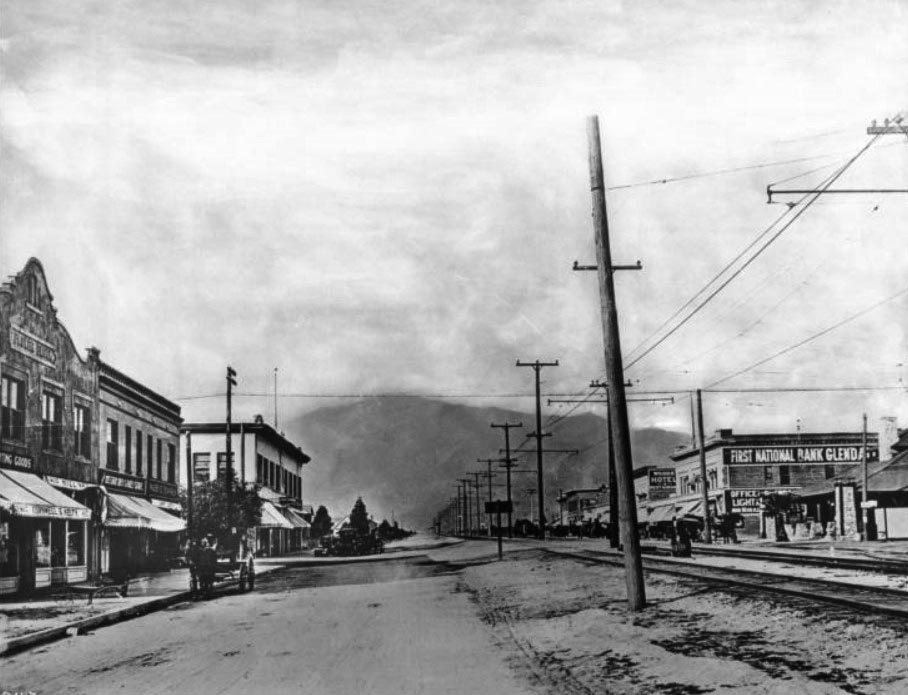 |
|
| (ca. 1910)^^ – View looking north in the 400 block of Brand Boulevard, Glendale. Railway tracks and electric wires run up the middle of the dirt road. Commercial structures on both sides of the street are principally two-stories in height. Horse-drawn wagons are parked along both curbs. First National Bank Glendale can be see at right. |
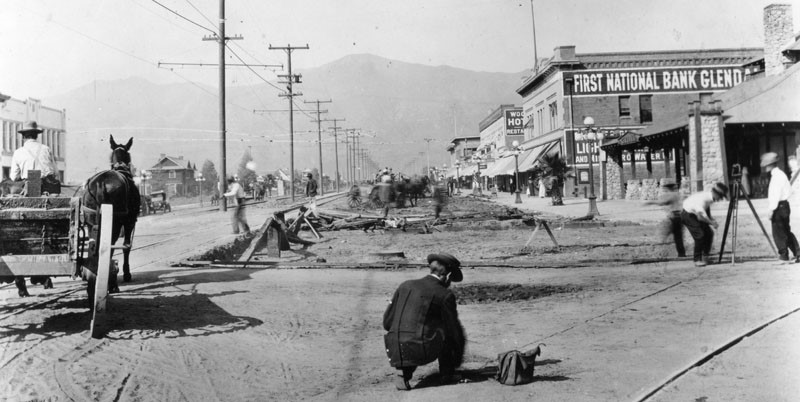 |
|
| (ca. 1910s)^ - View is looking at Brand Boulevard, north of Broadway. Work is being done on the right side of the road. Several businesses are seen including the First National Bank, Glendale building on the right. |
 |
|
| (ca. 1915)^ - Panoramic view of Glendale showing the Pacific Electric Railway running north and south on Brand Boulevard with Glendale Savings Bank (previously First National Bank Glendale) on at center-right. |
 |
|
| (ca. 1915)^ - Panoramic view of Glendale showing the Pacific Electric Railway running north and south on Brand Boulevard with Glendale Savings Bank (previously First National Bank Glendale) on at center-right. Image enhancement and colorization by Richard Holoff |
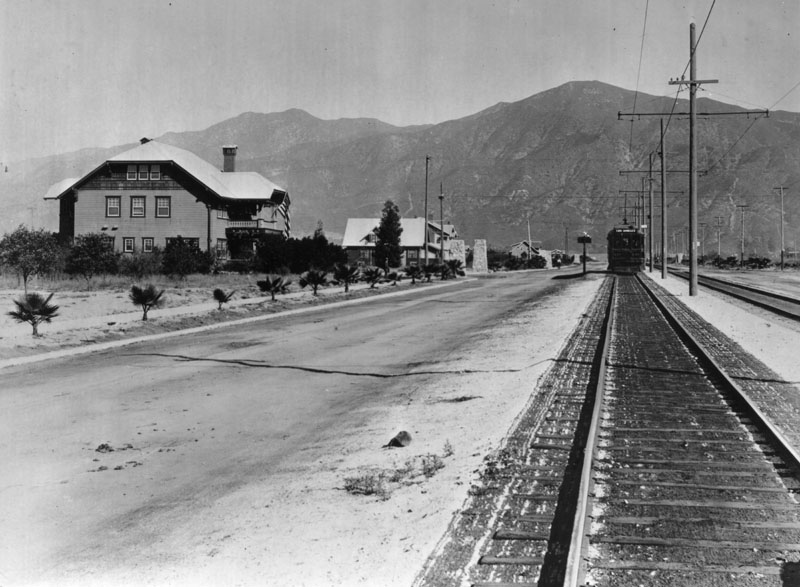 |
|
| (1915)^ - View of north Brand from Lexington. The railroad train, "Los Angeles line" makes its way up Brand. Large residential homes can be seen on the left. |
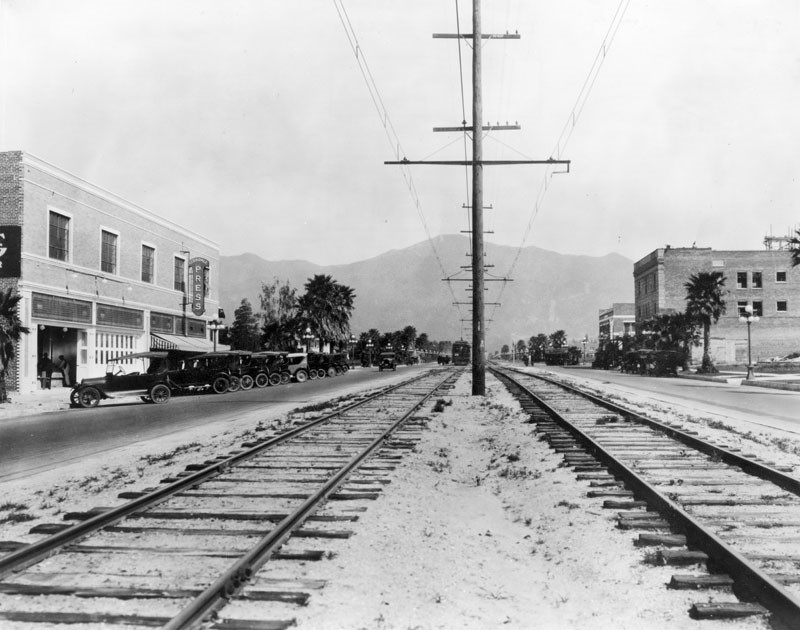 |
|
| (1919)^ - View of Brand and Lexington and the surrounding area. The Glendale Press building is on the left. The train in the distance is stopped to pick up passengers waiting along the way. |
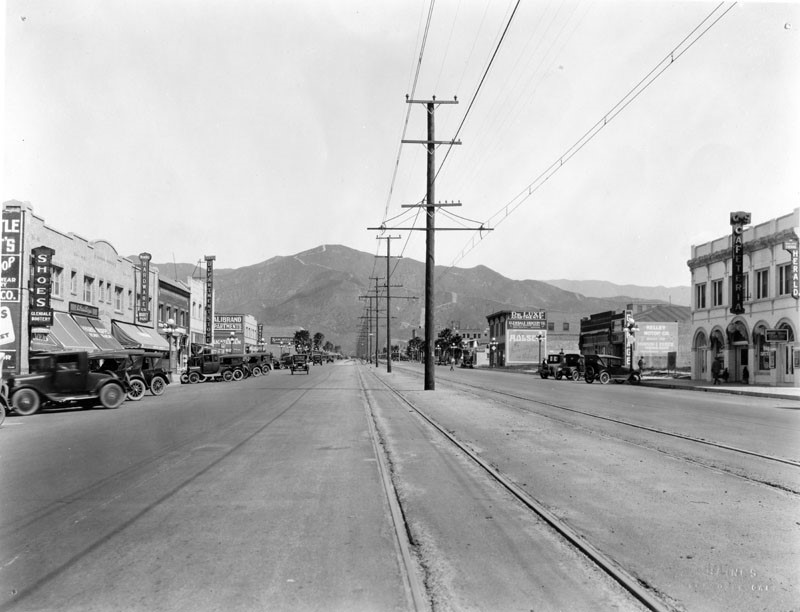 |
|
| (ca. 1919)^ – View of Brand Boulevard from Wilson Avenue, looking north. Various businesses are seen on both sides of the road with railroad tracks running down the center of this wide street. |
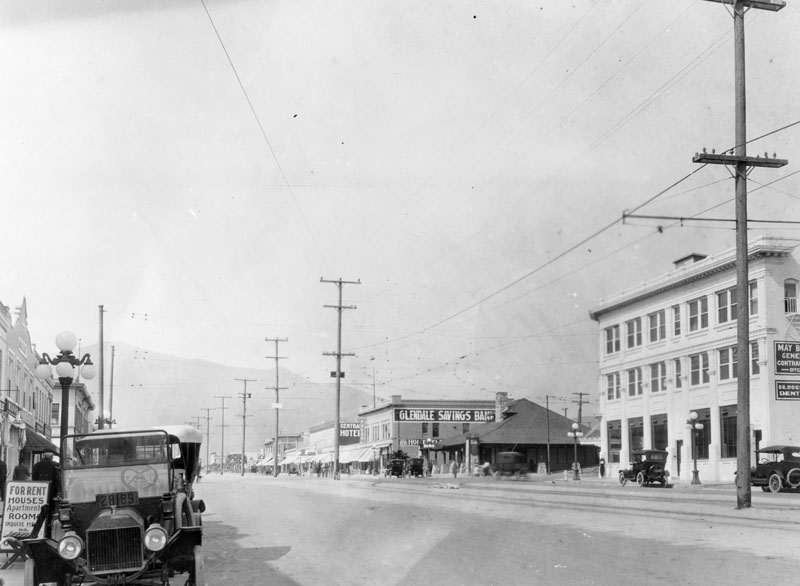 |
|
| (ca. 1920)^ – View looking north on Brand from Broadway. Glendale Savings Bank (previously First National Bank) can be seen in the distance. Electric car posts and wires fill the middle of the street. |
Then and Now
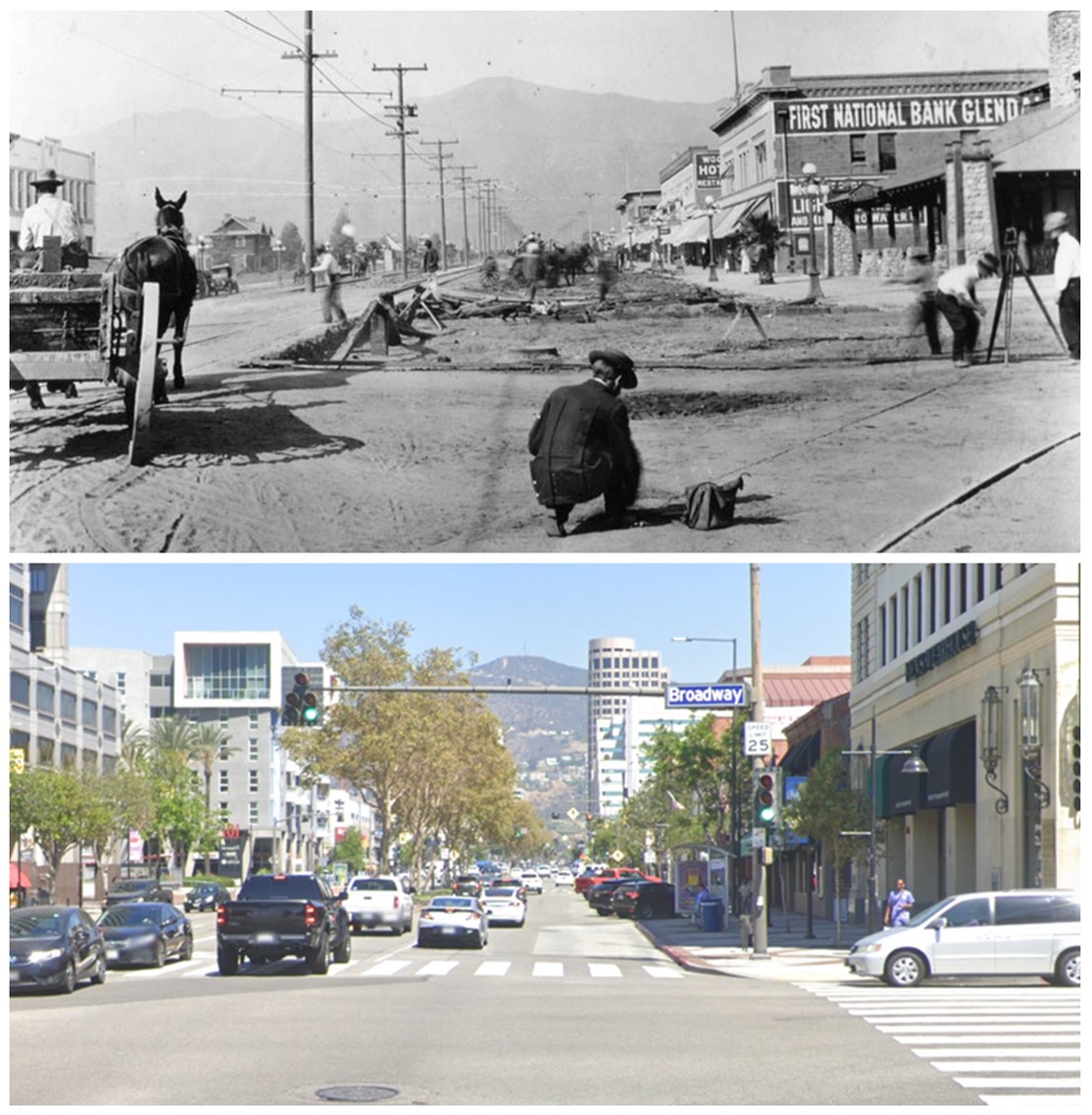 |
|
| (1911 vs 2022)* - Looking north on Brand Boulevard at Broadway. |
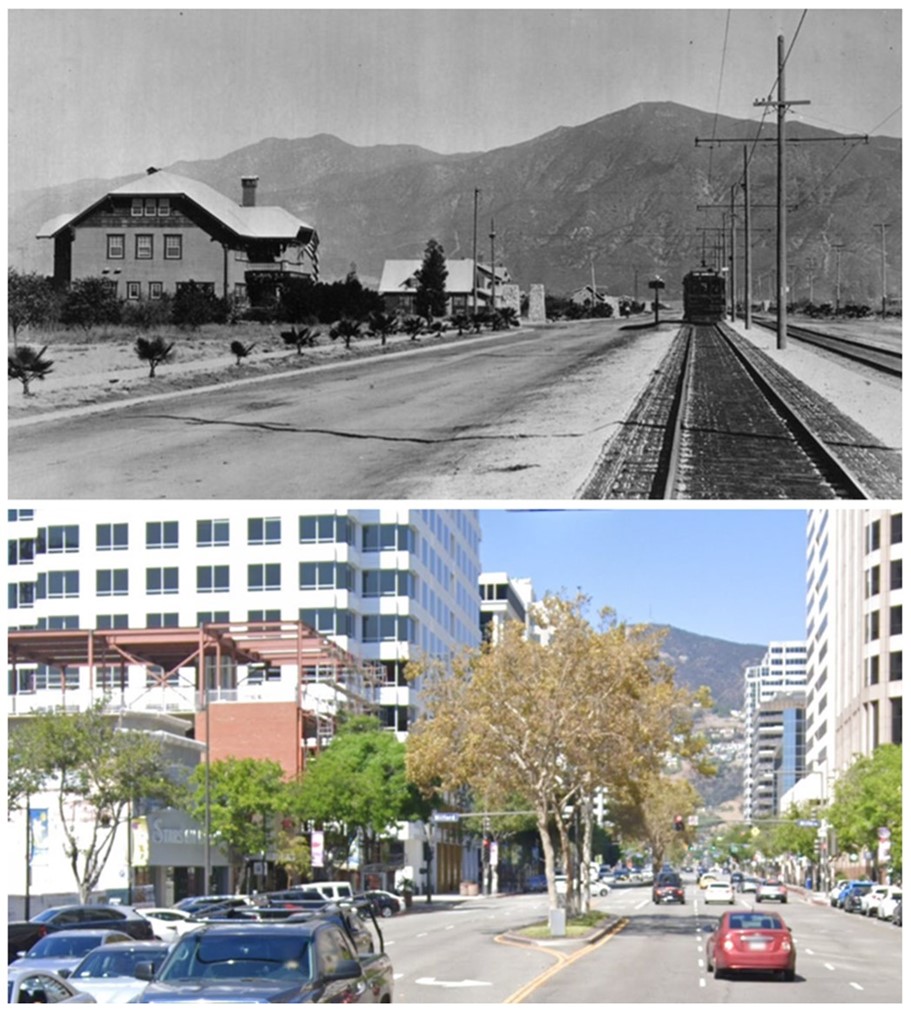 |
|
| (1915 vs 2022)* - Looking north on Brand Boulevard from Lexington Drive. |
Historical Notes Click HERE to see more Early Views of Brand Boulevard (1920 +) |
Life in Early Glendale
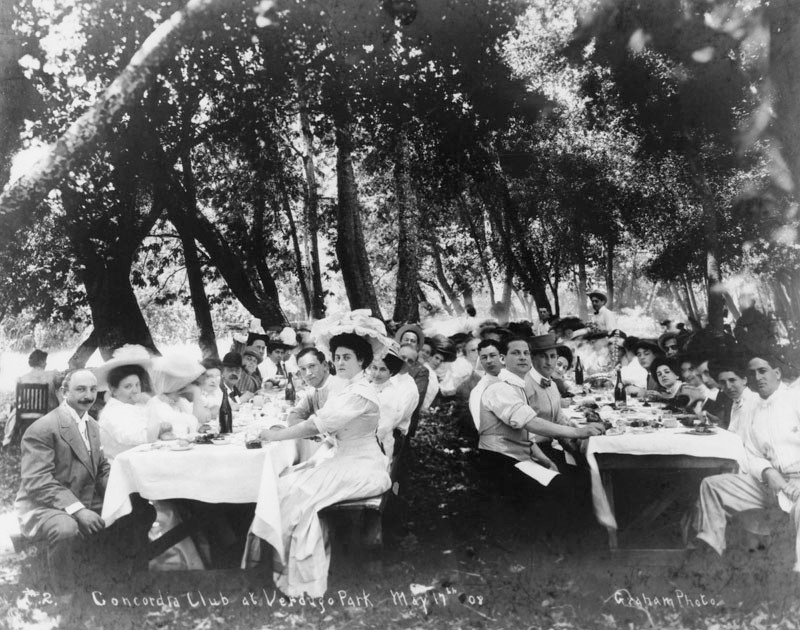 |
|
| (1908)^ - A picnic for the Concordia Club, a social group, at Verdugo Park in Glendale. |
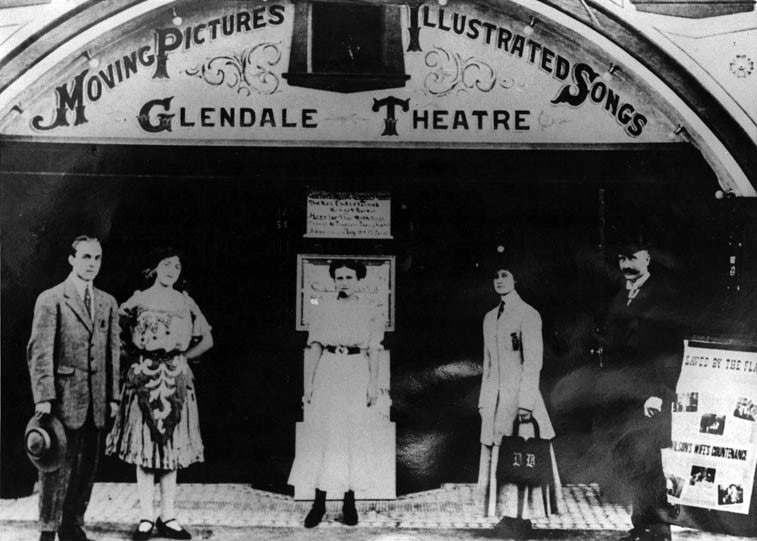 |
|
| (1910)^ - Three women and two men standing in front of the Glendale Theater. This is Glendale's first movie & vaudeville house. |
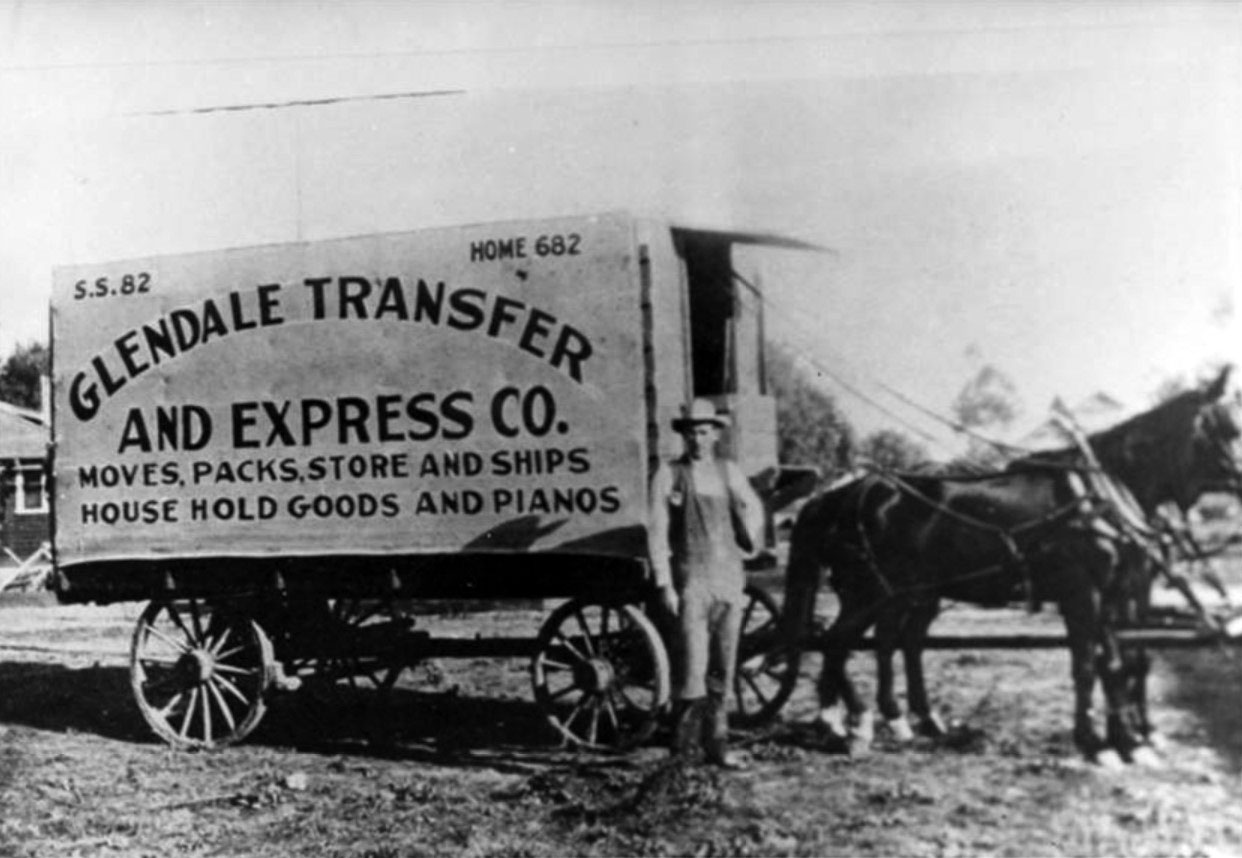 |
|
| (ca. 1906-1918)***^ - The Glendale Transfer and Express Company's moving truck in Glendale. |
Historical Notes Note the two phone numbers at the top of the truck (S.S. 82 and HOME 682). Between 1906 and 1918, the San Fernando Valley Home Telephone Company and Sunset Telephone both operated in the Glendale area. Unfortunately, neither was compatible with the other therefore requiring patrons to have two lines--one for each company. |
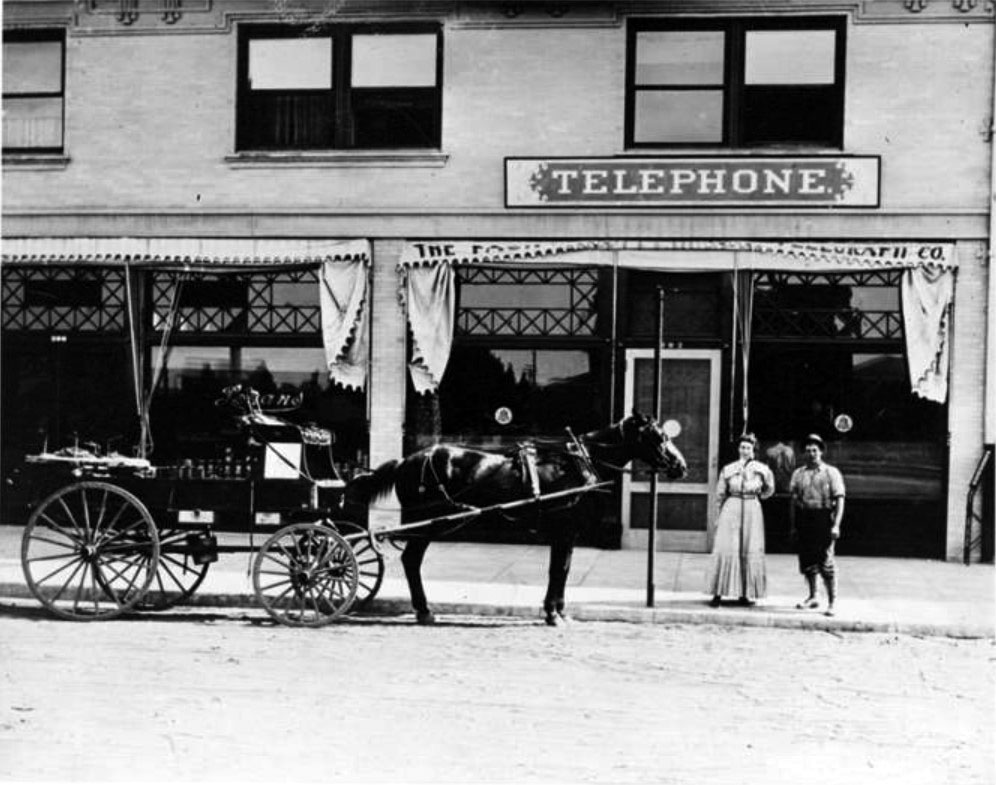 |
|
| (1914)***^ - View showing the Home Telephone Company office, located at 302 Brand Boulevard in Glendale. A state-of-the-art telephone maintenance vehicle is visible in the foreground. |
Historical Notes In 1909, L. C. Brand invested heavily in the Home Telephone Company and installed new switchboards in company office at the Central Hotel Building on Brand Boulevard.***^ |
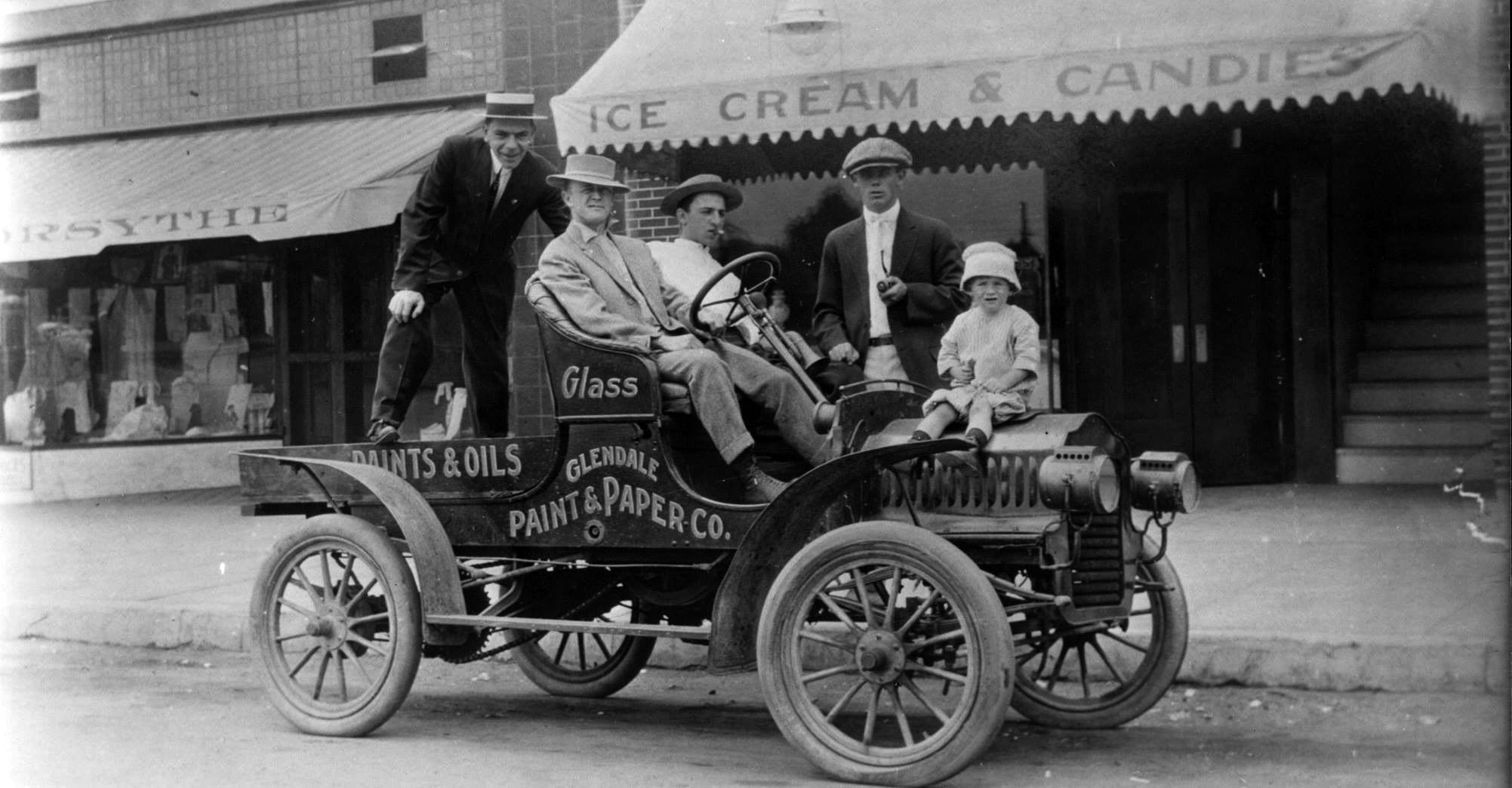 |
|
| (1913)+++ – View showing a group of men and a child posing on an early model car in Glendale. Sign on the side of car reads: “Glendale Paint & Paper Co. |
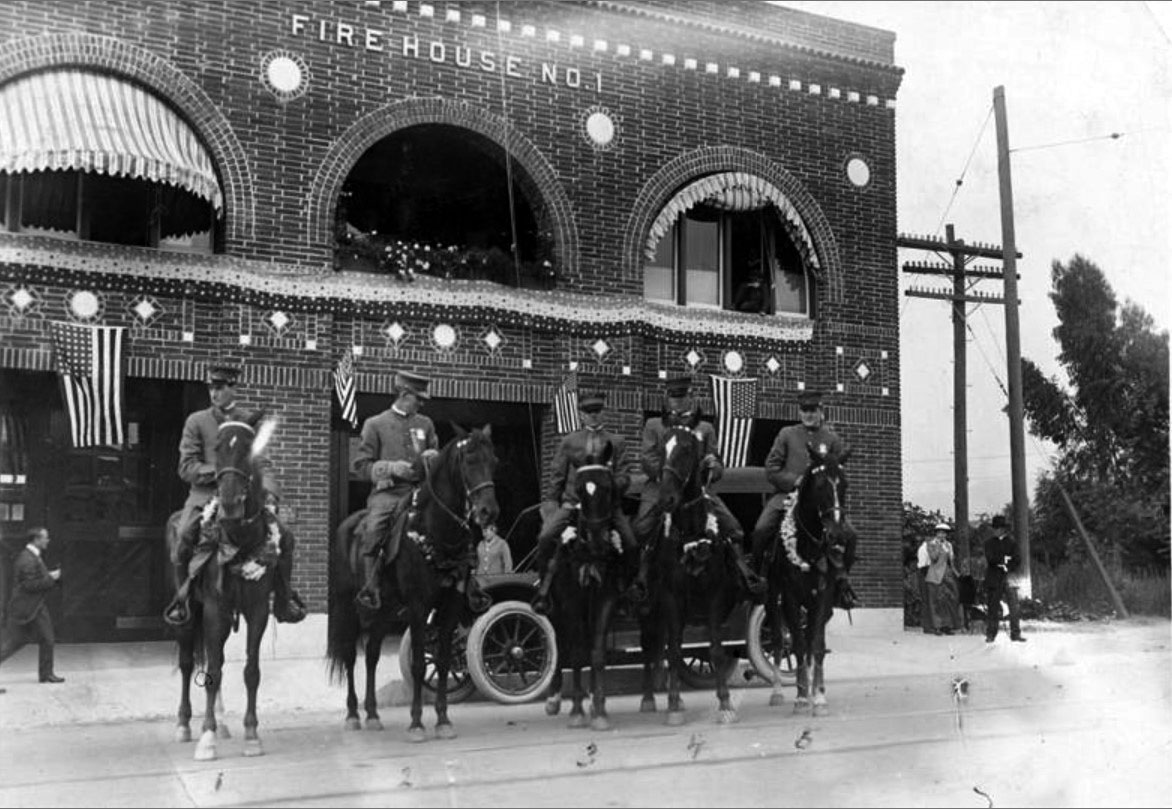 |
|
| (1916)***^ - View showing the police force of Glendale mounted on horseback in front of Fire House No. 1, located on Broadway between Louise and Kenwood Streets. (left to right) Emil Schroeder; Henry Hollenbeck; George Herald, Marshall & Fire Chief; Ernest Lawrence; Claire V. Arrington. |
Historical Notes From 1913 to 1918, the Glendale police and fire departments operated as a single entity out of Fire House No. 1 on Broadway between Louise and Kenwood Streets. Police officers and firemen were often required to perform double-duty when needed. In the upper right window are the twin sons of George Herald: Frank and George, Jr.***^ Click HERE to see more Early Views of the Glendale Police Department (1919 +) |
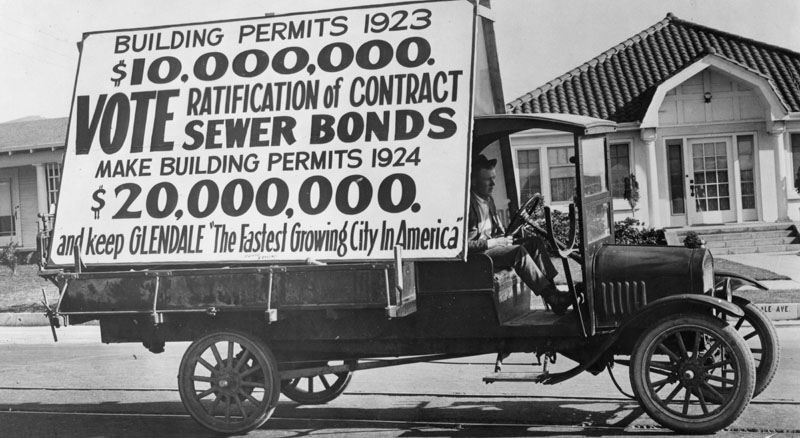 |
|
| (1923)^ - Glendale, incorporated as a city in 1906, by 1910 had a population of 2,742. In 1920 it had increased by 39%, to 13,576, creating "the fastest growing city in America." Here a truck bears a sign urging ratification of sewer bonds to enhance the awarding of building permits. |
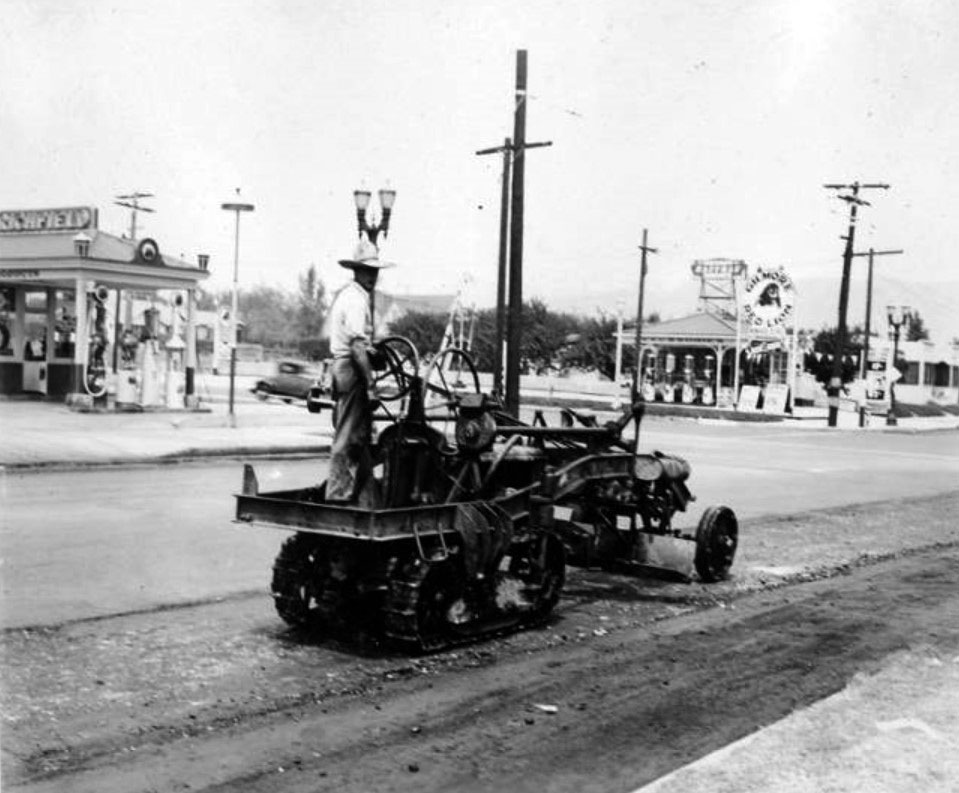 |
|
| (ca. 1930)***^ – View showing street paving in Glendale. A Richfield gas station and a Gilmore Red Lion gas station are visible in the background. |
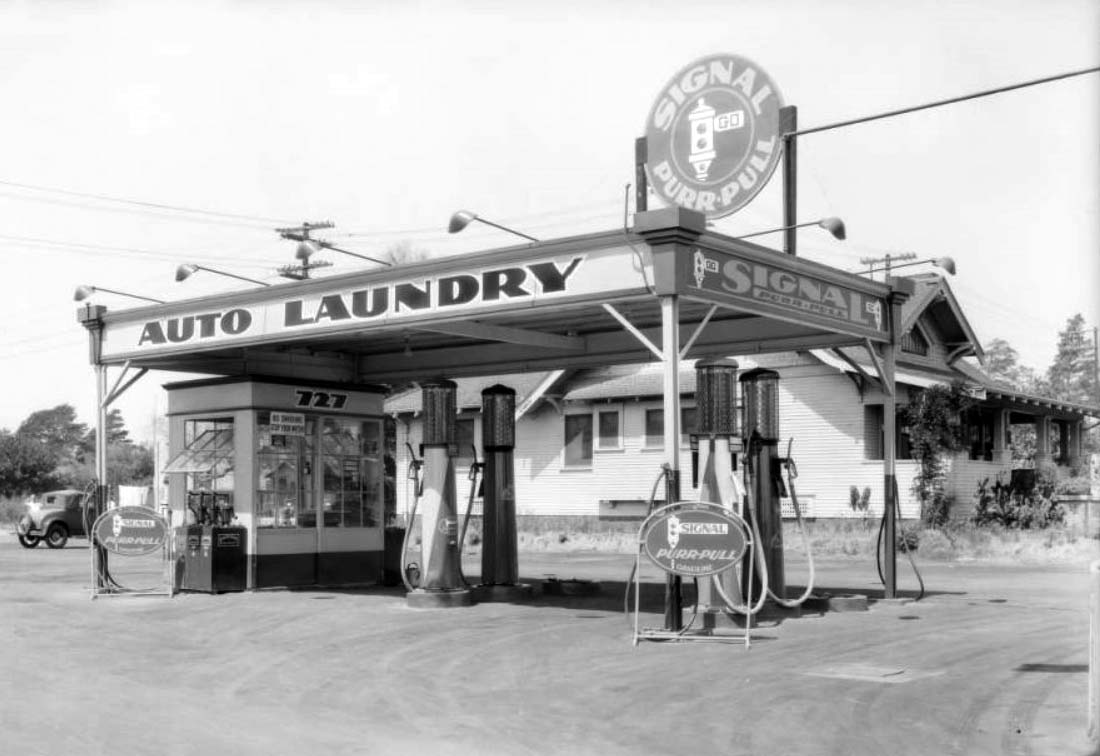 |
|
| (1931)^^ – Close-up view showing a 4-pump Signal Service Station in Glendale. Large signs reads Auto Laundry – Signal Purr-Pull. Click HERE to see more Early Views of Gas Stations. |
* * * * * |
Glendale Avenue
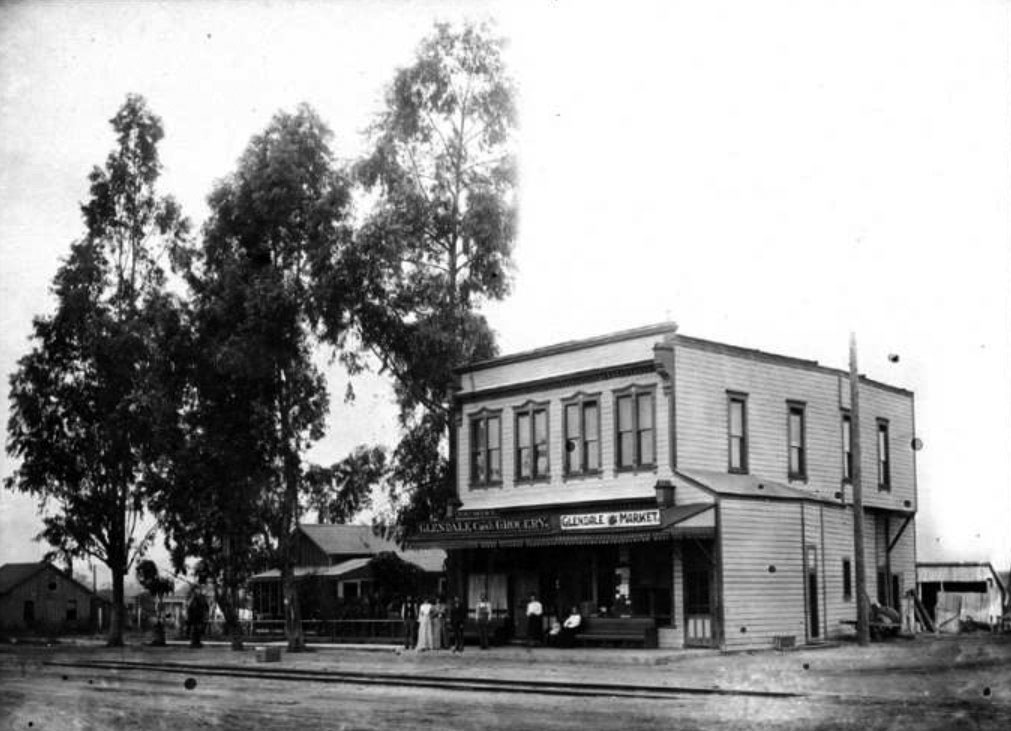 |
|
| (1895)***^ - View of the Glendale Market and the Glendale Cash Grocery Store on the southwest corner of Crow Avenue (now Glendale Avenue) and 3rd Street (now Wilson Avenue) in Glendale. The lean-to at the right corner was the local barbershop. Visible in the foreground are the train tracks that ran through the center of town connecting Glendale with downtown Los Angeles. |
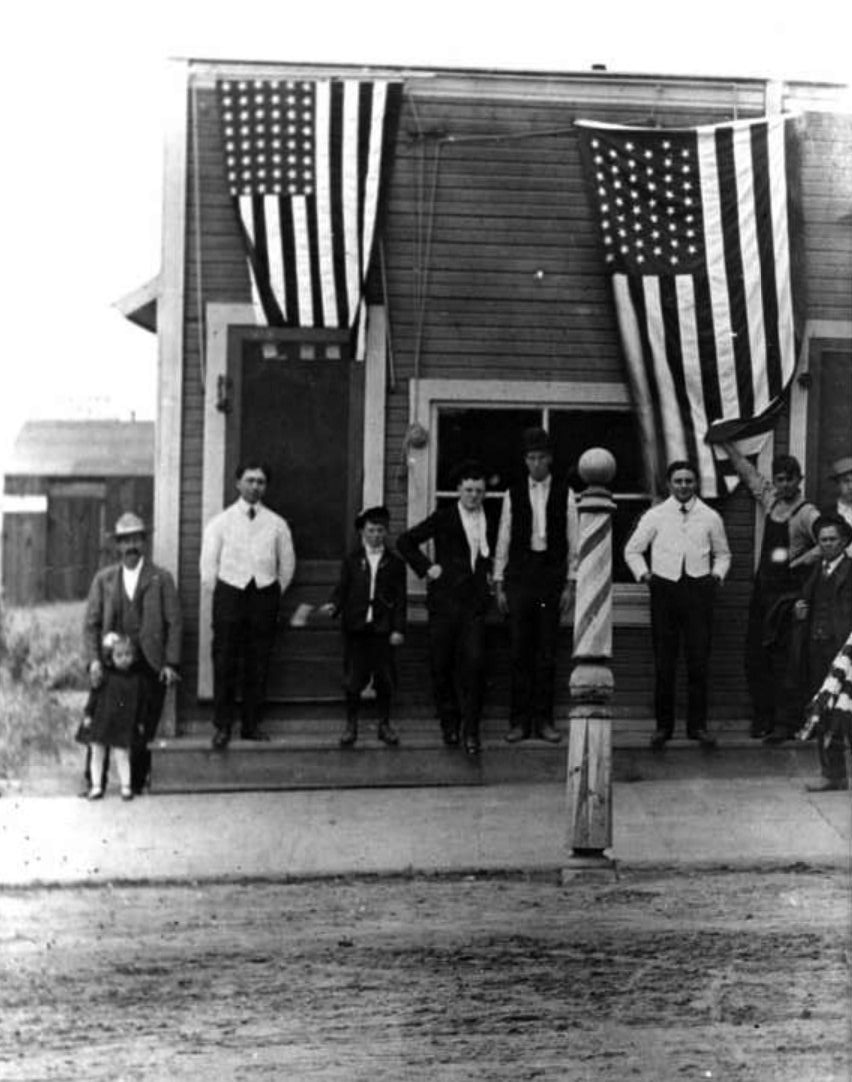 |
|
| (ca. 1900)##^ – A group of people pose in front of Al Oliver’s Barbershop located on the southwest corner of Everett Street and Wilson Avenue in Glendale. |
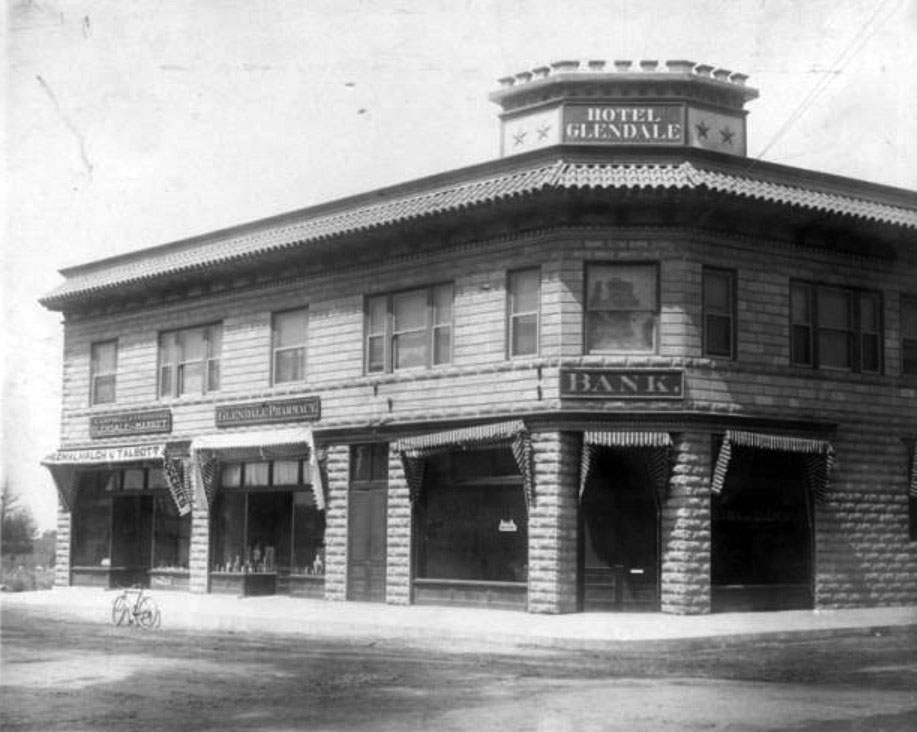 |
|
| (1905)***^ – View showing the Hotel Glendale located on the northwest corner of Glendale and Wilson Avenues (then Crow Avenue and 3rd Street). Glendale Bank occupies the ground floor. |
Historical Notes The Glendale Bank was the first bank in Glendale. The building was constructed by Mr. Ayers.***^ |
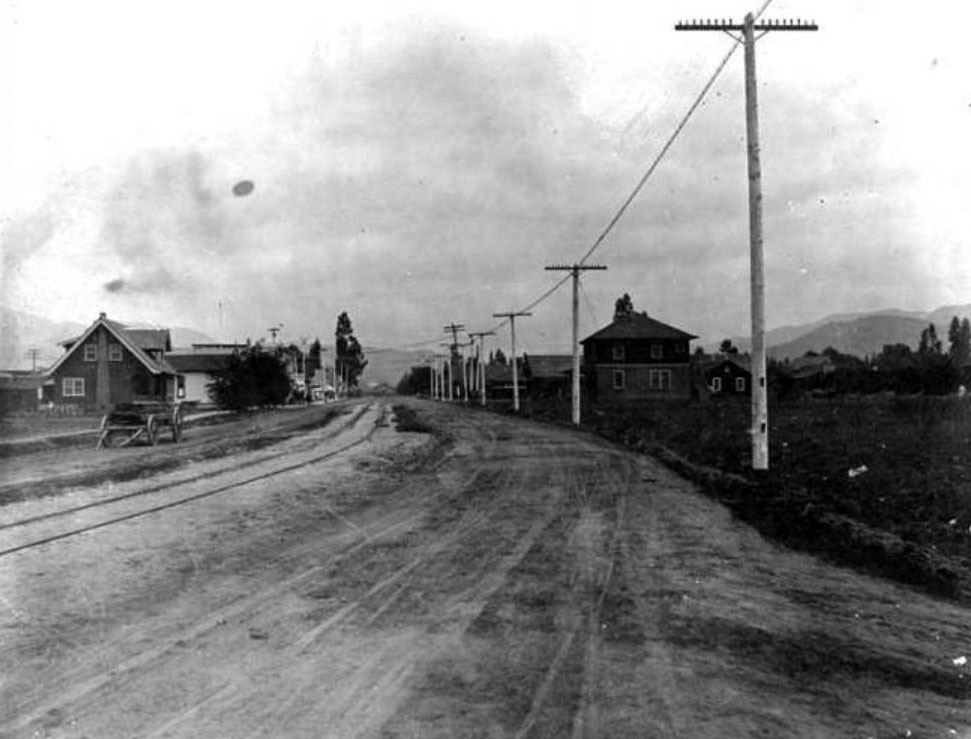 |
|
| (ca. 1908)***^ - Glendale Avenue, north from Harvard Street, circa 1908. The Southern Pacific railroad lines run down the center of Glendale Avenue. |
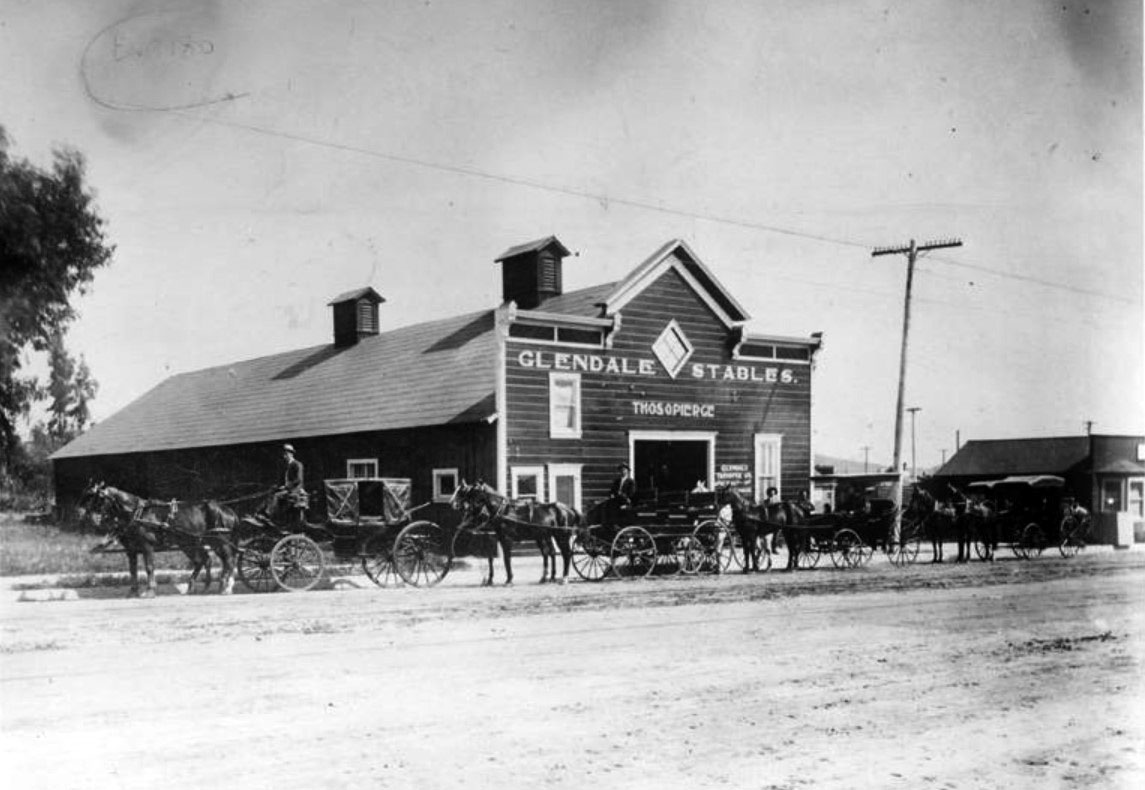 |
|
| (1909)***^ – Horse-drawn carriages are lined up in front of the Glendale Stables, located on Glendale Avenue. The stable was owned and operated by Thomas O. Pierce. |
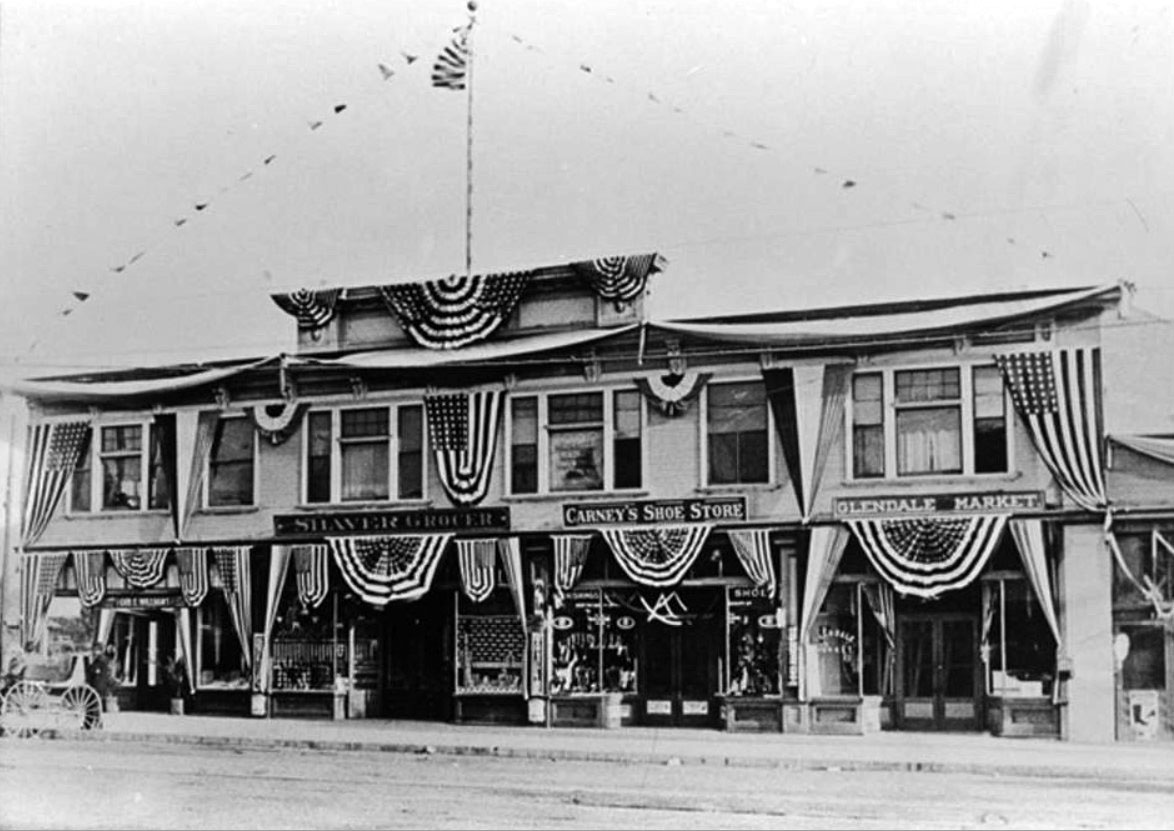 |
|
| (1911)##^ - View of the south side of East Broadway. Before the renaming and renumbering that occurred in 1916, this was the 500 block of West 4th Street. Visible here are: Shaver's Grocery Street, at 532 W. 4th Street, managed by H. G. McBain; Carney's Shoe Store, at 536 W. 4th Street, owned by Dave Carney; and Glendale Market, at 540 W. 4th Street, owned by C. W. Ingledue. |
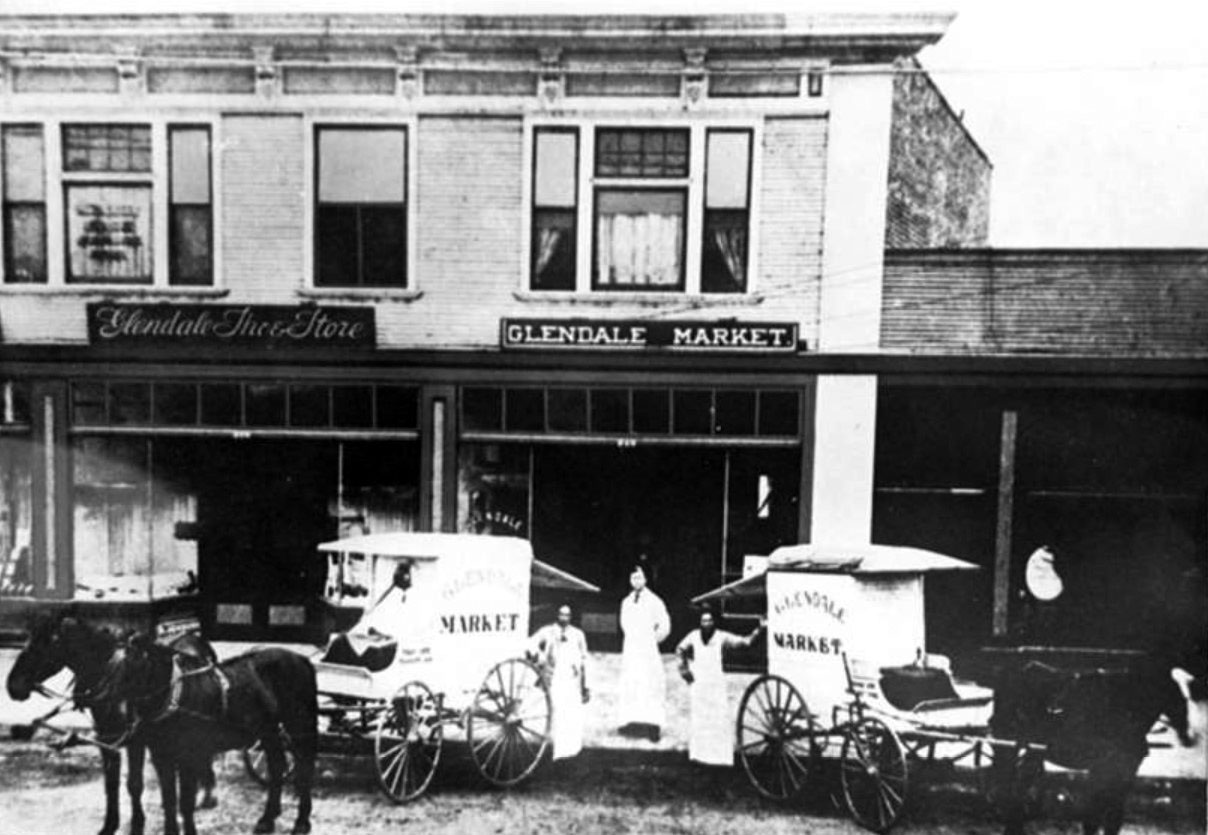 |
|
| (1910)***^ - The Glendale Market located on the southwest corner of Glendale Avenue and Broadway. Visible are (left to right): Fred Fish, Bill Whaley and unknown. |
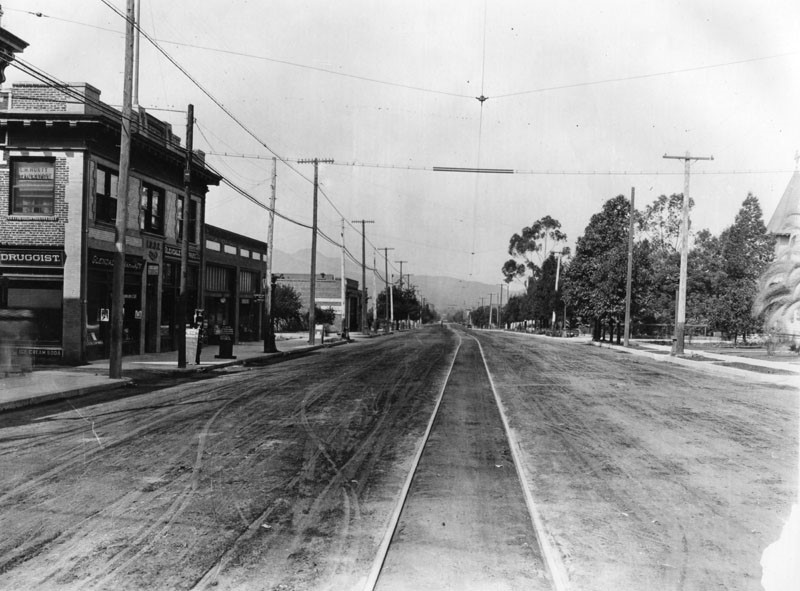 |
|
| (1910)^ - View of East Broadway in Glendale, looking west from Glendale Avenue. Street railway track and power lines are seen. |
Glendale and Broadway (S/E Corner)
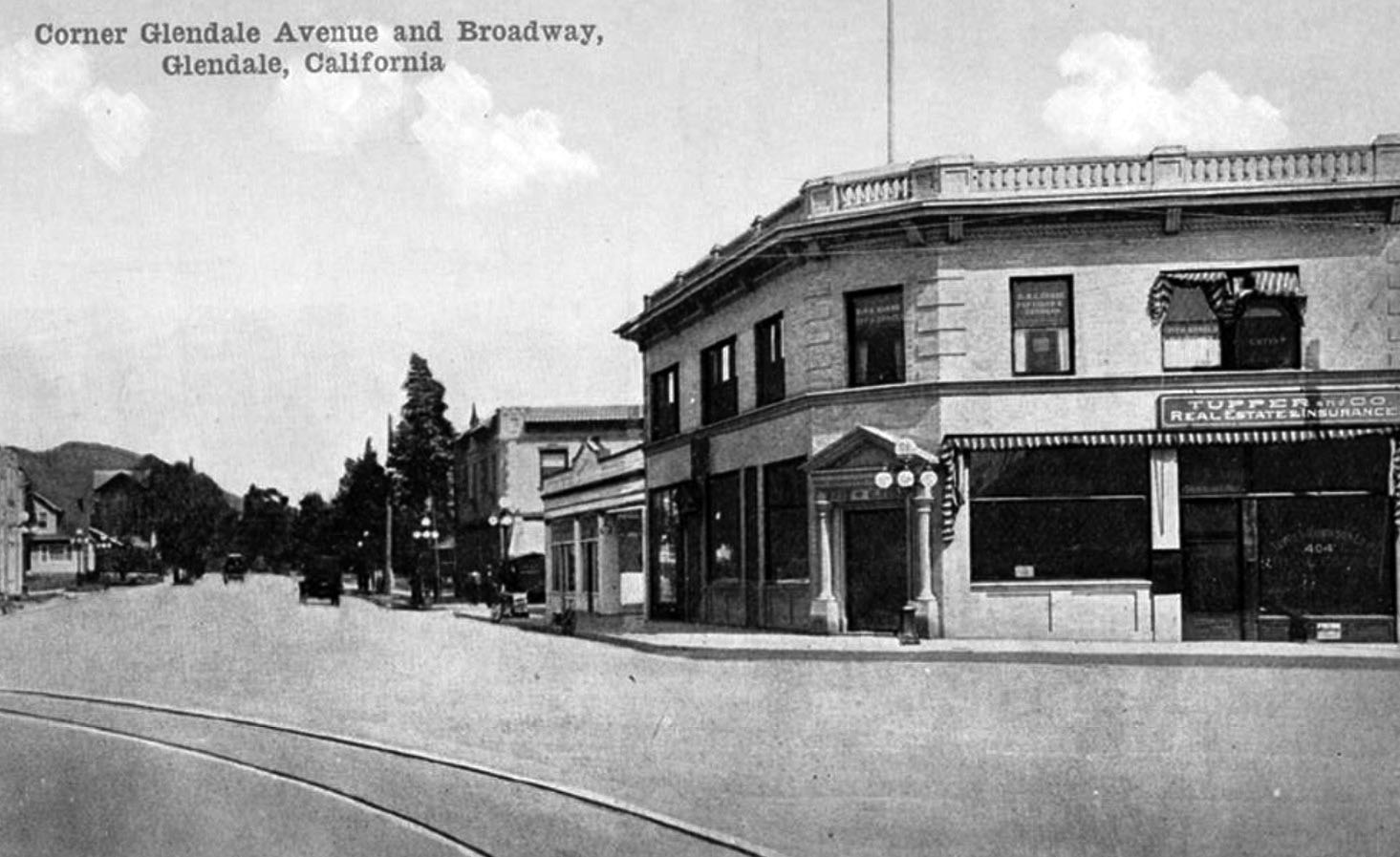 |
|
| (ca. 1910s)***^ – Postcard view showing The Bank of Glendale. The bank was originally located on the corner of Crow Avenue (now Glendale Avenue) and Broadway. |
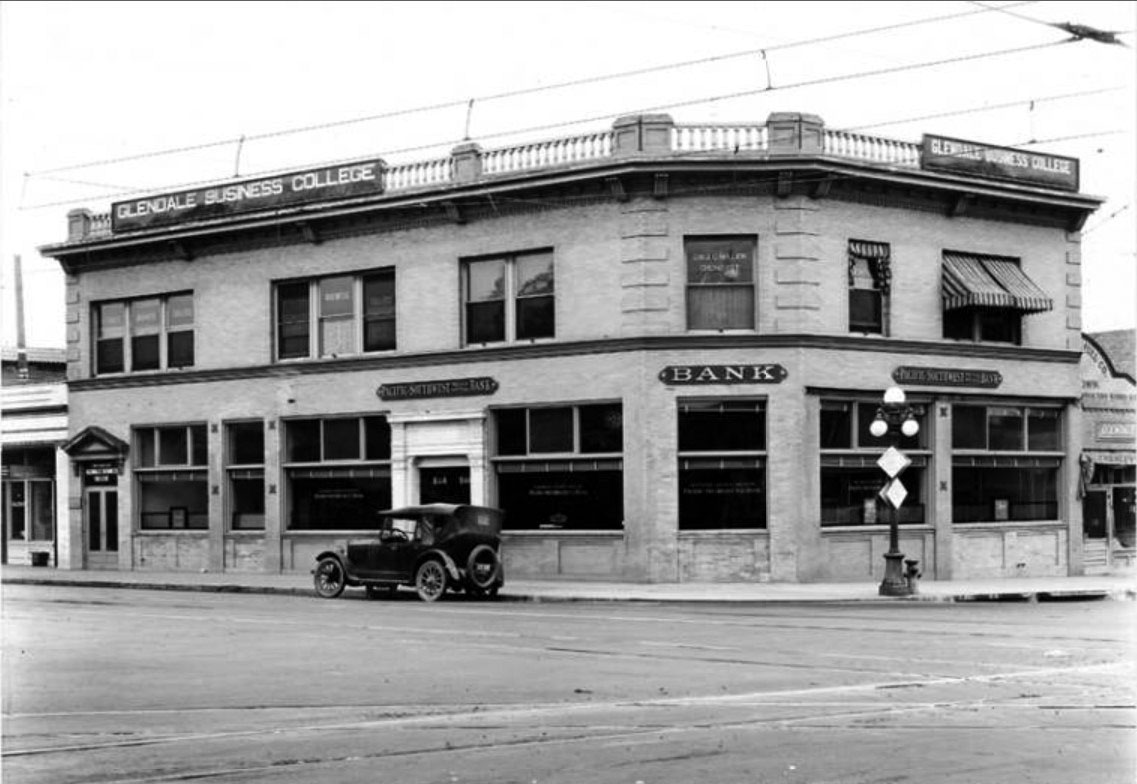 |
|
| (1922)***^ – View showing the Pacific Southwest Trust and Savings Bank and the Glendale Business College, located on the southeast corner of Broadway and Crow Avenue (now Glendale Avenue). |
Historical Notes From 1909 to circa 1922, the Glendale Bank was located in this building. The wires and tracks of the Pacific Electric Railway are visible running down the middle of the street. The Pacific Electric local line ran along East Broadway from Brand Boulevard to Chevy Chase Drive.***^ |
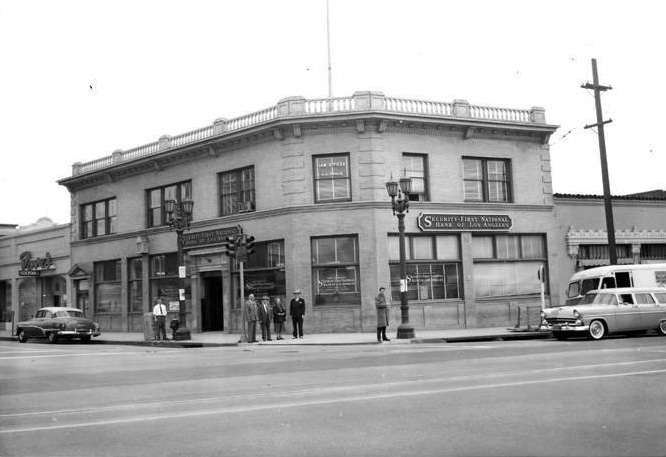 |
|
| (1955)^.^ – View showing the Security First National Bank of Los Angeles located on the corner of Glendale Avenue and Broadway. |
Historical Notes This building was lost to the 1971 Sylmar Earthquake. |
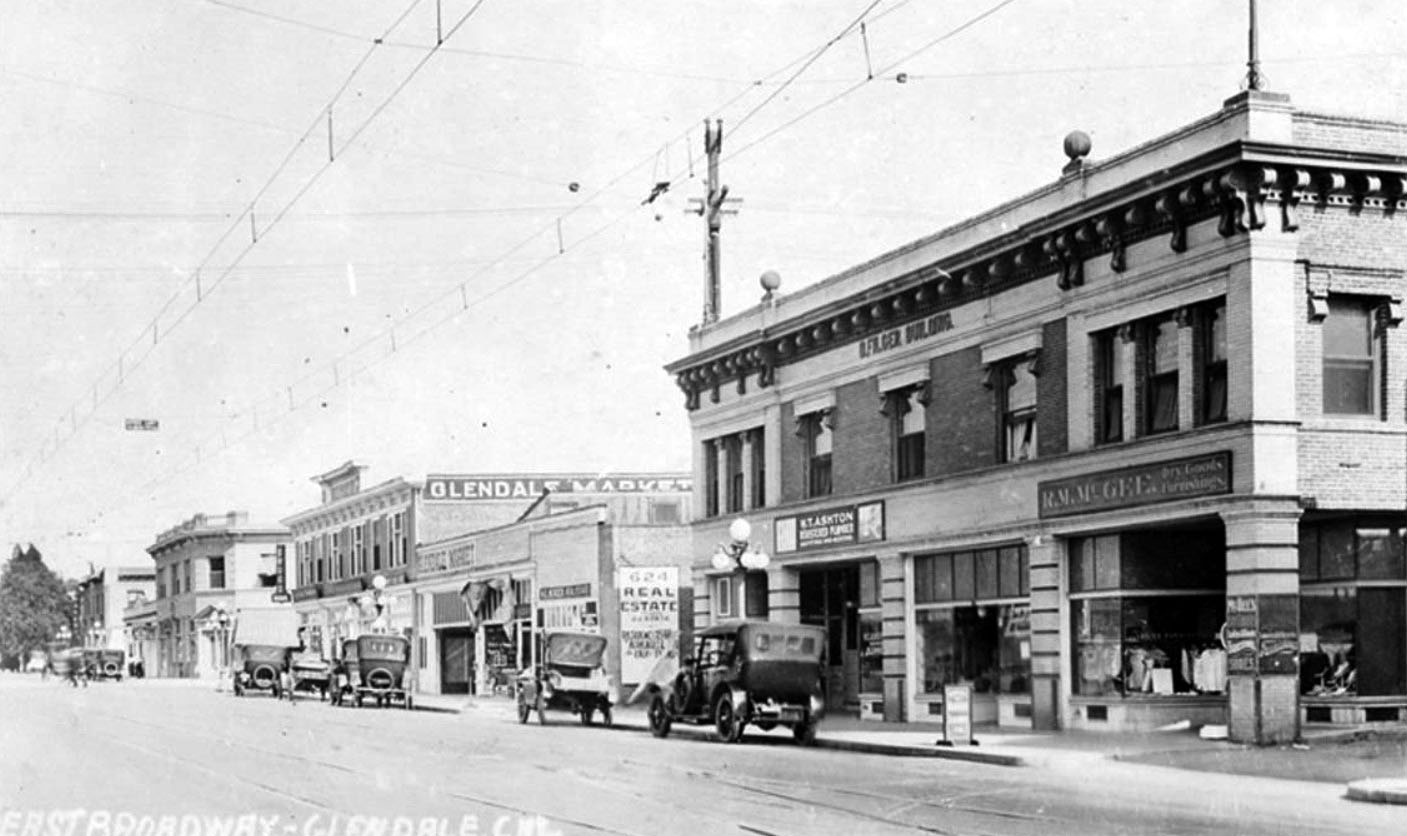 |
|
| (1921)##^ – View showing cars and businesses, including the D. Filger Building and the Glendale Market, along East Broadway in Glendale. The wires and tracks of the Pacific Electric Railway are visible running down the middle of the street. The Pacific Electric local line ran along East Broadway from Brand Boulevard to Chevy Chase Drive. In the distance can be seen the Pacific Southwest Trust and Savings Bank building on the SE corner of Glendale and Broadway. |
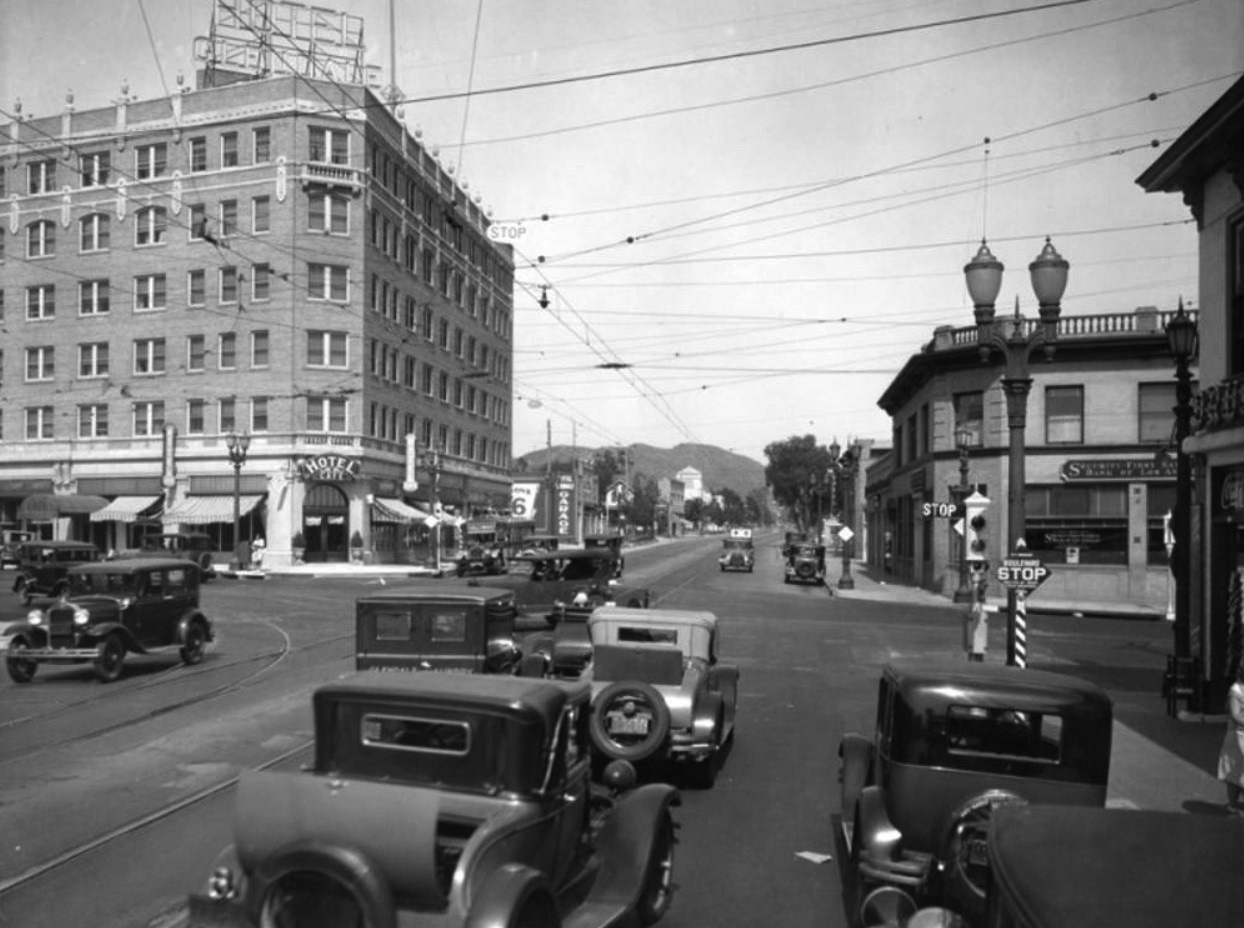 |
|
| (ca. 1928)* – View showing the intersection of Broadway and Glendale Avenue, looking east. On the southeast corner is a branch of Security-First National Bank of Los Angeles. On the northeast is a hotel and cafe. A semaphore traffic signal is seen on the corner (center-right). A car with a rumble seat can be seen in the foreground. |
* * * * * |
Terminal Market
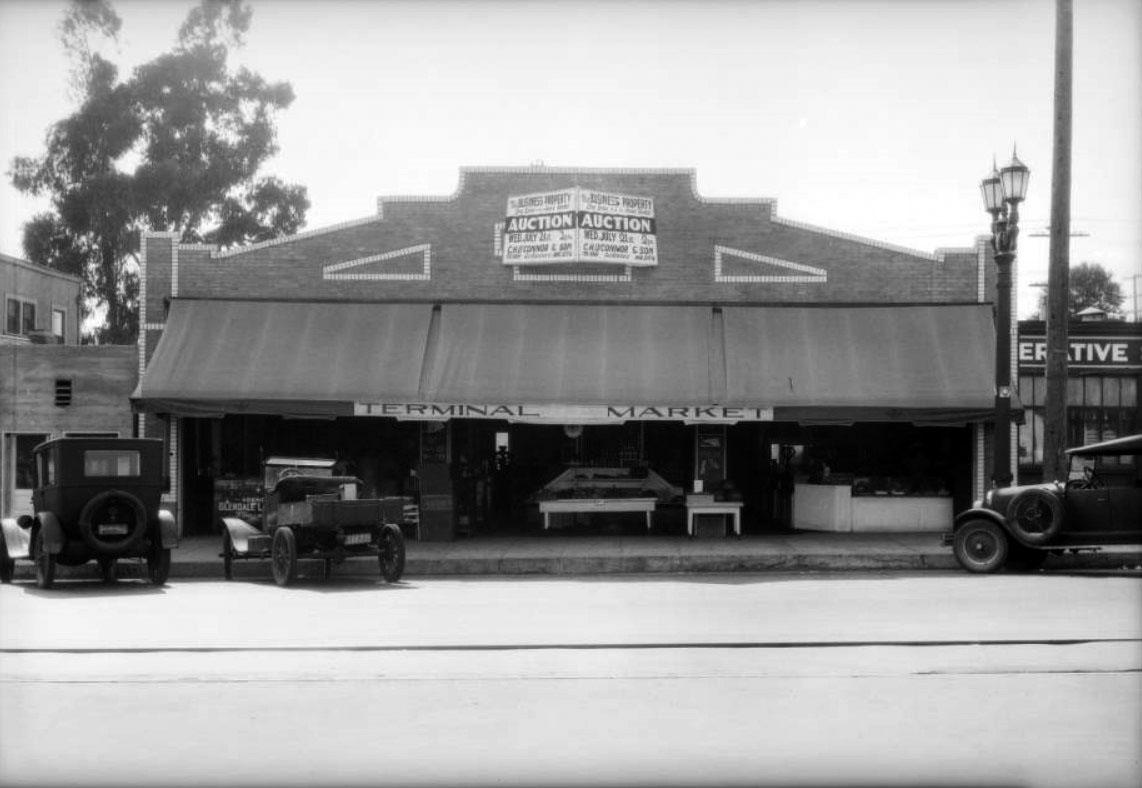 |
|
| (1926)^^ - View showing cars parked in front of Terminal Market at 123 North Glendale Avenue, Glendale. |
Tropico and Glendale
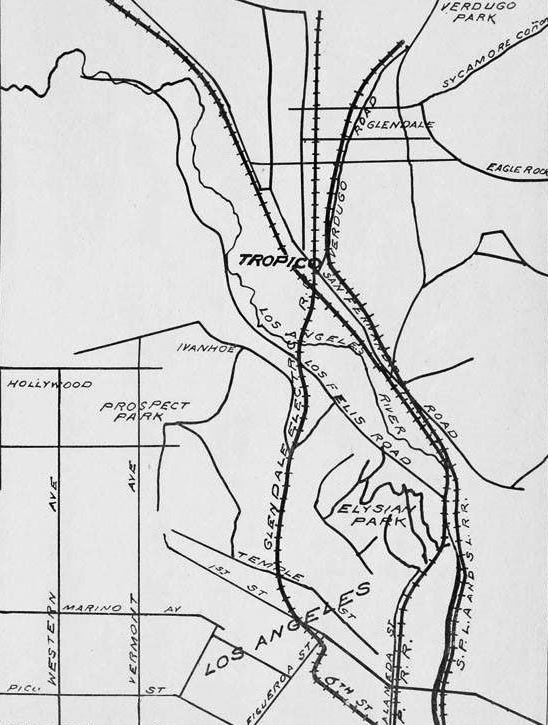 |
|
| (1903)^ – A map of Tropico showing rail lines and surrounding area. |
Historical Notes Tropico was put on the map as a fertile agricultural spot in the late 1800s. Shortly thereafter, the town began distancing itself from the rest of Glendale. In 1918, the neighborhood formally succeeded in becoming an independent entity for a short time. |
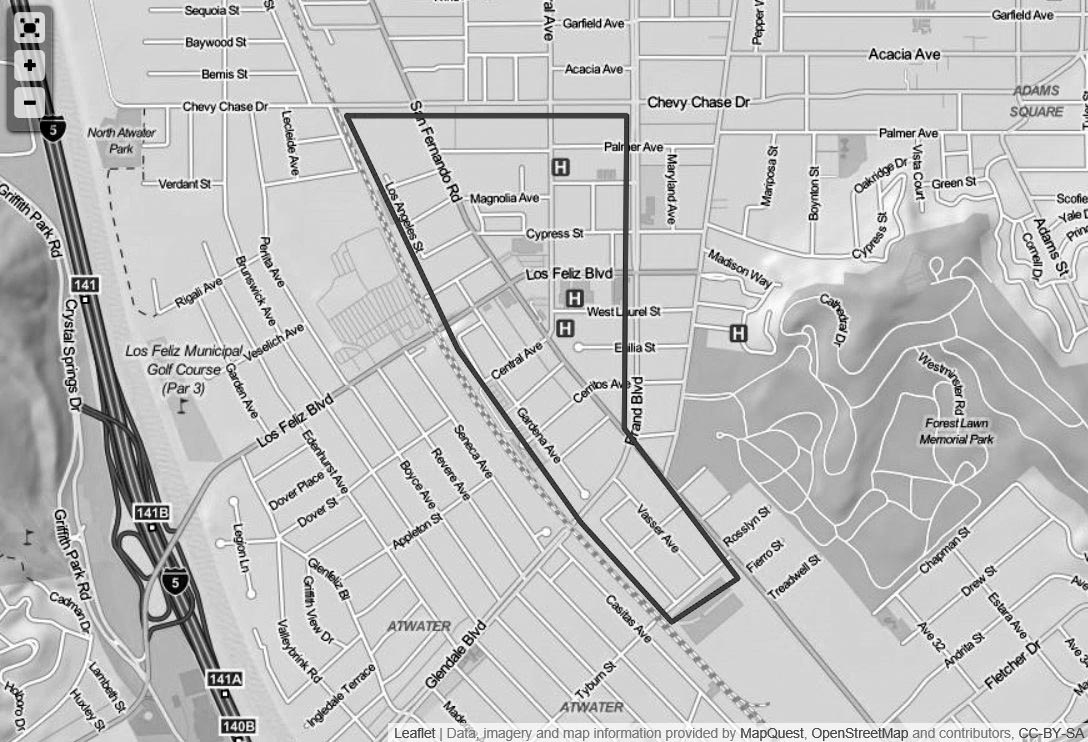 |
|
| (n.d.)*^ – Map view showing the boundaries of Tropico. |
Historical Notes Tropico was the name of the southern portion of Glendale, south of Windsor Road, between the late 1800s and 1918. The name "Glendale" had originated in the 1880s and was utilized north of Windsor Road. Political factions had divided the town in two. By the turn of the century, the commercial center of Tropico was at Central and San Fernando Road and its population was 700.* |
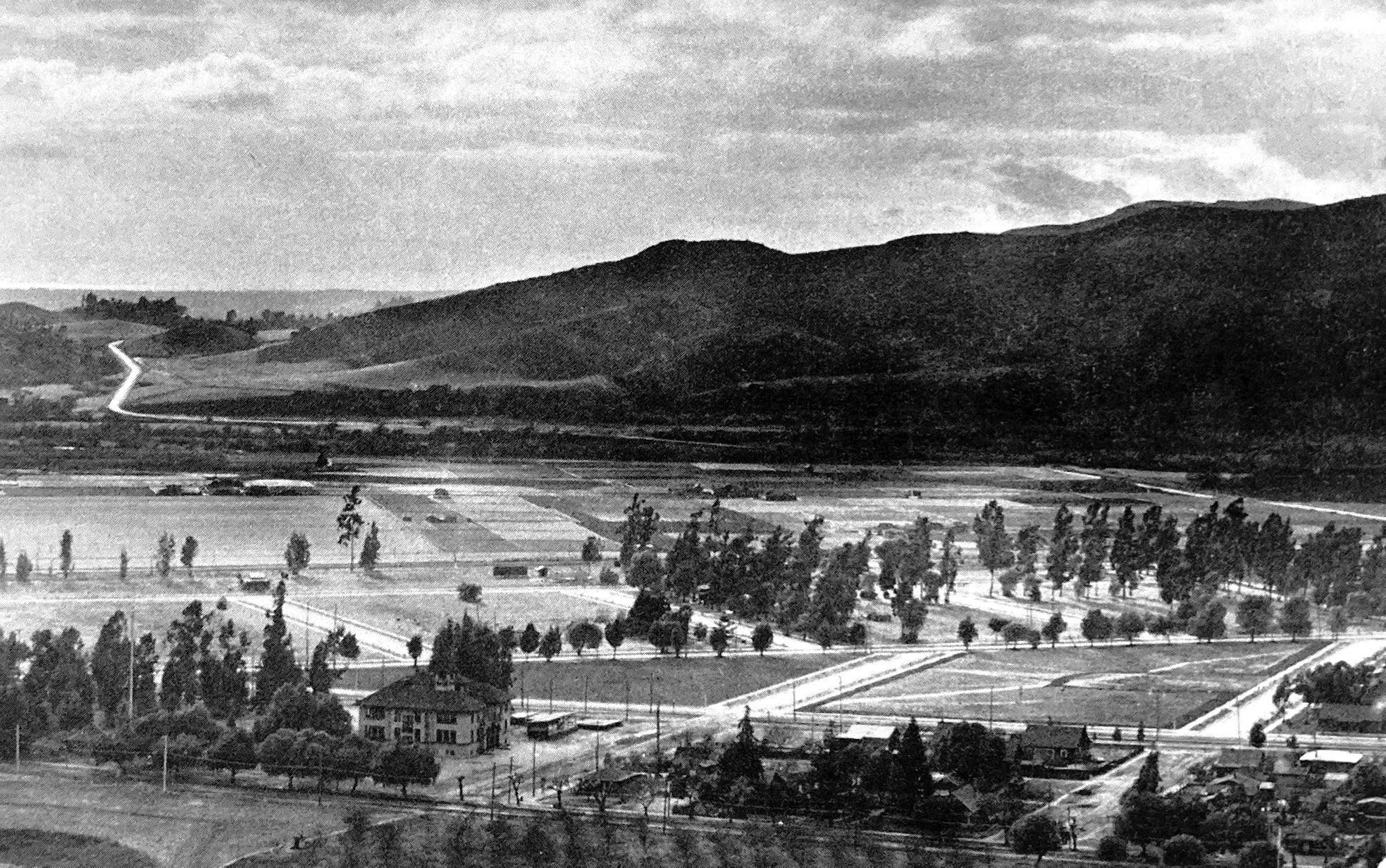 |
|
| (1910)^ - View of Tropico looking southwest to the Pacific, from the lower slopes of what would become Forest Lawn Memorial Park, Glendale. Photo by Edward Weston. |
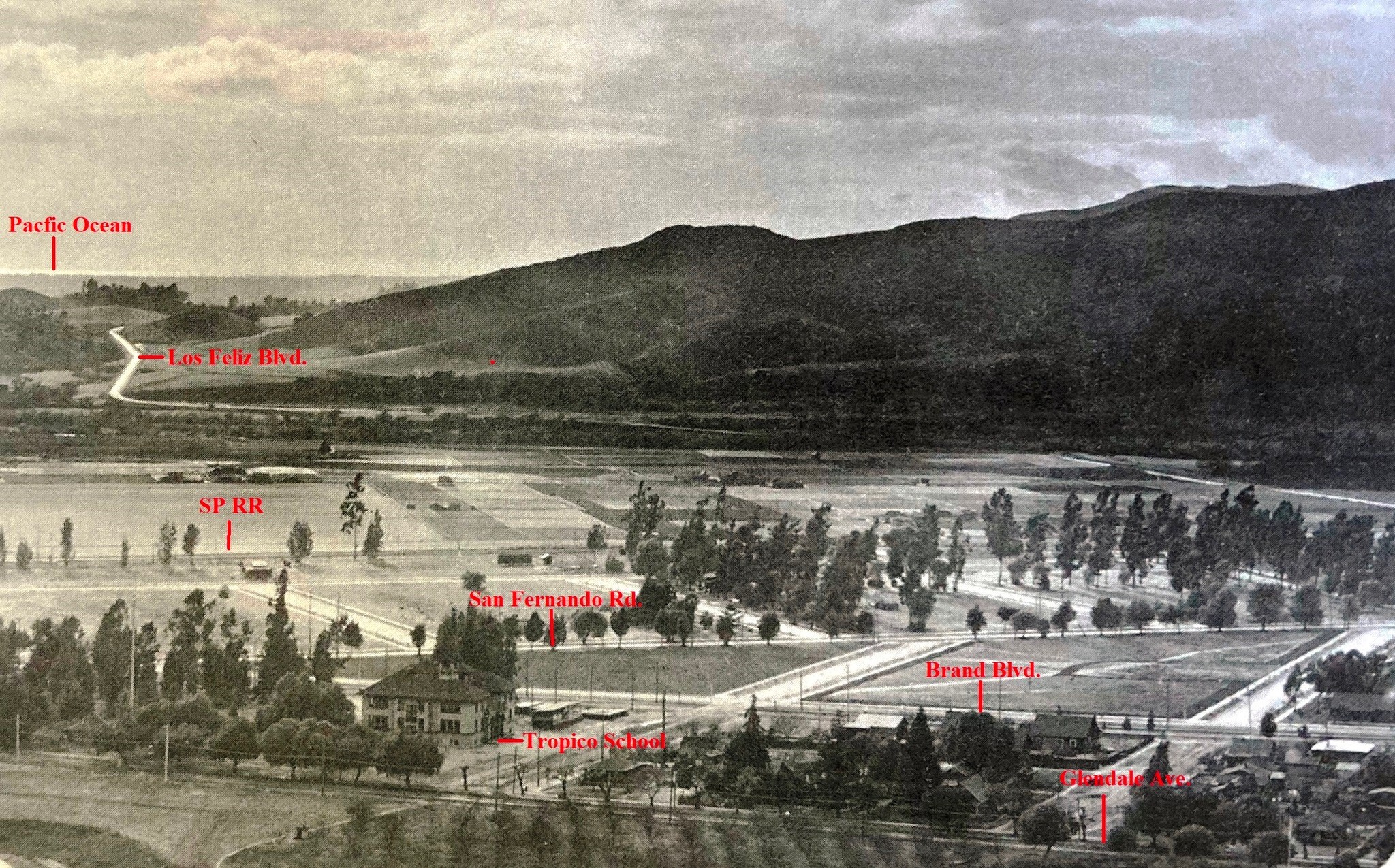 |
|
| (1910)^ - View of Tropico looking southwest to the Pacific, from the lower slopes of what would become Forest Lawn Memorial Park, Glendale. Annotated by Paul Ayers |
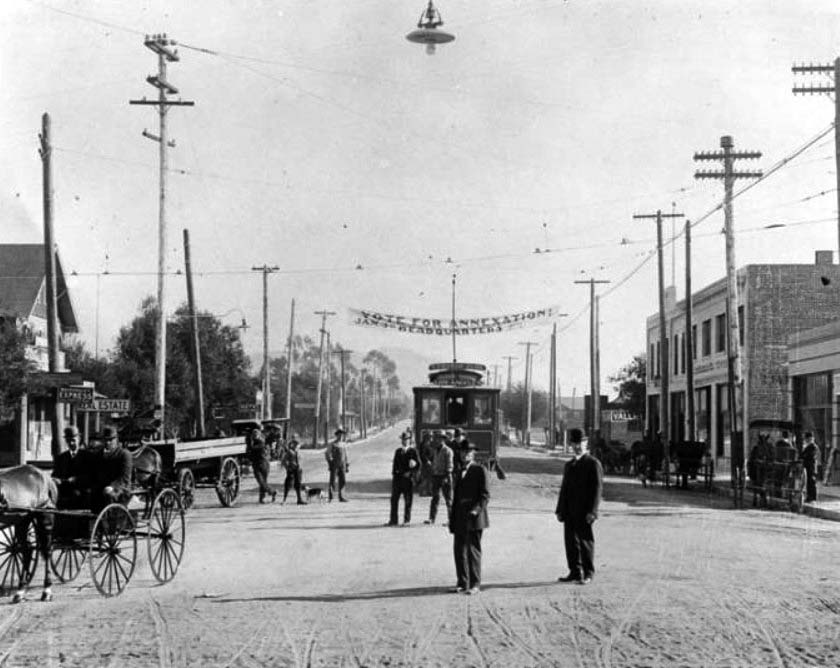 |
|
| (1911)^ – A banner in support of the annexation of Tropico to Glendale in 1911 hangs outside the measure's headquarters on Broadway near Brand Boulevard in Glendale. The measure failed to pass, with Tropico instead voting for its own incorporation as a city. The issue would be revisited in 1918, when the upper half of Tropico would become a part of Glendale. |
Historical Notes Tropico was just a sleepy little village in the early 1900s. The business district included a few wooden buildings containing a general store, a blacksmith shop, meat store, livery stable, real estate offices and a few other small concerns. The buildings were all clustered near the intersection of San Fernando Road and Central Avenue. But within a few short years, the wood-frame buildings were replaced with brick, business boomed and the community became vibrant. The Tropico Art Tile Works stood just west of the railroad tracks, employing many people, and Tropico also became the shipping center for the strawberries raised in the area. Because of its proximity to Los Angeles, the area became a popular residential spot. The Tropico Chamber of Commerce organized in 1910, along with the Bank of Tropico, and soon the community realized it needed a city government. With so many of its residents commuting into Los Angeles, many favored annexing to Los Angeles. Others, seeing Glendale's successful example of home rule, wanted to be part of Glendale, which had incorporated in 1906.^ |
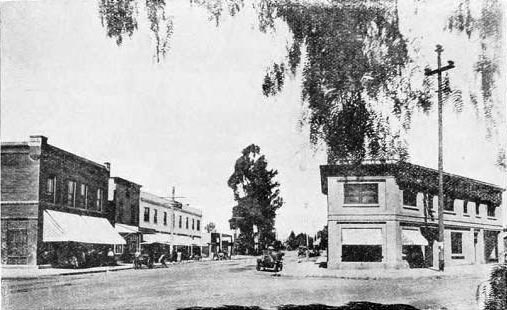 |
|
| (1910s)^ - View looking N/W on San Fernando Road at Central Ave with the Bank of Tropico located on the triangular lot at right. |
Historical Notes With so many of its residents commuting into Los Angeles, many favored annexing to Los Angeles. Others, seeing Glendale's successful example of home rule, wanted to be part of Glendale, which had incorporated in 1906. They felt that since the two communities were adjacent and in the same valley, they should be affiliated. Those favoring annexation with Glendale (mainly in the northeast part of Tropico) approached Glendale officials in 1911 and asked that an election be called. The publishers of the Tropico Sentinel vehemently opposed annexation, and the issue failed. Instead, Tropico incorporated as its own city, with Elkanah W. Richardson, son of Tropico's founder, W.C.B. Richardson, serving as a member of the board of trustees. The new city government immediately embarked on a badly needed improvement of the roads, but the annexation issue didn't go away. Petition after petition was filed, each one eventually failing, until finally, in 1918, the annexation proposal passed. The upper half of Tropico voted to go with Glendale, and the lower half voted to merge with Los Angeles. Today, that portion makes up the area known as Atwater.^ |
 |
|
| (1915)^ - View looking N/W on San Fernando Road at Central Ave, Tropico. |
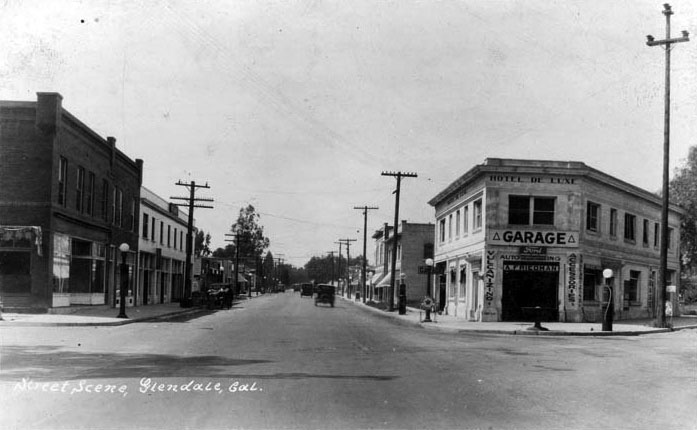 |
|
| (1920s)^*# - View looking N/W on San Fernando Road at Central Ave after Tropico was annexed into the city of Glendale This is the same intersection as previous photo but about 10 years later. The building housing the Bank of Tropico is now Hotel de Lux and a Garage. Note the gas pumps along the curb. Click HERE for contemporary view. |
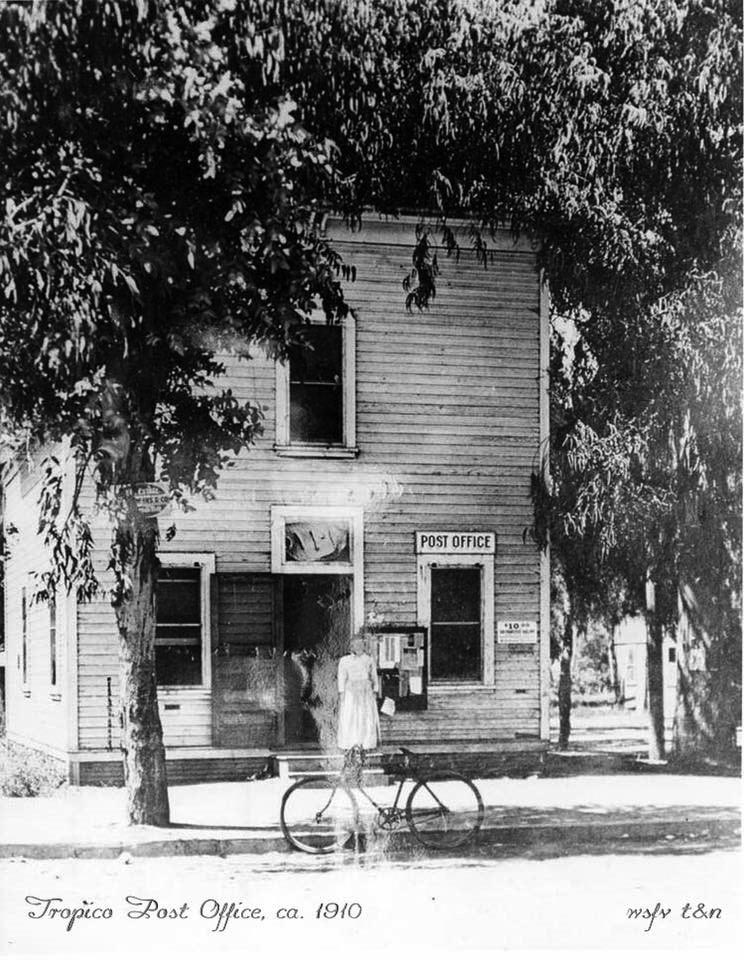 |
|
| (ca. 1910)^ – View showing a woman standing in front of the Tropico Post Office, with a bicycle parked by the curb. |
Historical Notes The Tropico Post Office building was owned by WCB Richardson and was located near the corner of Central Avenue and San Fernando Road. |
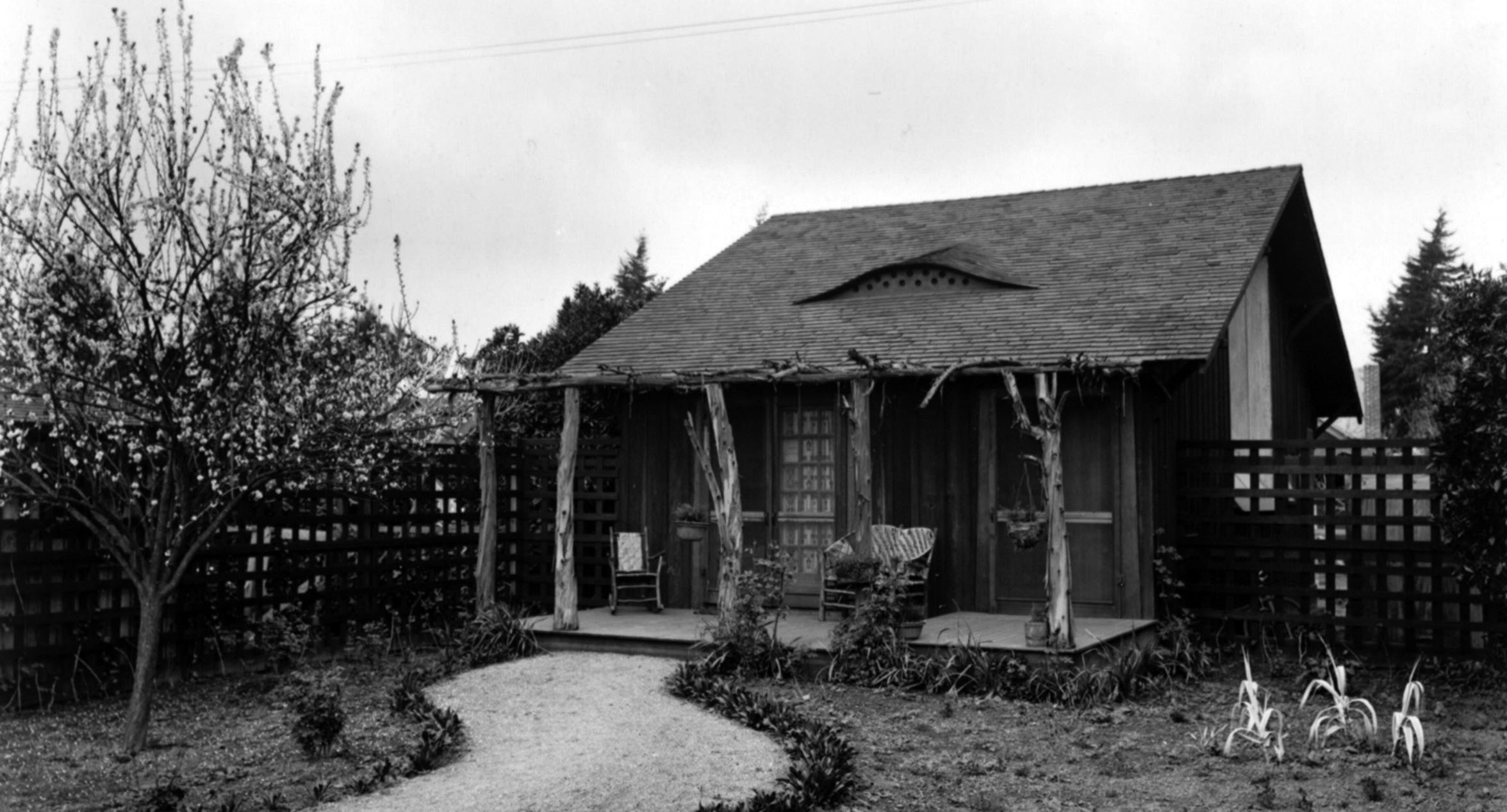 |
|
| (1915)* – Studio of famous photographer Edward Weston, located in Tropico. |
Historical Notes Edward Henry Weston has been called "one of the most innovative and influential American photographers..." and "one of the masters of 20th century photography." Over the course of his 40-year career Weston photographed an increasingly expansive set of subjects, including landscapes, still-lifes, nudes, portraits, genre scenes and even whimsical parodies. It is said that he developed a "quintessentially American, and especially Californian, approach to modern photography" because of his focus on the people and places of the American West. In 1937 Weston was the first photographer to receive a Guggenheim Fellowship. In 1910 Weston opened his own business, called "The Little Studio", in Tropico. His sister later asked him why he opened his studio in Tropico rather than in the nearby metropolis of Los Angeles, and he replied "Sis, I'm going to make my name so famous that it won't matter where I live."* Weston photographed many of the early buildings and local events in Glendale. |
Then and Now
 |
|
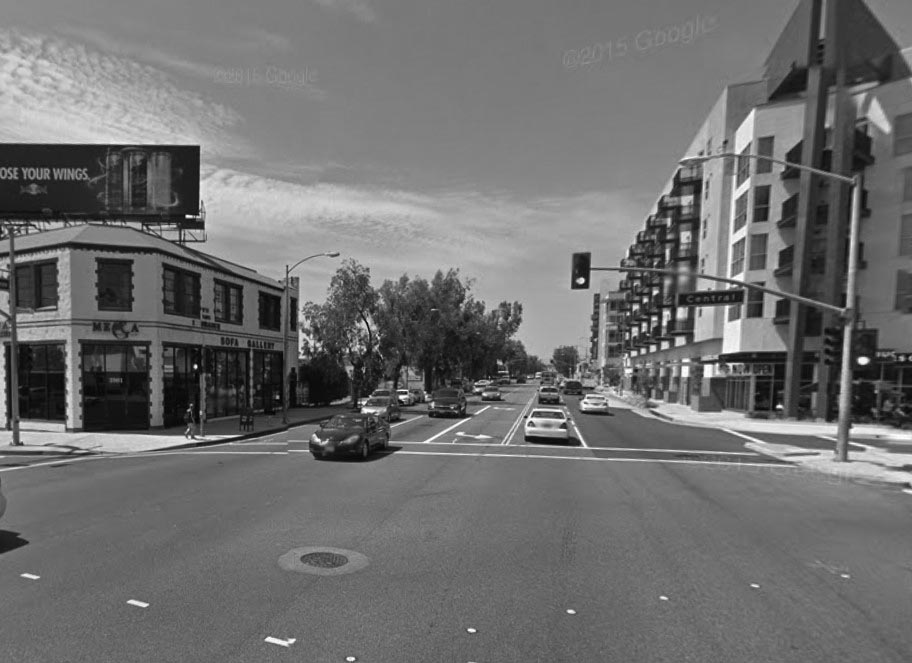 |
|
| (1910s vs. 2015)* – View looking N/W on San Fernando Road at S. Central Avenue. |
Then and Now
 |
|
| (1910s vs 2022)* - Looking N/W on San Fernando Road at S. Central Ave. |
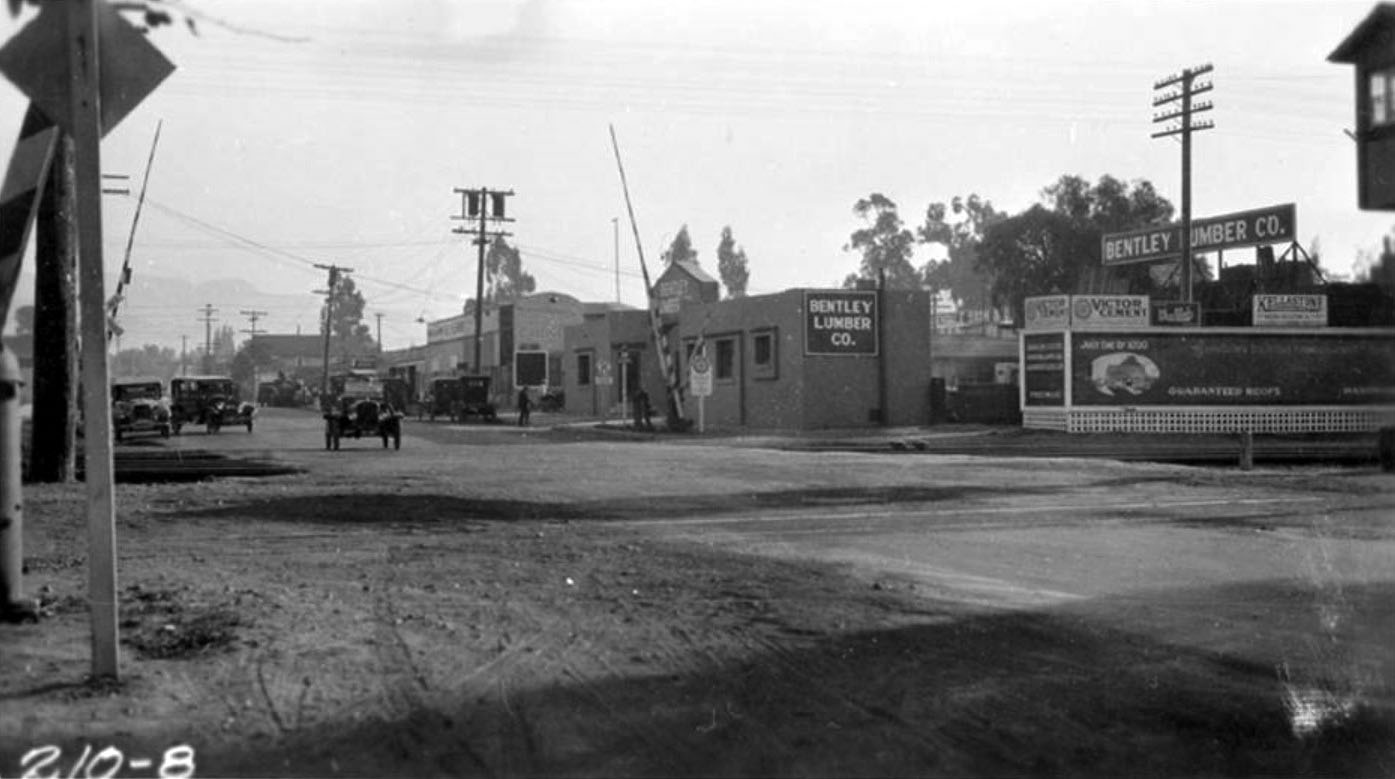 |
|
| (ca. 1921)^ - Southern Pacific Railway grade crossing in the Tropico area of Glendale. The city of Tropico was annexed by Glendale in 1918. Bentley Lumber Company is visible on the right. |
* * * * * |
Broadway Elementary School (today John Marshall Elementary School)
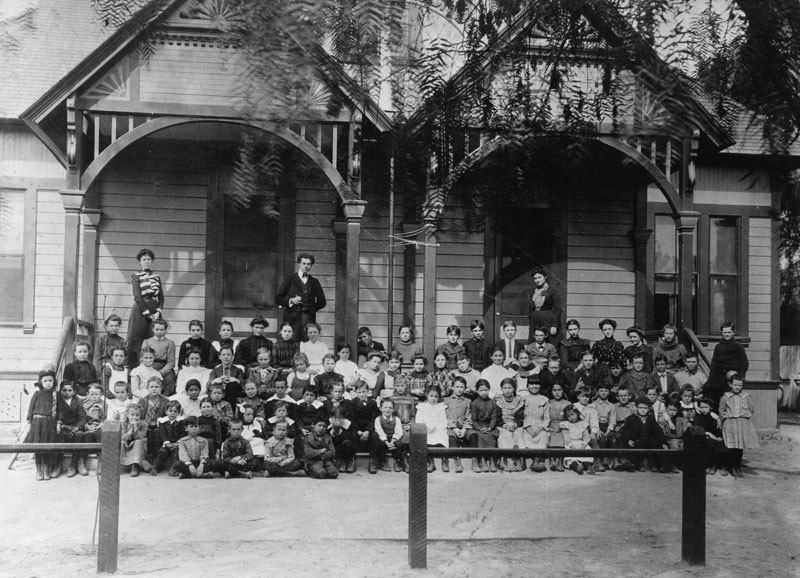 |
|
| (1902)^ - Group portrait of children and adults in front of the Broadway Elementary School located at Broadway and Chevy Chase since 1887. John Marshall Elementary School stands at this site today. |
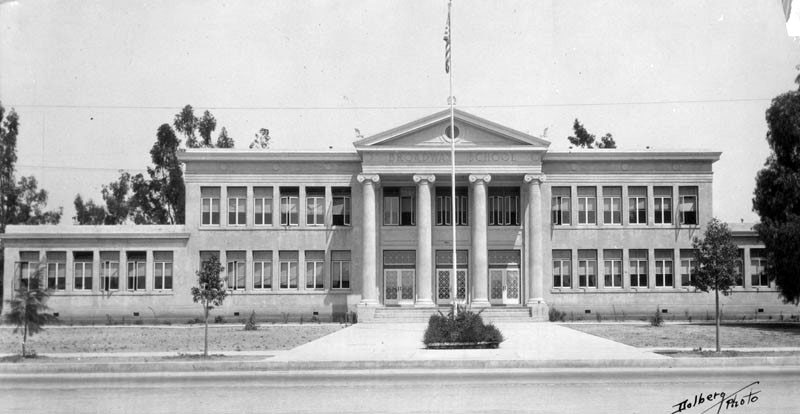 |
|
| (n.d.)^ - Picture postcard of the exterior view of Broadway School, which has been located on the same site at Broadway and Chevy Chase since 1887. The school has undergone five different name changes, the current being John Marshall Elementary School, in memory of U.S. Supreme Court Justice John Marshall, and the present-day address is 1201 East Broadway. |
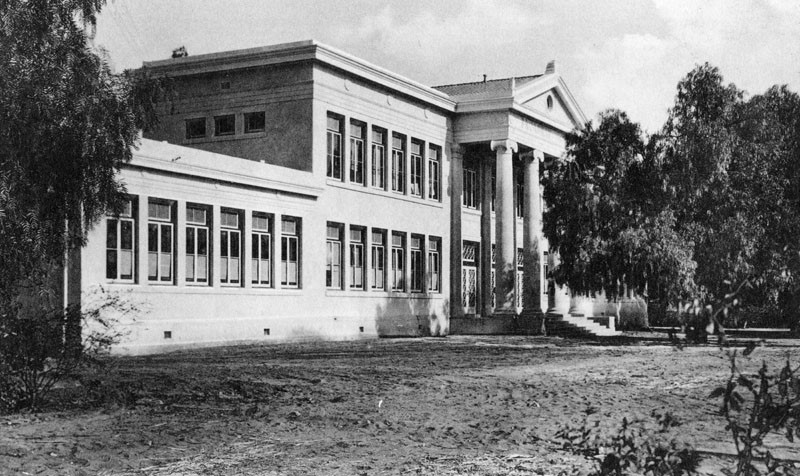 |
|
| (n.d.)^ - View showing the main entrance of Broadway School, located at Broadway and Chevy Chase in Glendale since 1887. For several years the main building had picturesque two-story pillars in front, resembling the White House. The pillars were demolished when the east and west wings were rebuilt in 1950. |
Glendale Police Department
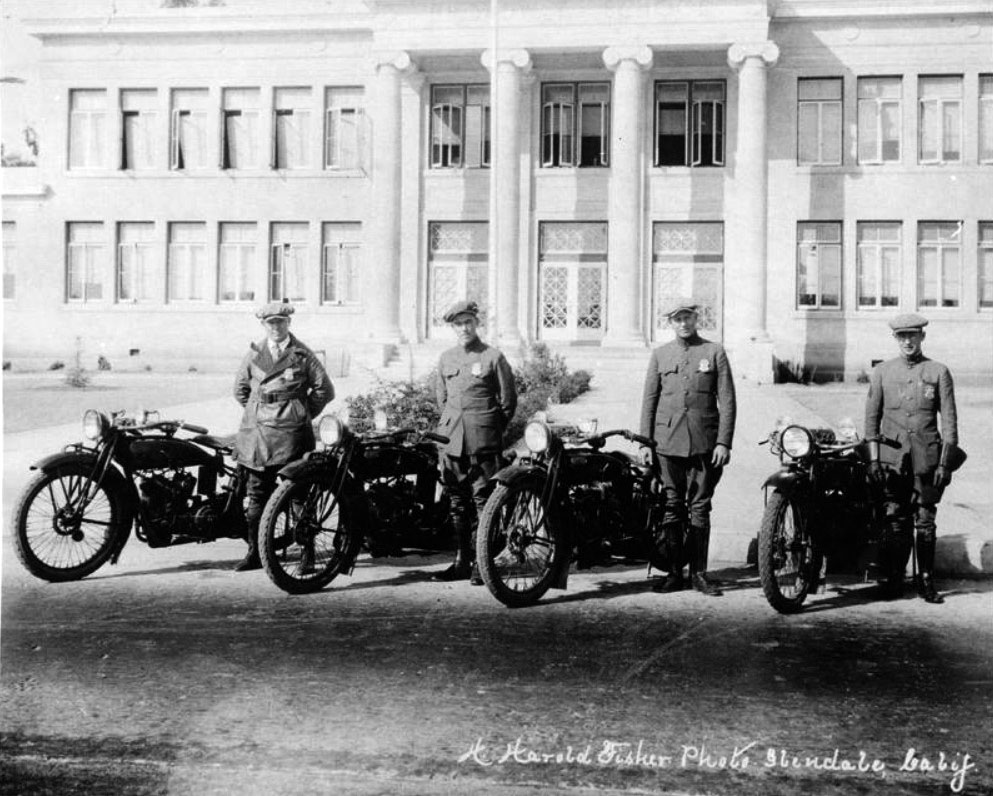 |
|
| (ca. 1919)* - Glendale Police Department Motor Division. Several members of the Glendale Police Department pose with their Indian motorcycles in front of Broadway Elementary School. |
 |
|
| (1920s)* - A man named Wykoff receives a traffic ticket from a member of the Glendale Police Dept. The photo shows a close-up of the policeman's Harley-Davidson motorcycle. |
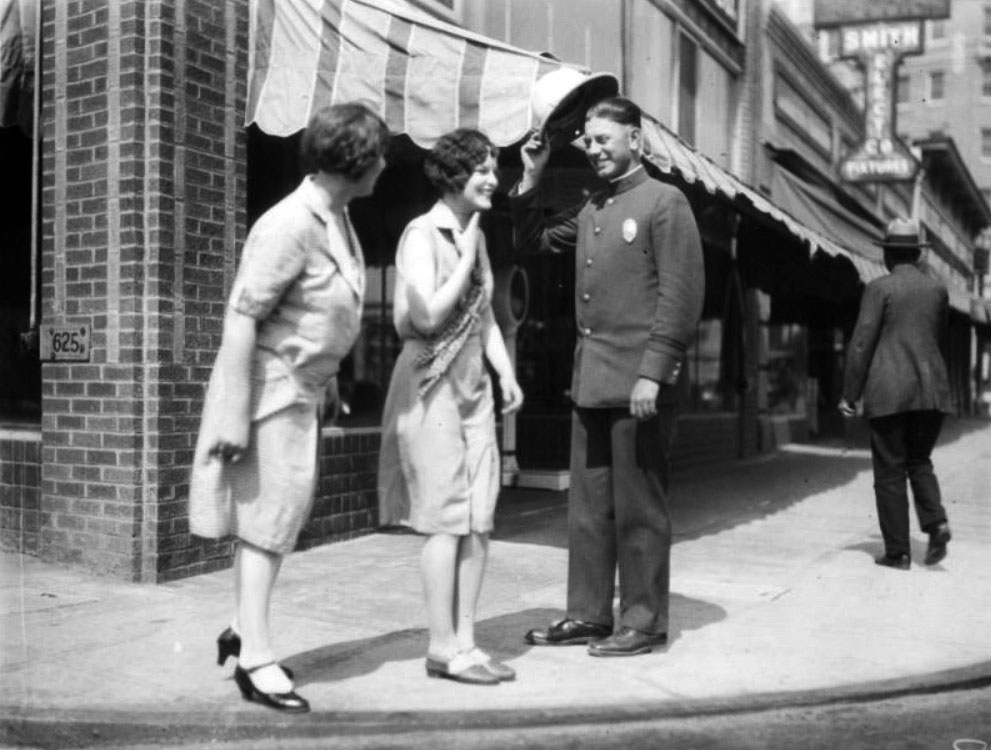 |
|
| (ca. 1920s)* - A member of the Glendale Police Dept. tips his hat to two women on Broadway, in front of Smith Electric Co. |
Historical Notes Click HERE to see more Early Views of the Glendale Police Department (1938 +). |
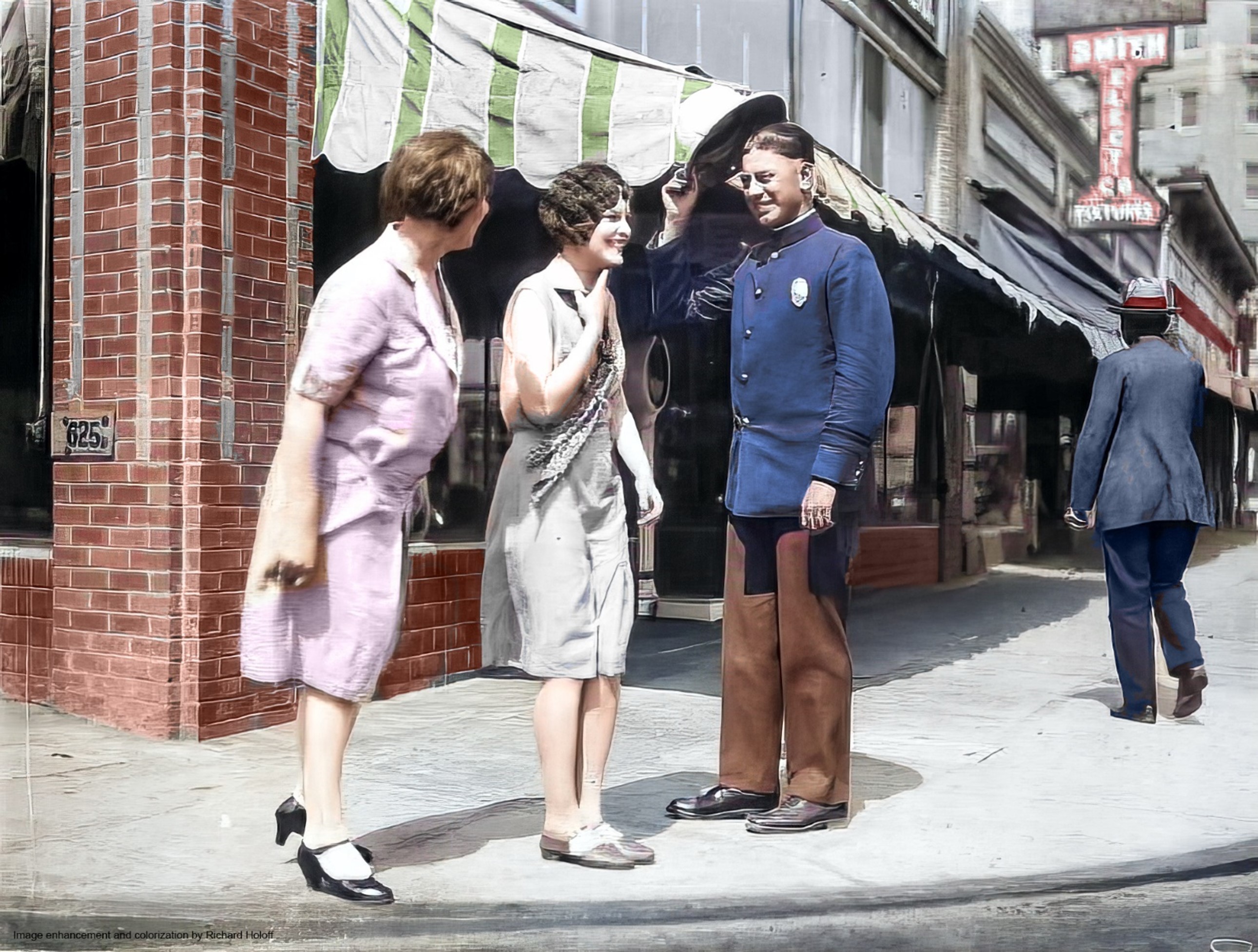 |
|
| (ca. 1920s)* - A member of the Glendale Police Dept. tips his hat to two women on Broadway, in front of Smith Electric Co. Image enhancement and colorization by Richard Holoff |
Historical Notes Click HERE to see more Early Views of the Glendale Police Department (1938 +). |
Glendale City Hall
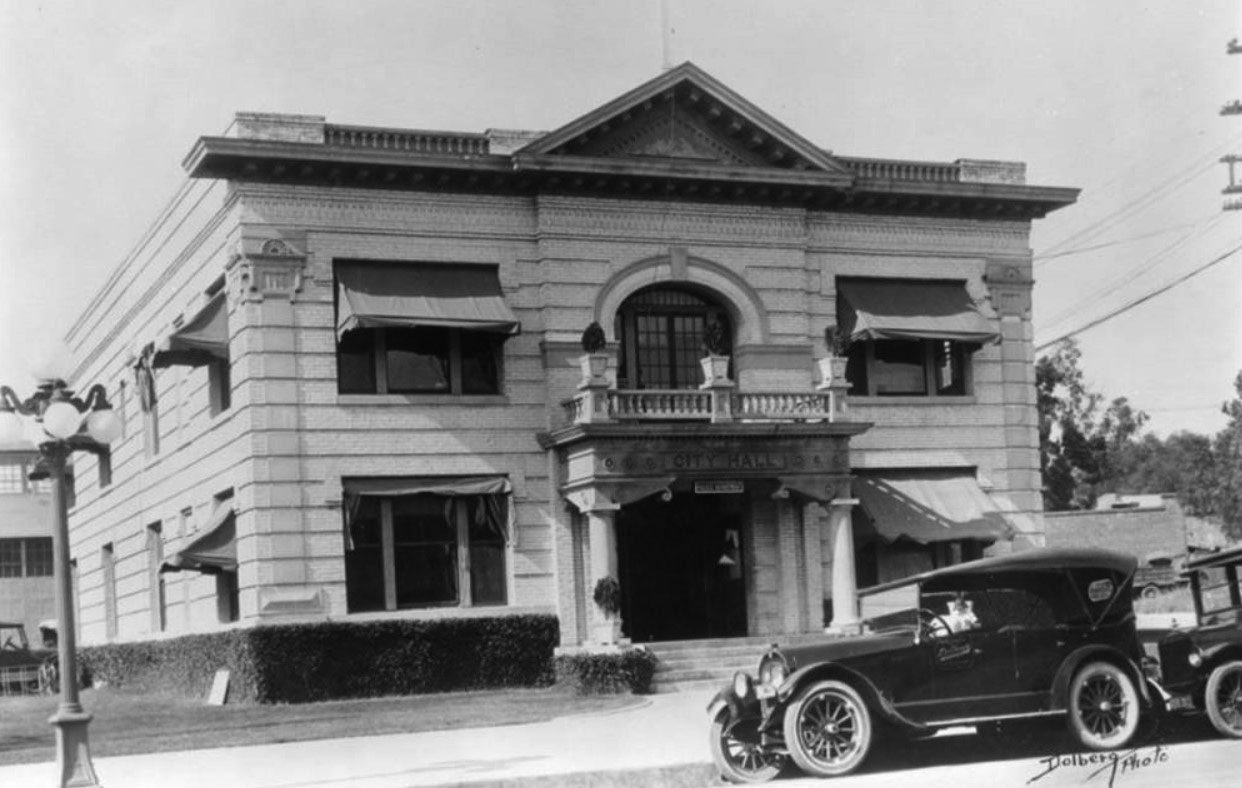 |
|
| (1920s)^ - Exterior view of Glendale's City Hall building which also houses its Police Department. Two large pillars stand on each side of the entrance. Note architecture at top and corners of this all brick building. |
Chevy Chase Drive
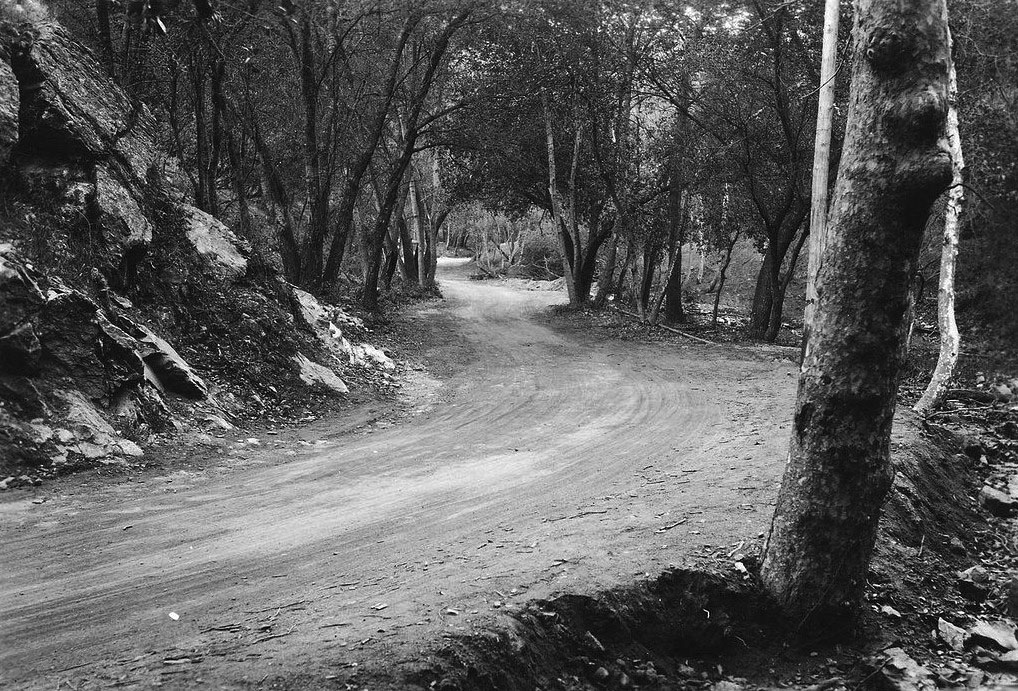 |
|
| (ca. 1915)^.^ – View showing Sycamore Canyon Road before it became Chevy Chase Drive. |
Historical Notes The name Chevy Chase actually comes from an ancient Scottish ballad called "The Ballad of Chevy Chase". The "chase" refers to a hunting party, and the "Chevy" is from the Cheviot Hills, which are located along the English/Scottish border. Some parts of Chevy Chase Drive were originally named Park Avenue and Sycamore Canyon, but in the mid 1920's a real estate agent named E.R. Austin worked to create an additional entrance into Glendale from Los Angeles and was able to convince L.A. and Glendale officials to change the name of this route to Chevy Chase Drive for the entire length of the street, as well as extend the street in various places. All this combining of names and extending made Chevy Chase Drive the longest street in Glendale.^ |
East Broadway
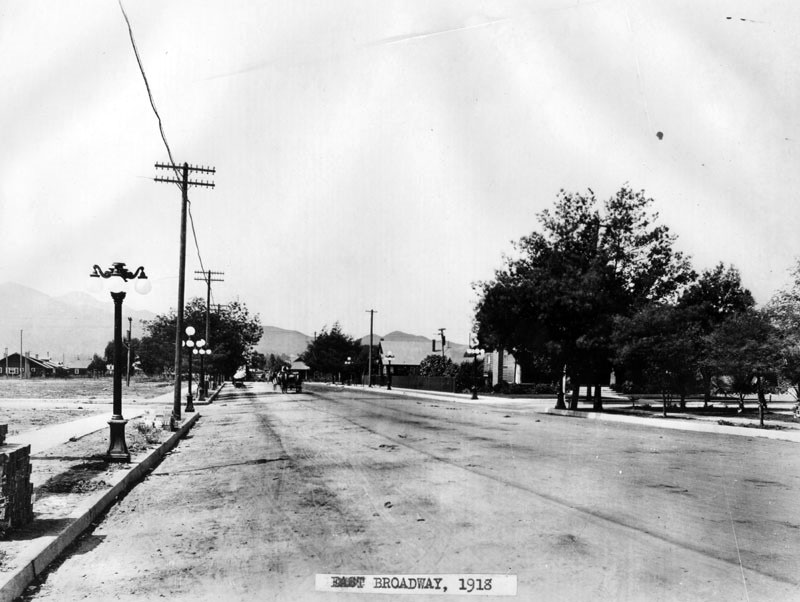 |
|
| (1918)^ - View of E. Broadway looking west at Orange in Glendale. This is near where the Glendale Galleria is today. Note the ornate streetlights. Click HERE to see map. |
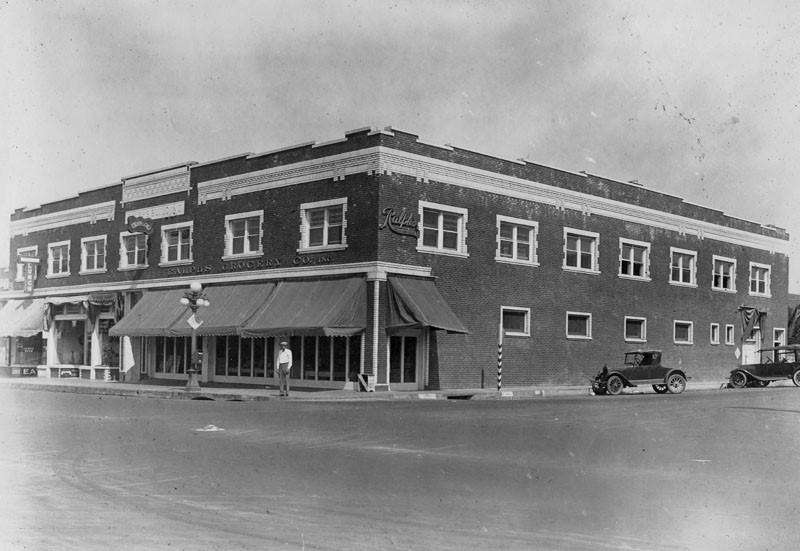 |
|
| (ca. 1920)^ – A man stands on the corner of Orange and Broadway in front of the Ralphs grocery store. |
Aurora Market
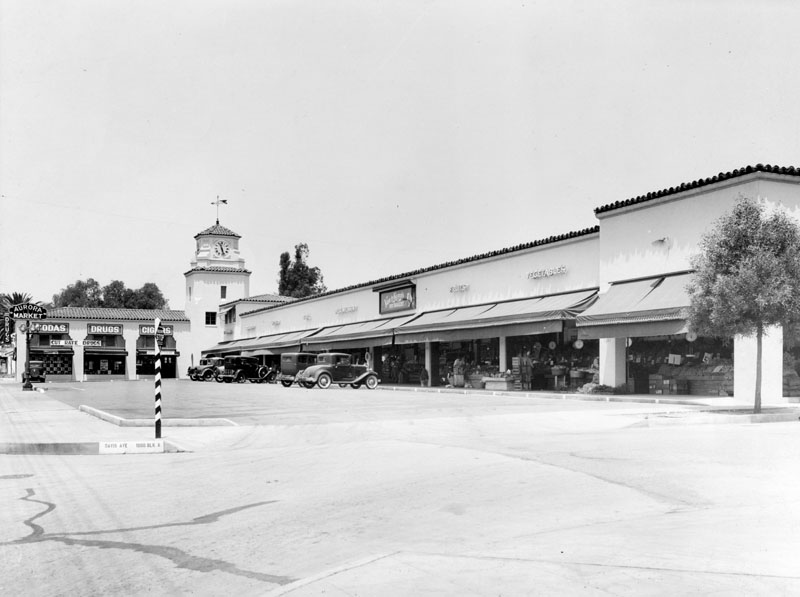 |
|
| (1920s)^ - View of Aurora Market located in a plaza at the corner of Davis Avenue, in Glendale. Note the clock tower in the corner of the 'L' shaped drive-in market. |
Historical Notes Southern California was the principal center for the development of drive-in markets between the mid-1910s to the early 1940s. Other notable early drive-in markets included: Mandarin Market (Hollywood), Plaza Market (LA), and the Sunset Clock Market (Beverly Hills). |
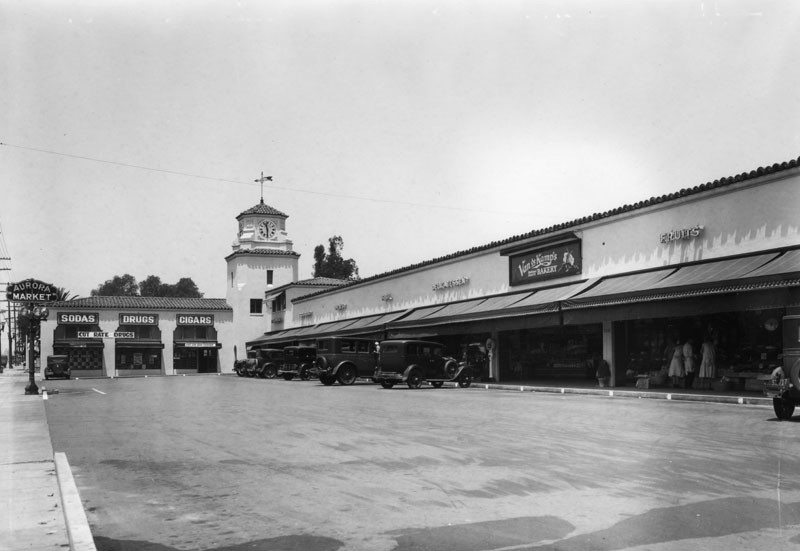 |
|
| (1920s)^ - Close-up view showing drive-in Aurora Market with a Van de Kamp's Bakery seen on the right next to a florist. |
Los Feliz and San Fernando
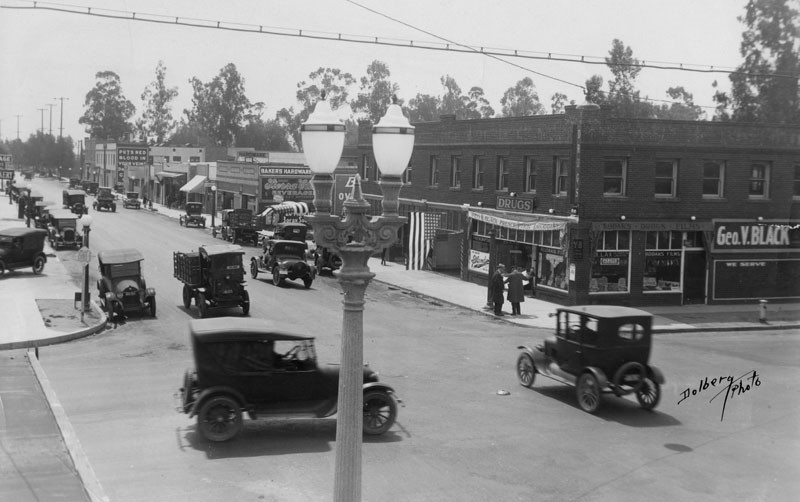 |
|
| (ca. 1920)^ - Looking south at an intersection of Los Feliz Blvd. and San Fernando Rd. Various cars and trucks are traveling on the street. There are businesses on right side of the street some include: "Geo. V. Black prescription Druggist" and "Baker's Hardware". Note the ornate dual-lamp streetlight. Click HERE to see more Early Streetlights. |
Historical Notes Los Feliz Boulevard in Glendale was formerly called Tropico Boulevard. ^ |
 |
|
| (ca. 1920s)^ - A view of San Fernando Rd. looking north at an intersection of Los Feliz Blvd. Various cars and trucks have stopped at the intersection. There are businesses that run along both sides of the street some include: a drug store, a sports equipment store, the "Piggly Wiggly", "Tavern Buffet", "Glenwood Hotel" and a service station with gasoline pumps. |
Glendale Union High School
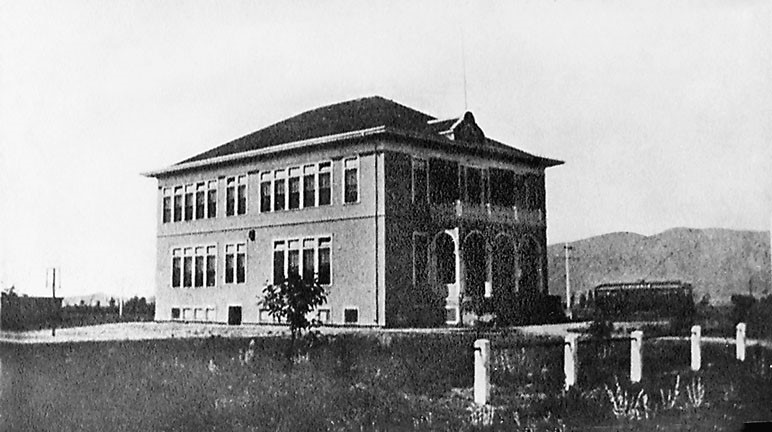 |
|
| (1902)^* – View showing the two-story frame school house known as "The Cheesebox" (because of its distinctive yellow color), constructed on the southeast corner of Brand and Broadway, opposite the present site of the Glendale Security Building. |
Historical Notes Glendale Union High School was founded in 1901 by the residents of the villages of Glendale, La Crescenta, Burbank, Eagle Rock, Ivanhoe, Tropico and West Glendale. The first classes were held at the Glendale Hotel. The first principal was Mr. Llewellyn Evans and the school had two teachers and 29 students. The next year, a new school building (seen above) was built at the corner of what is today Brand Boulevard and Broadway.*^ |
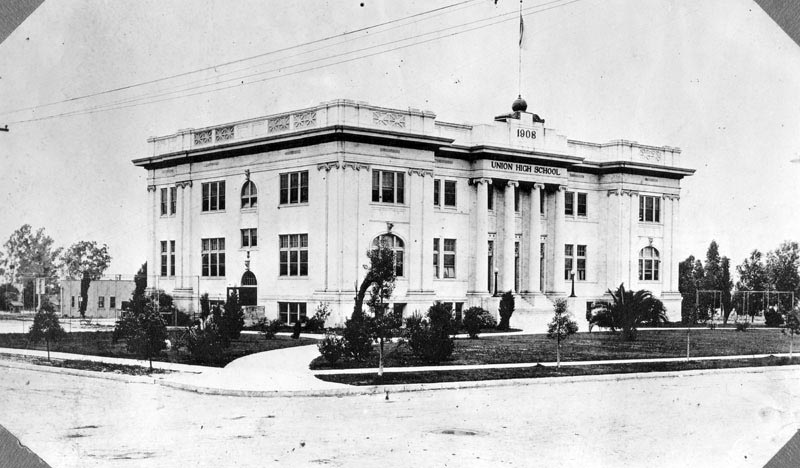 |
|
| (ca. 1909)^ – View showing Glendale Union High School at its second location, on Harvard Street, where the Glendale Public Library stands today. |
Historical Notes Erected in 1908, Glendale Union High School was located on Harvard Street in Glendale. The building was a two-story, pressed brick building facing Harvard. This marked the first departure of wooden school houses in Glendale. In 1913, three acres were added to the site and two more buildings were constructed.^ |
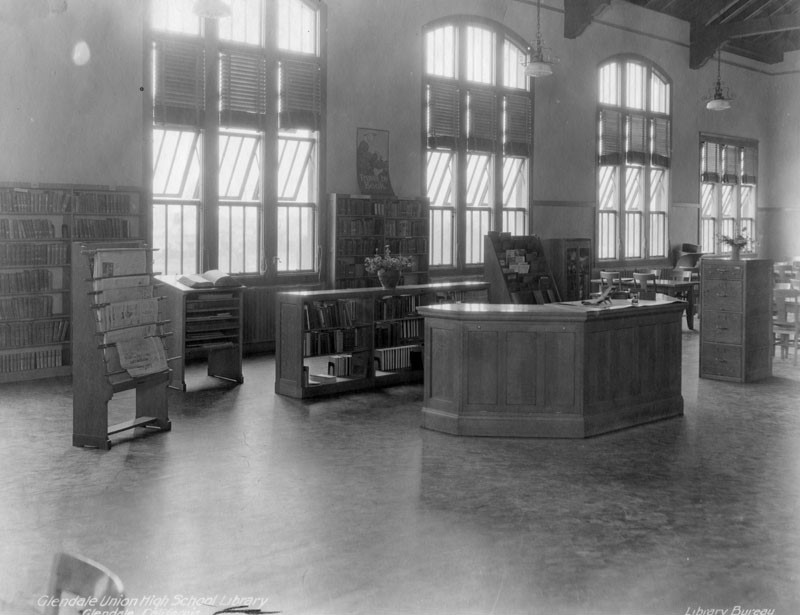 |
|
| (ca. 1920s)^ - Interior view of the Glendale Union High School library. Book shelves can be seen along the back wall. Also visible are a newspaper rack, dictionary stand, shelving behind the information desk, magazine rack, wooden file cabinet, and tables and chairs. |
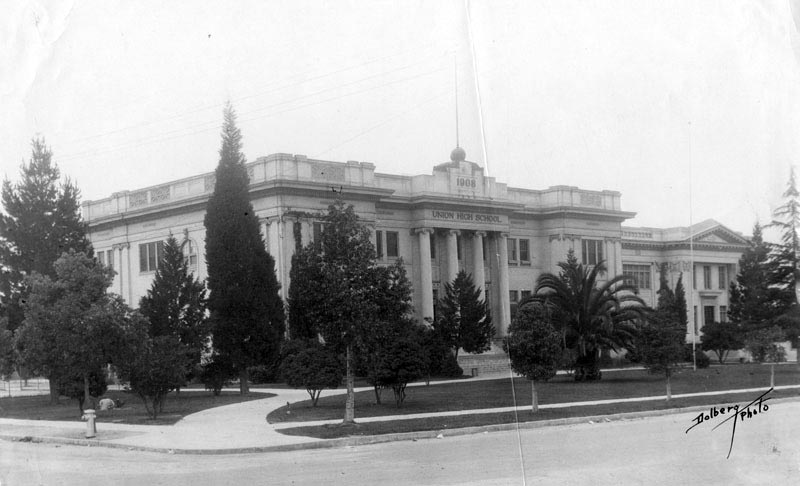 |
|
| (ca. 1920)^ - View of Glendale Union High School located on Harvard Street in Glendale. Glendale High School is now located at 1440 East Broadway. |
Historical Notes The school continued to grow, as enrollment reached 800 in 1920 and 1,050 in 1921. It was decided then to move the Grade 10, 11 and 12 classes to a new campus at the corner of the present-day Broadway Avenue and Verdugo Road. The school has remained in this location (1440 East Broadway, at the southeast corner of Verdugo) since 1924.*^ |
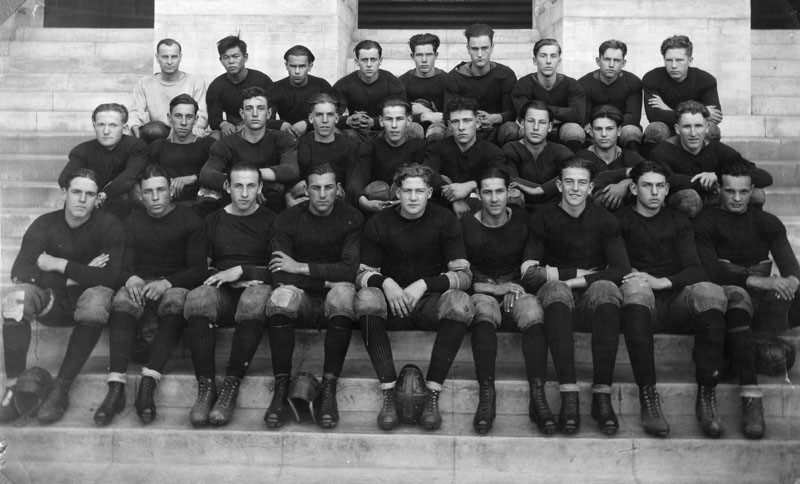 |
|
| (ca. 1924)^ – The Glendale Union High School football team picture. The football helmets seen between some players' feet look extremely pliable. |
Historical Notes From the 1920's thru 1940's helmets always were strictly of leather construction, and were not mandatory until the 1930's. One member of this Glendale football team, Marion Morrison, seated in the front row, third from the right, nicknamed "Duke", was a star football player, Senior class president, and sports editor of the school newspaper. "Duke" Morrison graduated in 1925, stumbled into acting, and later became known as John Wayne. ^ |
* * * * * |
El Miradero
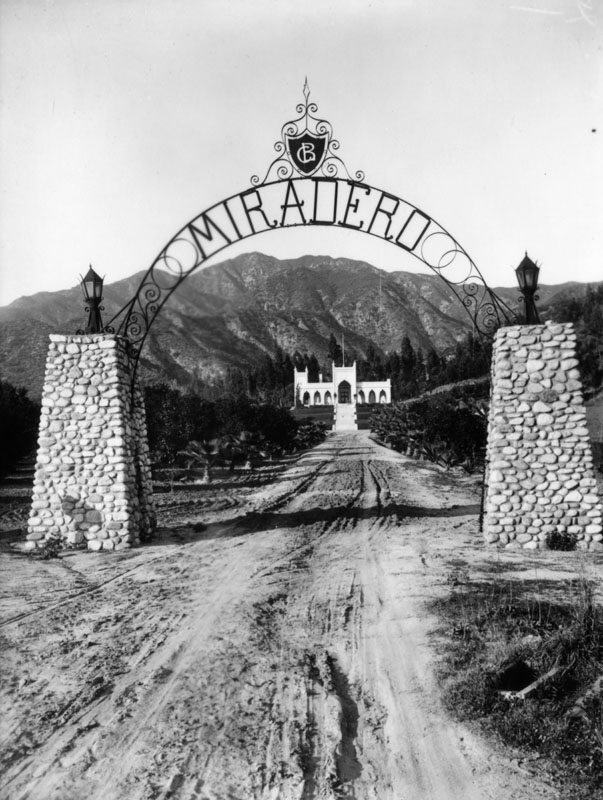 |
|
| (ca. 1904)^ - View of El Miradero, the estate of Leslie C. Brand, as seen from the entrance gates of the property. |
Historical Notes Born in Missouri in 1859, Leslie Coombs Brand became the sole provider for his family at age 11. In 1886, Brand came to California to take advantage of its first boom period. #*#^ Brand was a major figure in the settlement and economic growth of the Glendale area. He had purchased land on the lower slopes of Mount Verdugo overlooking the city, and in 1904 built an imposing residence that became known as Brand Castle, also El Miradero (which today houses the Brand Library).*^ |
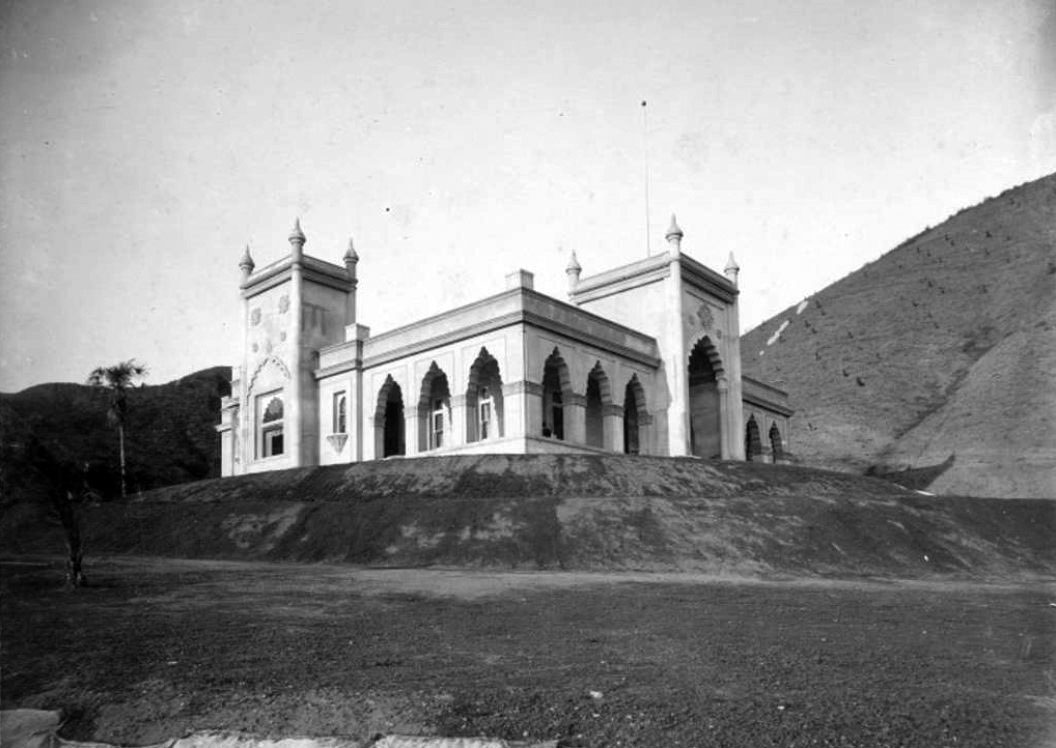 |
|
| (1904)^*# – West side view of the newly constructed ‘El Miradero’, home of Leslie C. Brand. |
Historical Notes Designed by Leslie C. Brand's brother-in-law Nathaniel Dryden, the mansion was completed in 1904 and is similar in style to that of the East Indian Pavilion built for the 1893 Columbian World Exposition held in Chicago. The architecture is considered Saracenic, with crenellated arches, bulbous domes and minars combining characteristics of Spanish, Moorish, and Indian styles.^ |
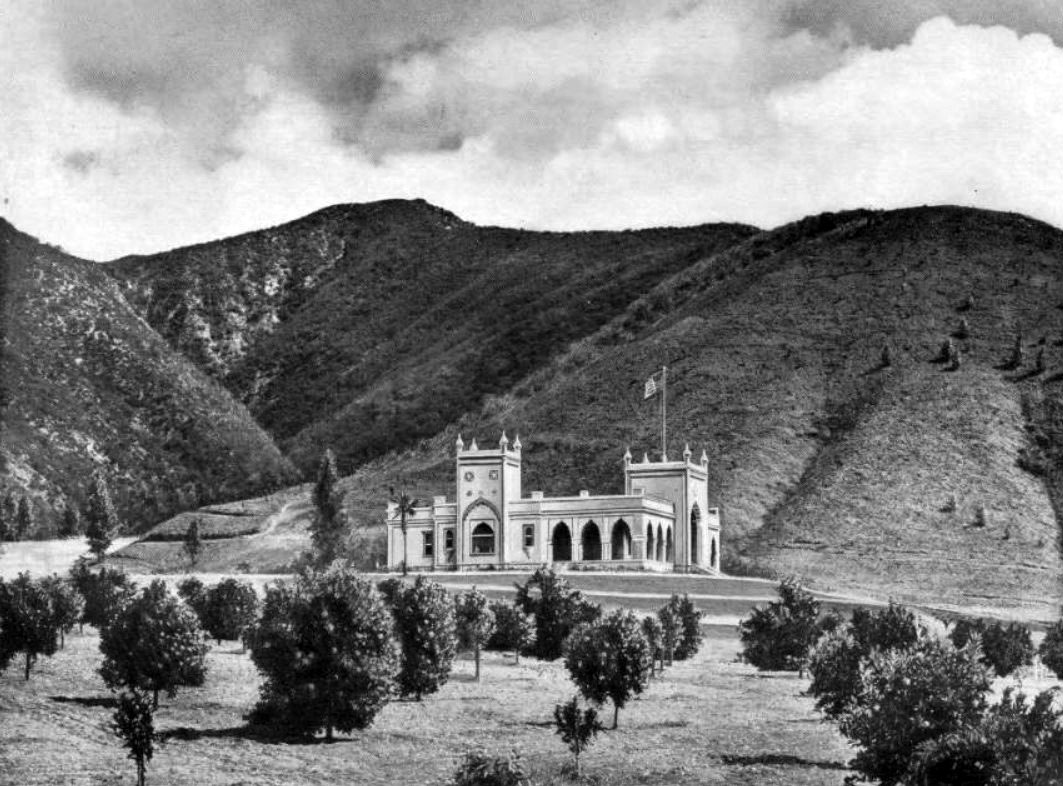 |
|
| (ca. 1906)^*# – View of El Miradero Mansion standing between orange groves in the foreground and the Verdugo Hills in the background. |
Historical Notes Leslie C. Brand helped develop the city of Glendale. Together with Henry E. Huntington, he brought Pacific Electric to the town to develop it. The 'Brand Library' section of the Glendale Public Library is named in his honor. Brand Boulevard in Glendale is also named in his honor.*^ |
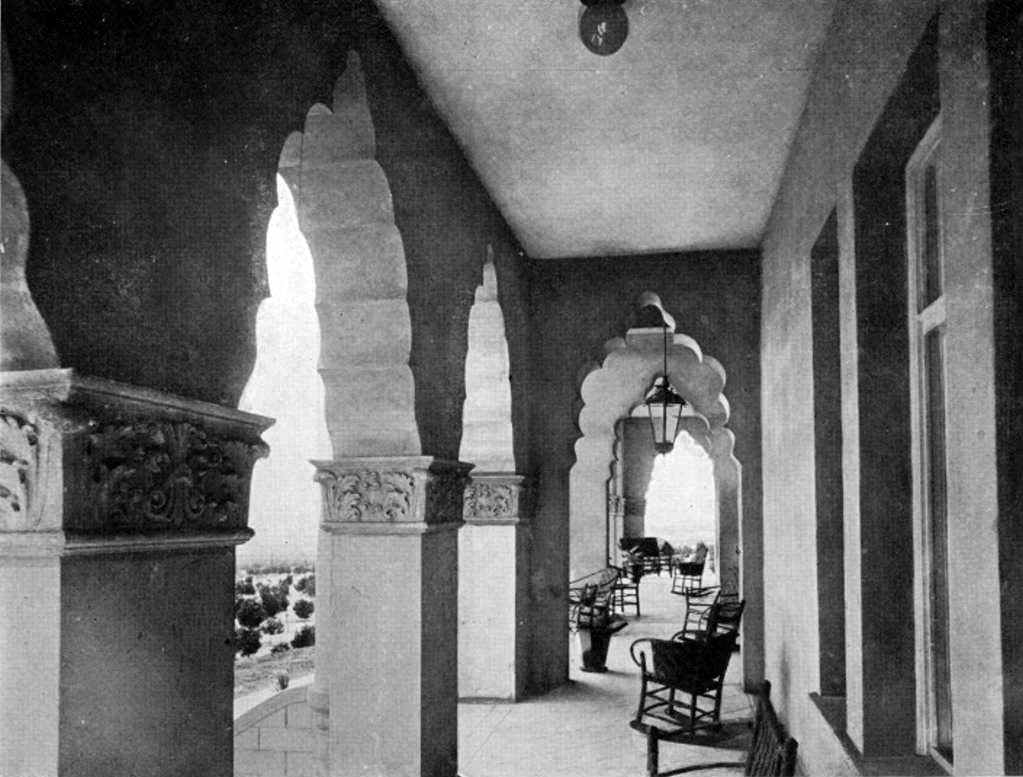 |
|
| (ca. 1906)##* - View of exterior porch of El Miradero (Brand Mansion) enclosed with a scalloped arched arcade. The porch is furnished with wicker chairs and potted plants. |
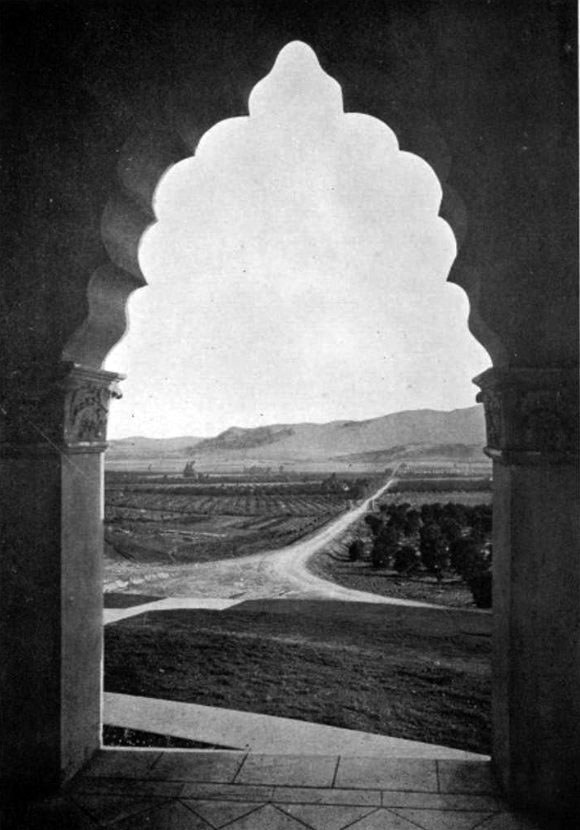 |
|
| (ca. 1906)^*# – View looking South over Glendale and Griffith Park toward Los Angeles through one of the many arches of ‘El Miradero’. |
Historical Notes Just across the mostly dry Los Angeles River, Brand could see the Griffith Park Aerodrome's grass field, built in 1912. Just three years later he decided to build his own grass airstrip below his mansion.*^ |
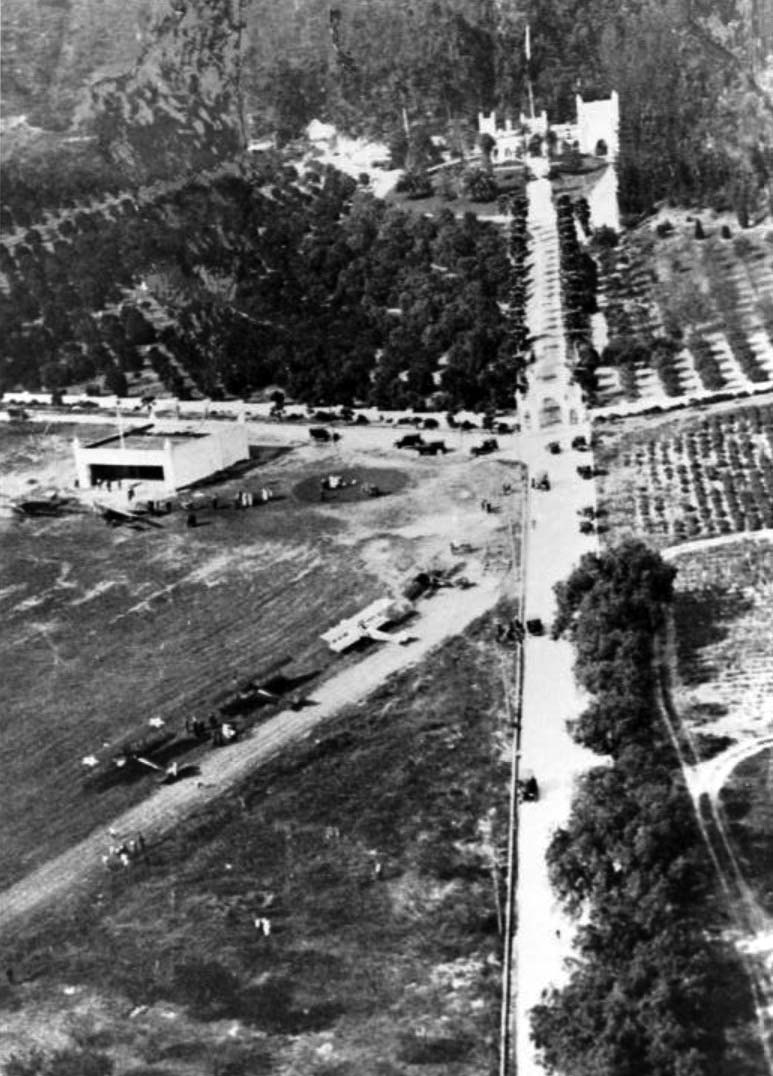 |
|
| (1921)***^ - An aerial view of L. C. Brand's airfield in front of his home, El Miradero in Glendale. The airplanes took off downhill toward Kenneth Road. |
Historical Notes Brand established a grassy, well-manicured airfield in front of the mansion. The airfield consisted of a 1,200' rolled dirt runway, with a white hangar at one end and a putting green on the other. The hangar matched the architectural style of the mansion - with turrets atop each of the 4 corners.*#*# |
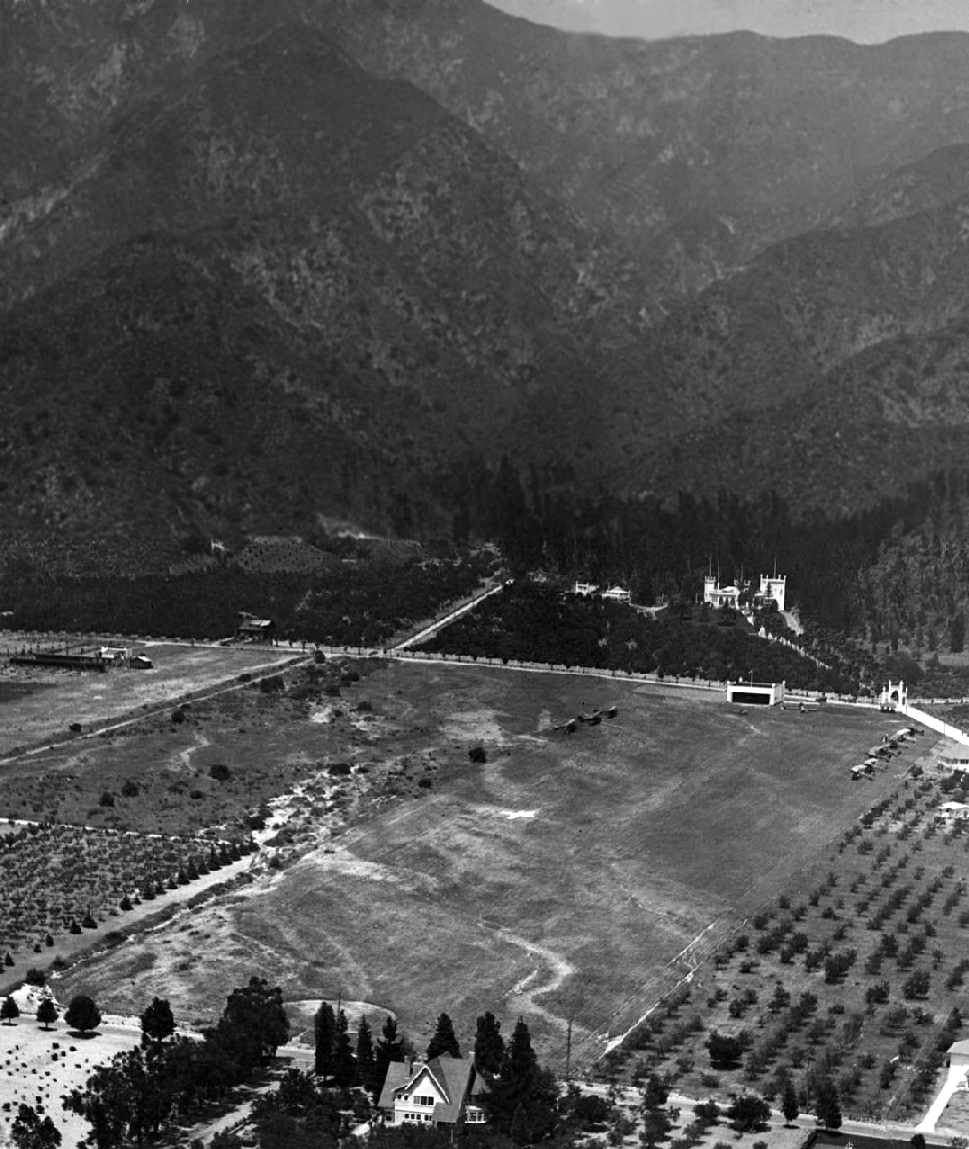 |
|
| 1923)*#*# – Aerial view looking north at Brand Field, showing the hangar and 10 aircraft on the field, and the mansion across the street. Note the steep terrain – obviously takeoffs to the north wouldn't be advisable. |
Historical Notes Only 3 aircraft are known to have been actually based at Brand Field. However, Brand apparently bought many war surplus Jennies, some to tinker with and fly as a sport, although most languished in storage buildings.*#*# |
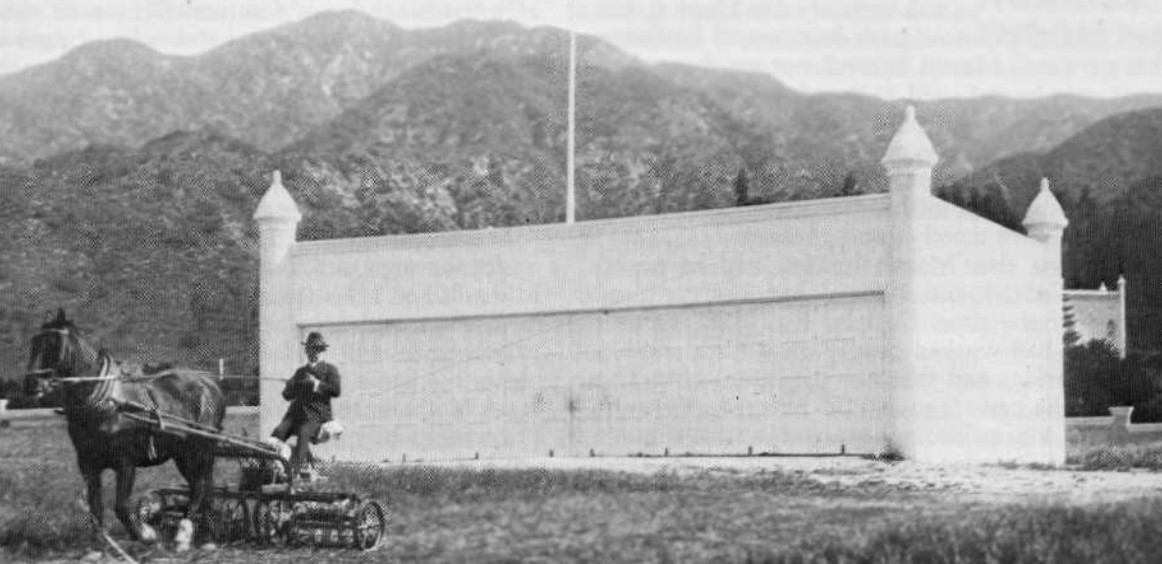 |
|
| (ca. 1920s)*#*# – View of millionaire Leslie C. Brand mowing the lawn in front of the Moorish-style hangar at his private Airfield. |
Historical Notes Brand built his first hangar in 1916 and put together a fleet of planes, and held fly-in parties. The only requirement was that guests had to arrive in their own planes and bring passengers.*^ |
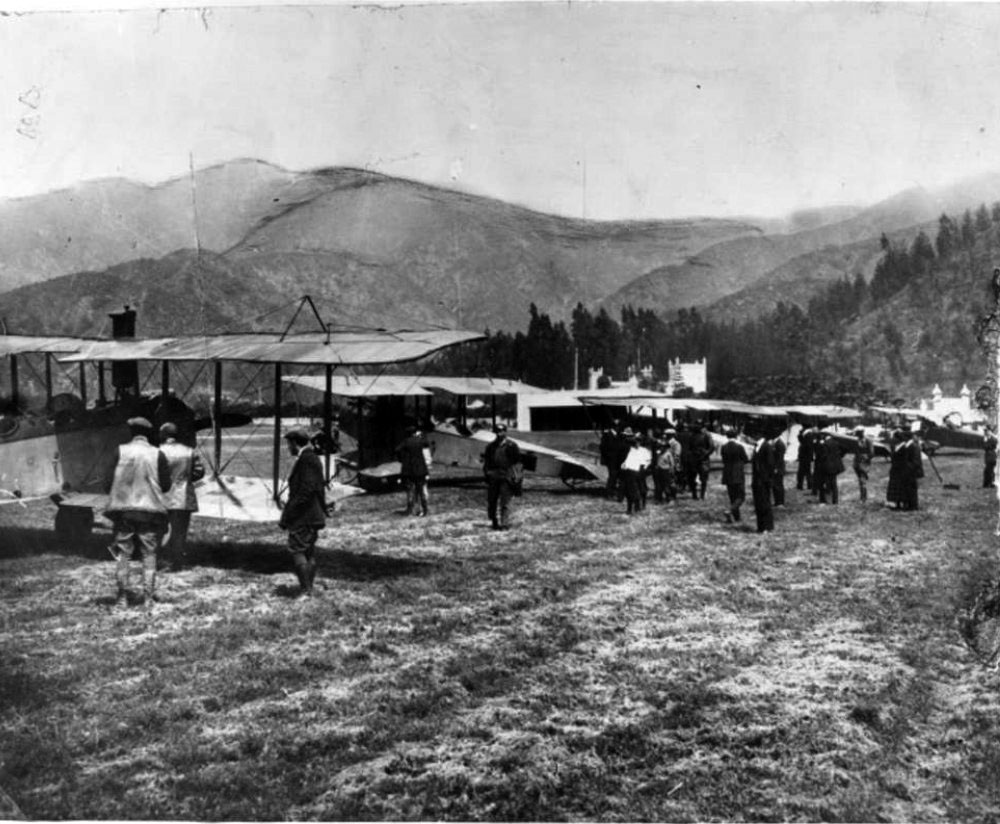 |
|
| (1921)^*# – Several airplanes and guests arriving at Brand's fly-in luncheon party on April 1, 1921. El Miradero Mansion is seen in the background. |
Historical Notes Brand Field was no longer depicted on a 1931 street map, but “Brand Park” was depicted, so the airfield may have ceased operation by that point.*#*# |
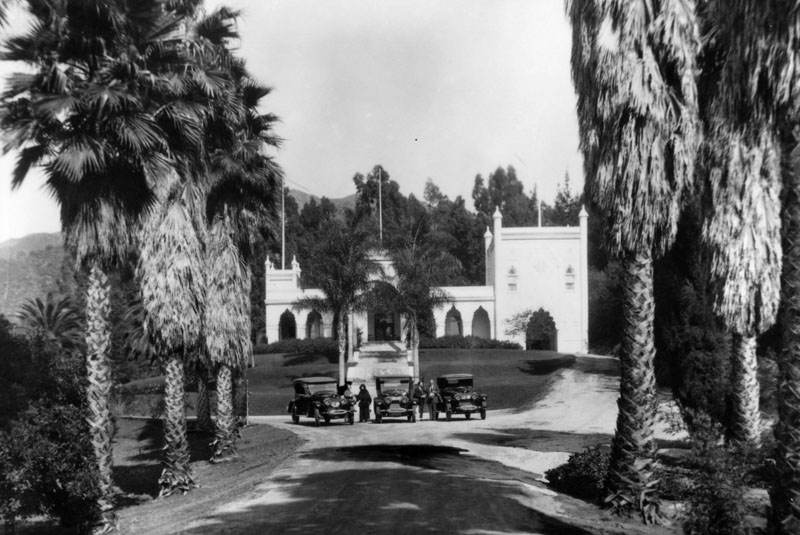 |
|
| (ca. 1920)^ - View of El Miradero and estate grounds, once home to Leslie C. Brand. Three vehicles are seen parked next to one another where the driveway and path to the front door meet. Four people, three men and one woman, are standing next to the automobiles. |
Historical Notes It was stated in Brand's will that El Miradero would be bequeathed to the city upon his wife's death, on the condition that the property be used exclusively for a public park and library. Mrs. Mary Louise Brand retained rights of the residence from 1925, when Mr. Brand died, until her death in 1945.^ |
 |
|
| (ca. 1940s)#^^ - Postcard view of the entrance to El Miradero, the estate of Leslie C. Brand, located in Brand Park. |
Historical Notes In 1956 the mansion became the Brand Library, the art and music branch of the Glendale Public Library. The address is 1601 West Mountain Street, Glendale.^ |
* * * * * |
Please Support Our CauseWater and Power Associates, Inc. is a non-profit, public service organization dedicated to preserving historical records and photos. Your generosity allows us to continue to disseminate knowledge of the rich and diverse multicultural history of the greater Los Angeles area; to serve as a resource of historical information; and to assist in the preservation of the city's historic records.
|
More Historical Early Views
Newest Additions
Early LA Buildings and City Views
History of Water and Electricity in Los Angeles
* * * * * |
References anc Credits
* DWP - LA Public Library Image Archive
^ LA Public Library Image Archive
*^ Wikipedia
^* Glendale High School Home Page
*# Abandoned & Little-Known Airfields – Paul Freeman
#* Flickr.com: Glendale Public Library
#^ Pacific Electric Railway Historical Society
#+ Los Angeles River Flood of 1938
++ Early Glendale (Images of America)
#**Huntington Digital Library Archive
*^^LA Times: Webb's Department Store
+++Facebook: Vintage Glendale "The Jewel City"
^*^Nuestra Señora la Reina de los Ángeles: losangelespast.com
^^*Cinema Treasures: Palace Grand Theatre
***PhantomLosAngeles.blogspot.com: Glendale Southern Pacific Railroad
^x*Facebook.com: So. Calif. Historic Arrchitecture
^*#California State Library Image Archive
^##Metropolitan Transportation Library and Archive
+##Airport Journals: Grand Central Aiport
#^*Flickr.com: Michael Ryerson
##^CSUN Oviatt Library Digital Archives
##*OAC - Online Archive of California
^##^Glendale Historical Society
#+#+Glendale News-Press: Tropic
#*#^Brand Park and Studios: glendale.ca.us
***^CSUN Oviatt Library Digital Archives
#+++Facebook.com: West San Fernando Valley Then And Now
##^*Facebook.com: Classic Hollywood-Los Angeles-SFV
< Back
Menu
- Home
- Mission
- Museum
- Major Efforts
- Recent Newsletters
- Historical Op Ed Pieces
- Board Officers and Directors
- Mulholland/McCarthy Service Awards
- Positions on Owens Valley and the City of Los Angeles Issues
- Legislative Positions on
Water Issues
- Legislative Positions on
Energy Issues
- Membership
- Contact Us
- Search Index